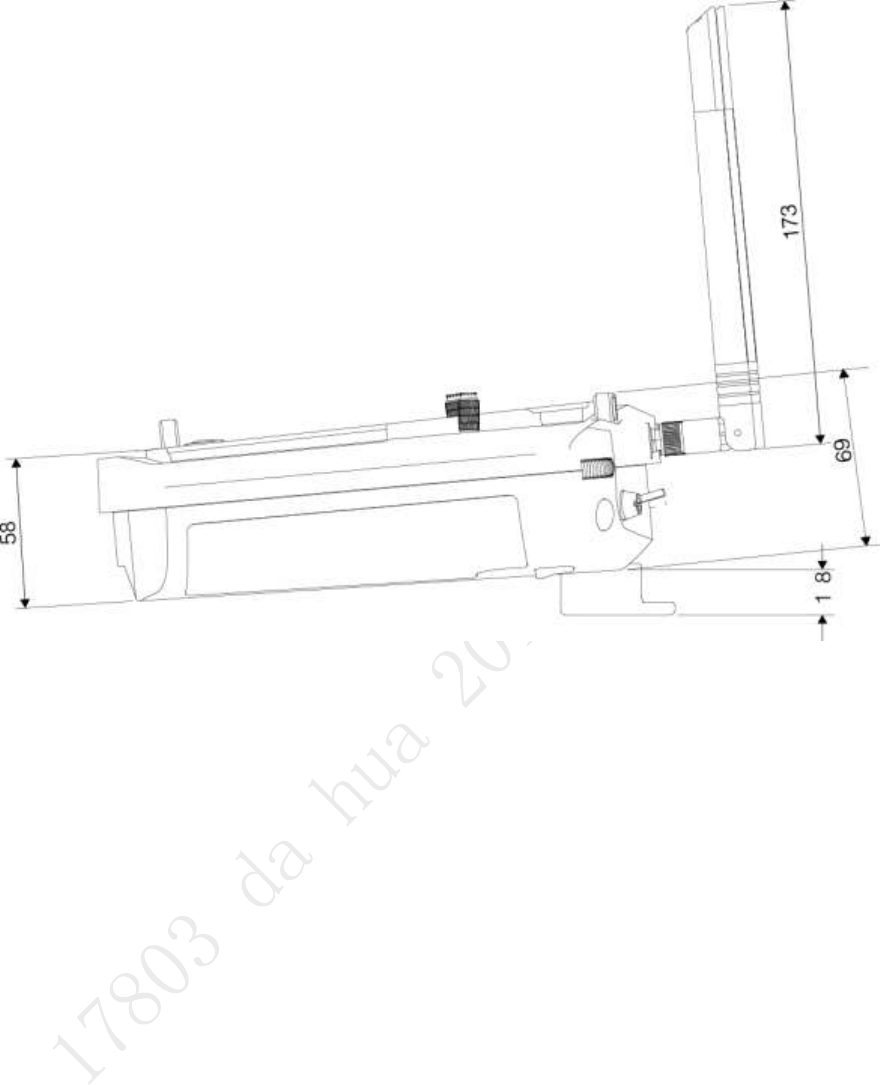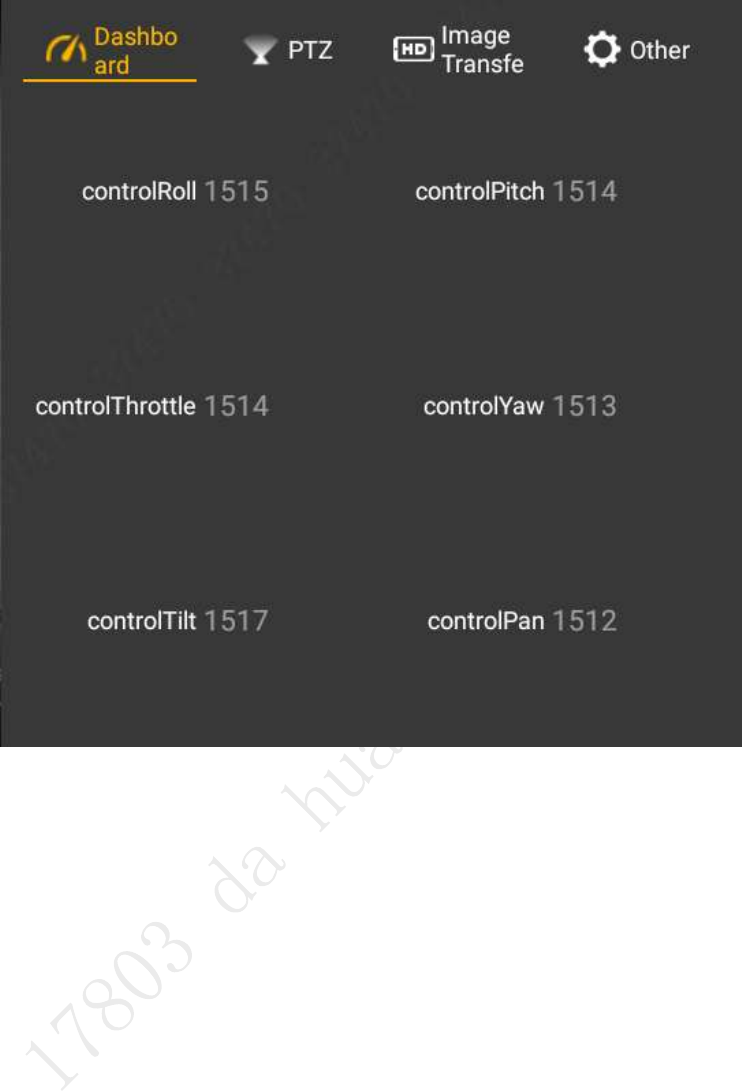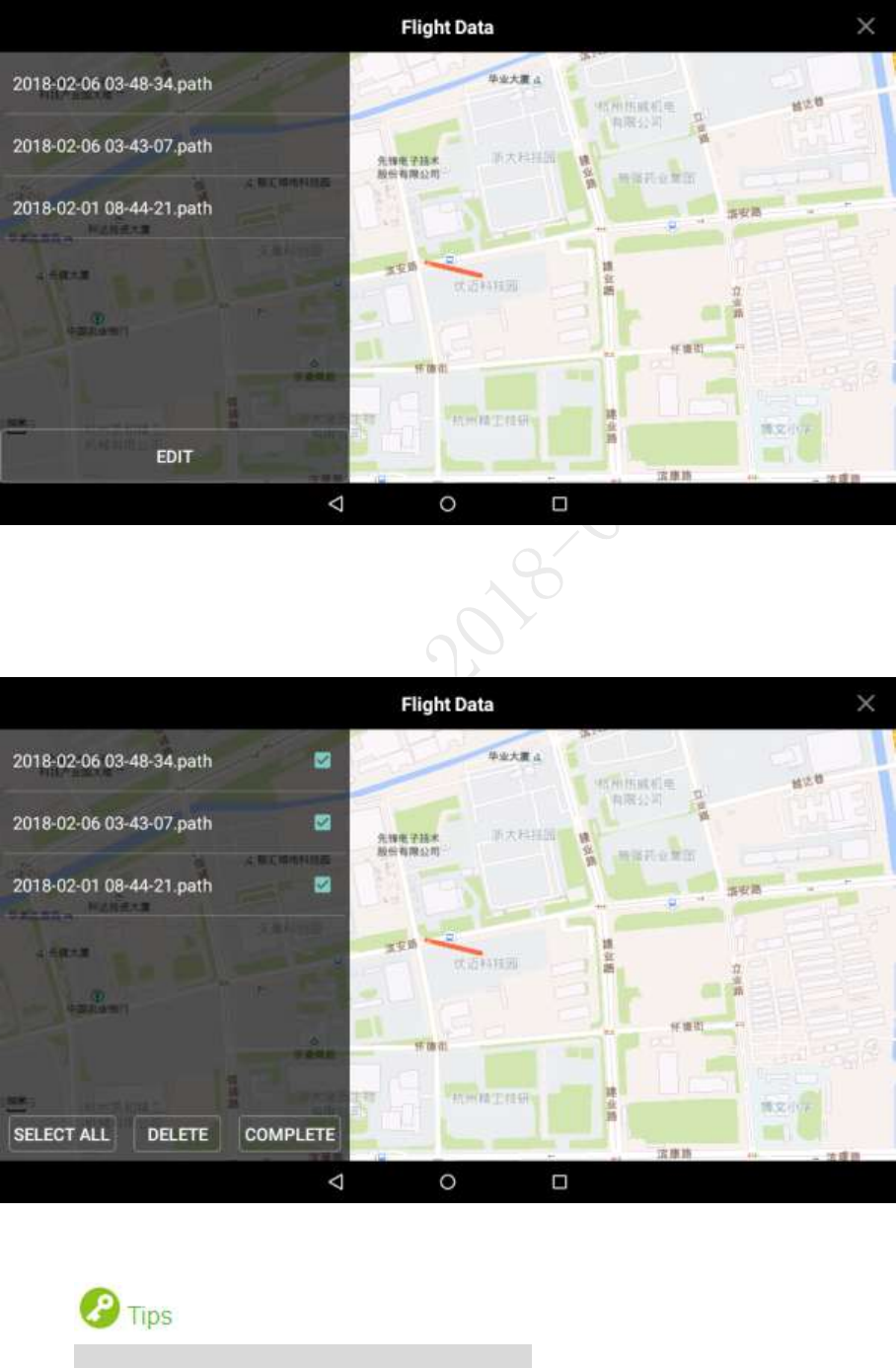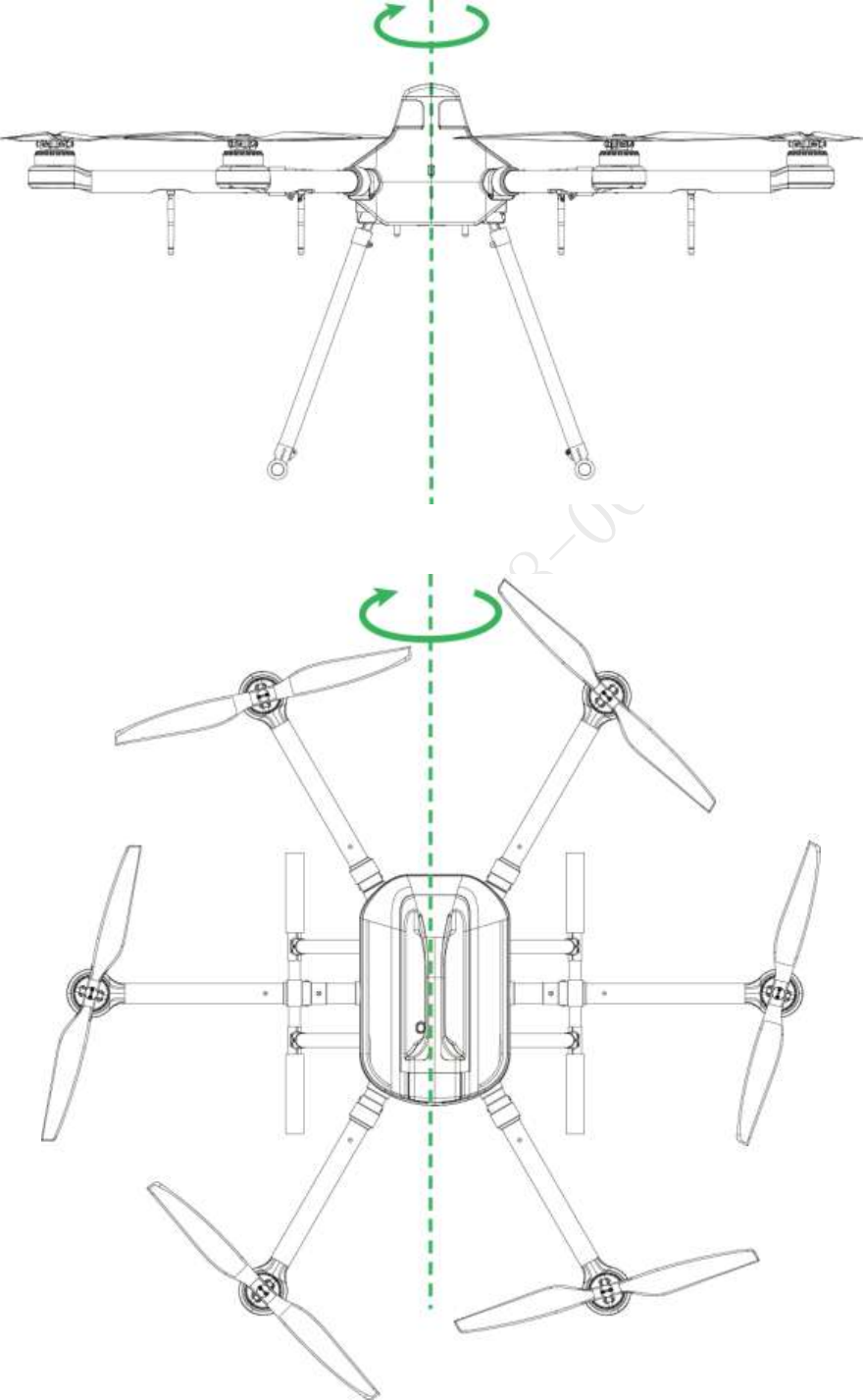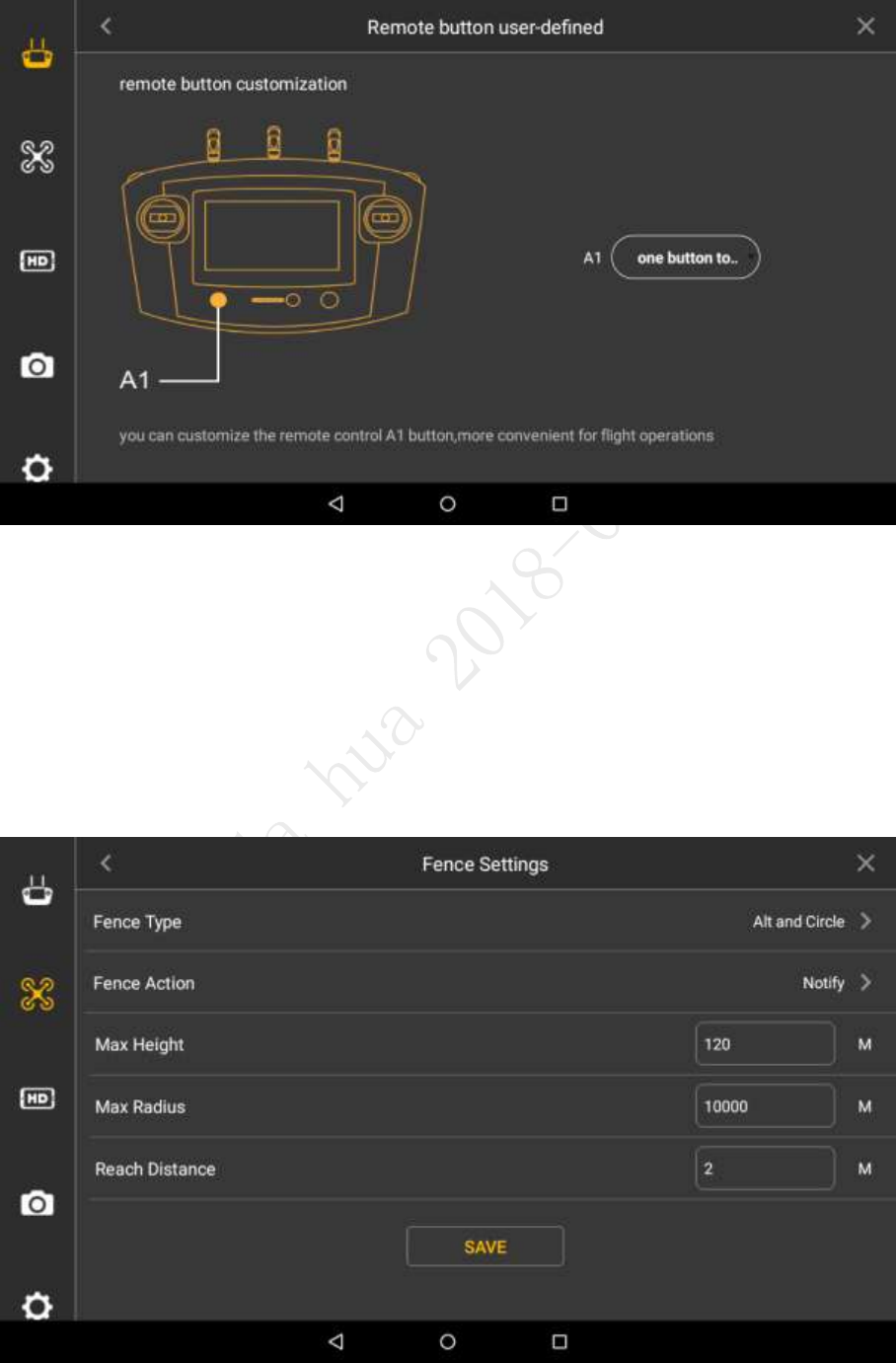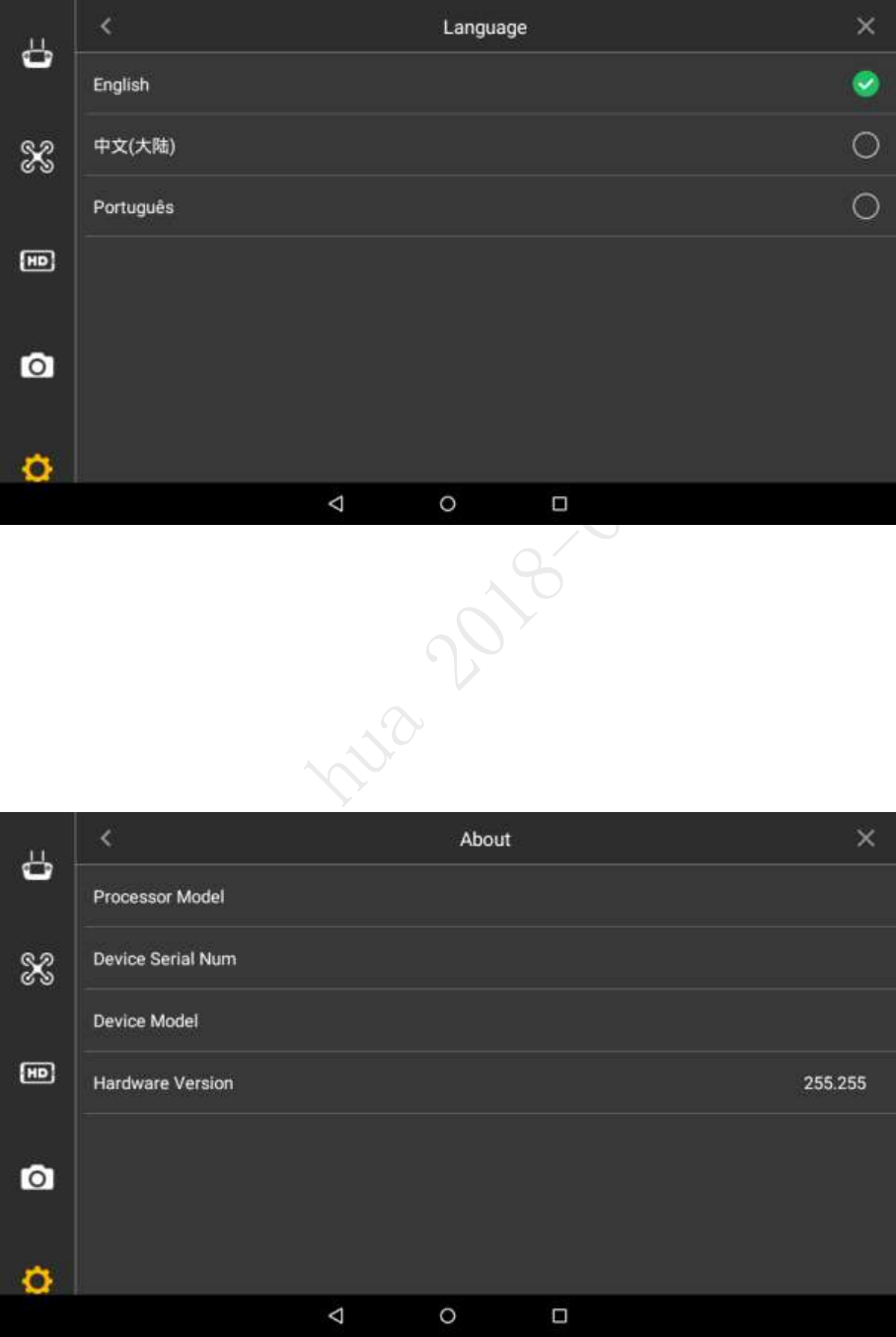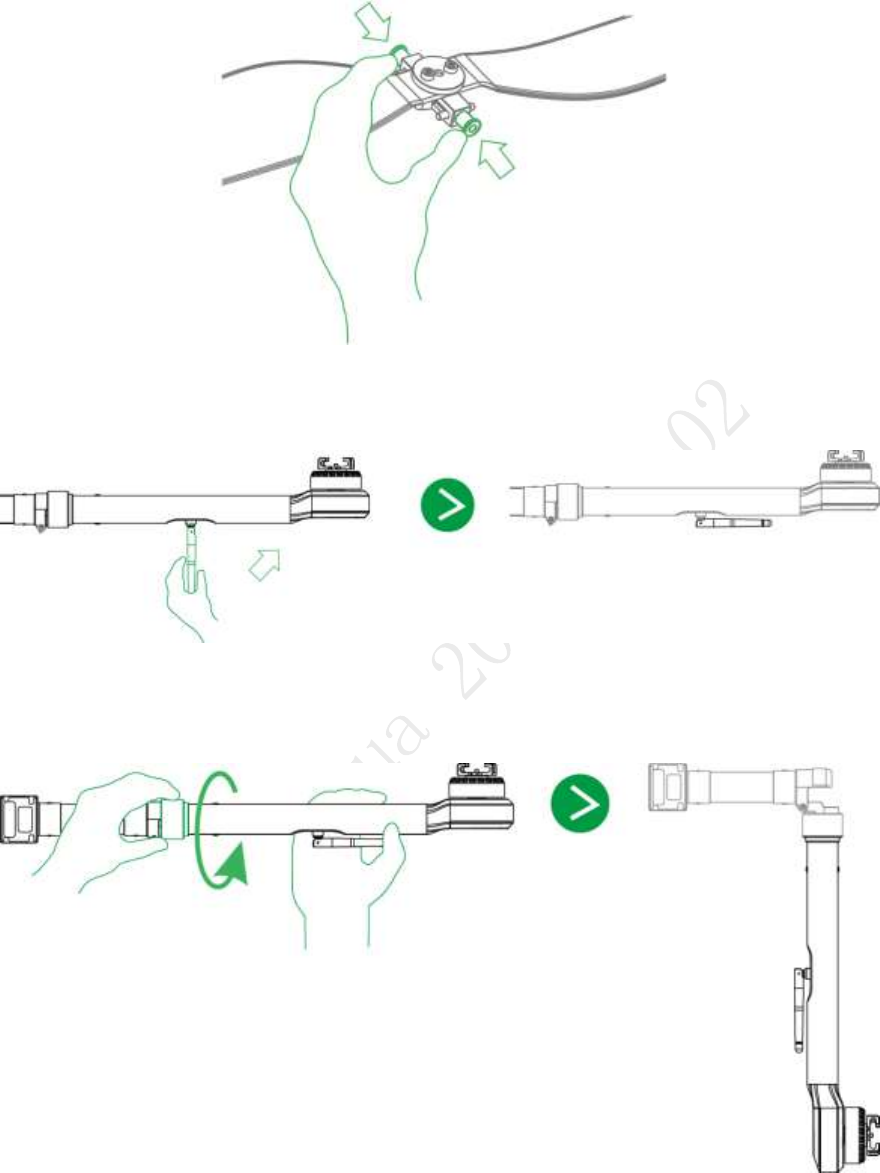Zhejiang Dahua Vision Technology X1100 NAVIGATOR X1100 User Manual
Zhejiang Dahua Vision Technology Co., Ltd NAVIGATOR X1100
User Manual
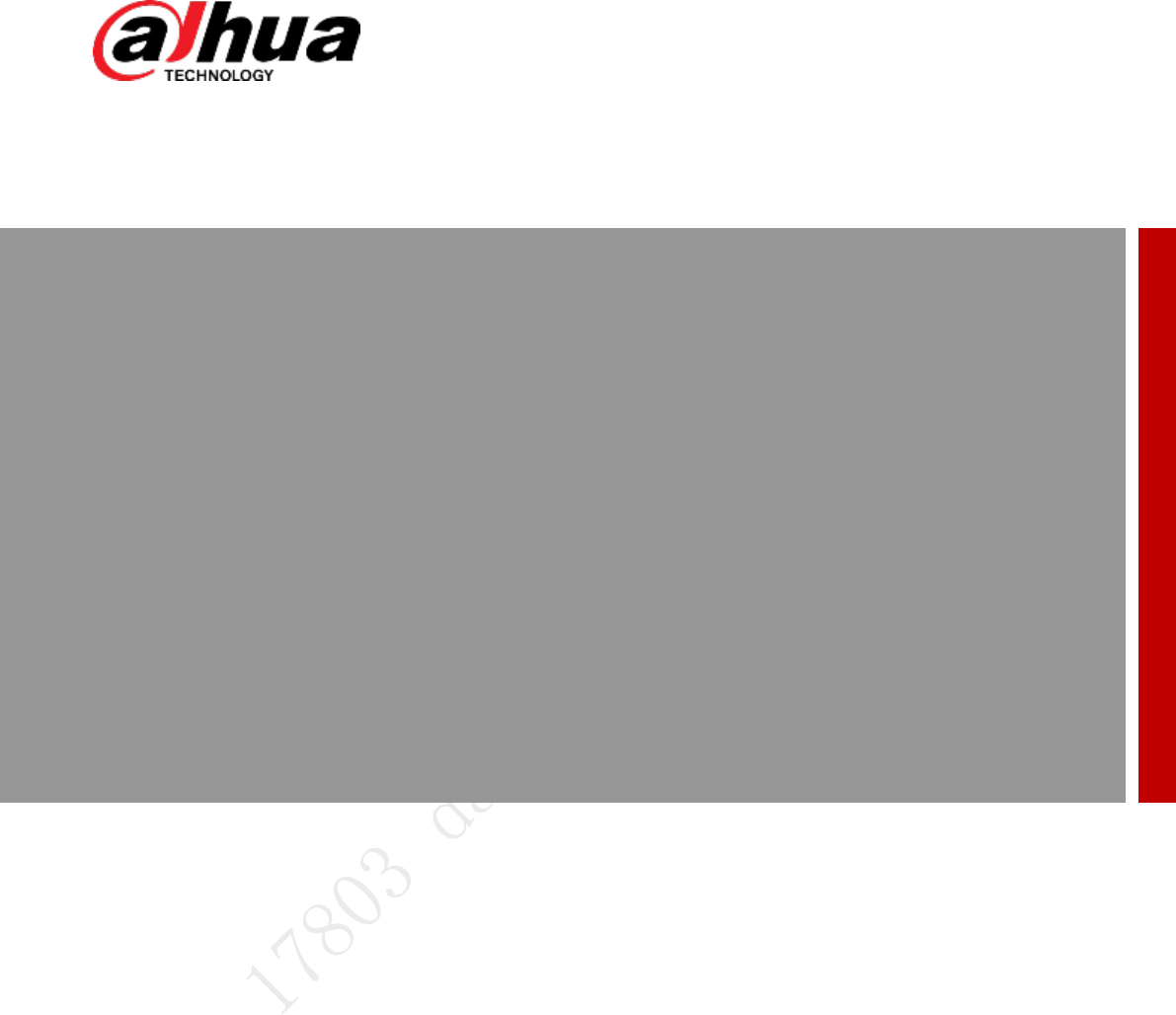
NAVIGATOR X1100
User’s Manual
V1.0.0
ZHEJIANG DAHUA VISION TECHNOLOGY CO.,LTD
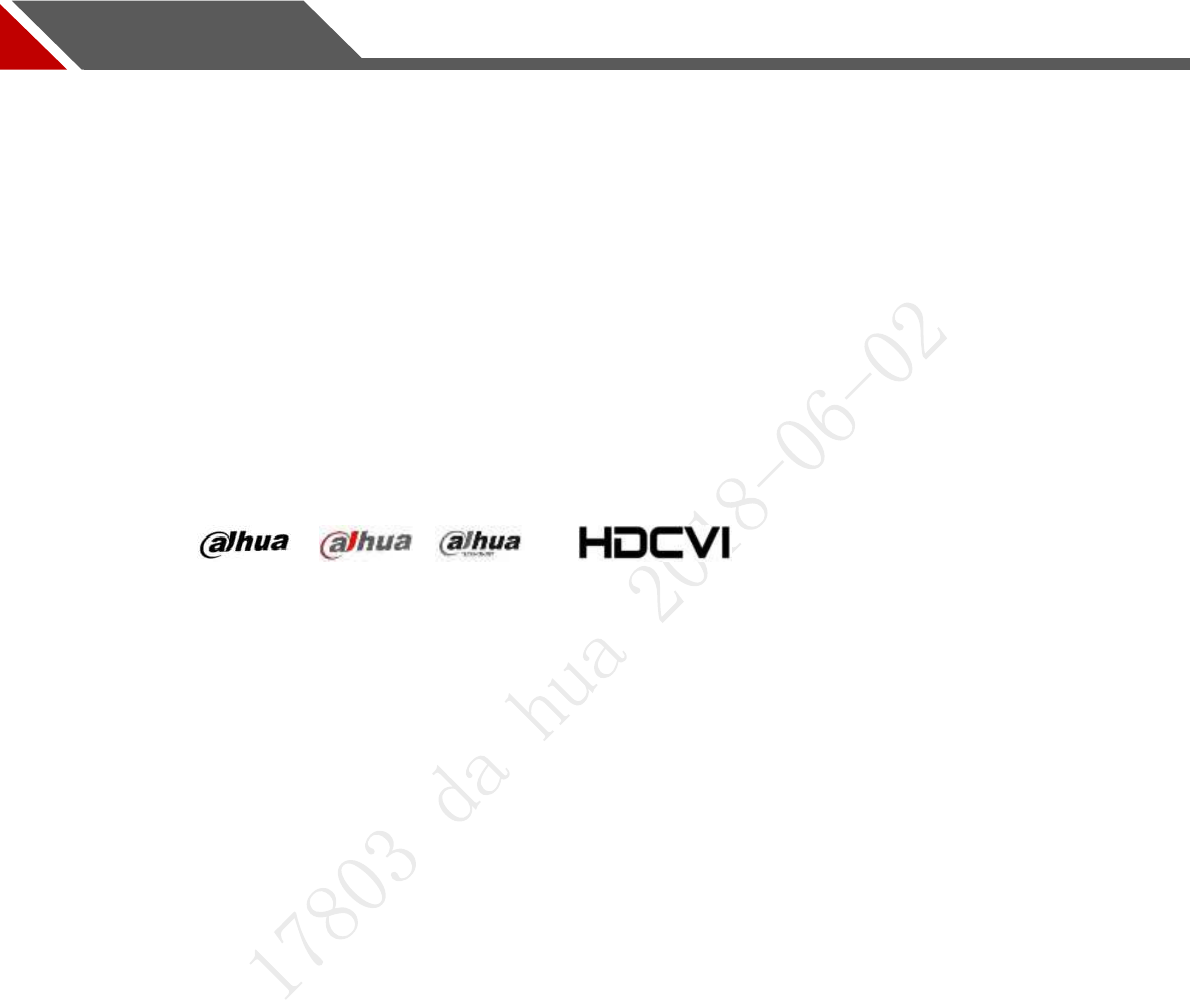
I
Legal Statement
Copyright
© 2018 ZHEJIANG DAHUA VISION TECHNOLOGY CO.,LTD. All rights reserved.
Any or full contents of the user’s manual cannot be copied, transmitted, distributed, partially or
wholly, by any means, without the prior written notice of ZHEJIANG DAHUA VISION
TECHNOLOGY CO.,LTD.
Dahua or the third party may reserve the right of the product described in this user’s manual.
Without the prior written approval of the corresponding party, any person cannot (including but
not limited to) copy, distribute, amend, excerpt, reverse compile, disassemble, decode, reverse
engineering, rent, transfer or sublicense the software.
Trademark
, , and are the trademarks or registered
trademarks of Dahua and its branch companies in various jurisdictions. Other trademarks or
company names mentioned are the properties of their respective owners.
Update and Modification
In order to enhance the product security and provide better user experience, Dahua may
improve the product via software auto update, but Dahua doesn't need to inform in
advance and isn't liable to any responsibility.
Dahua reserves the right to modify any information in this document at any time; the
modified contents will be added to the new version without prior announcement. There
may be minor differences about some product functions after it is updated.
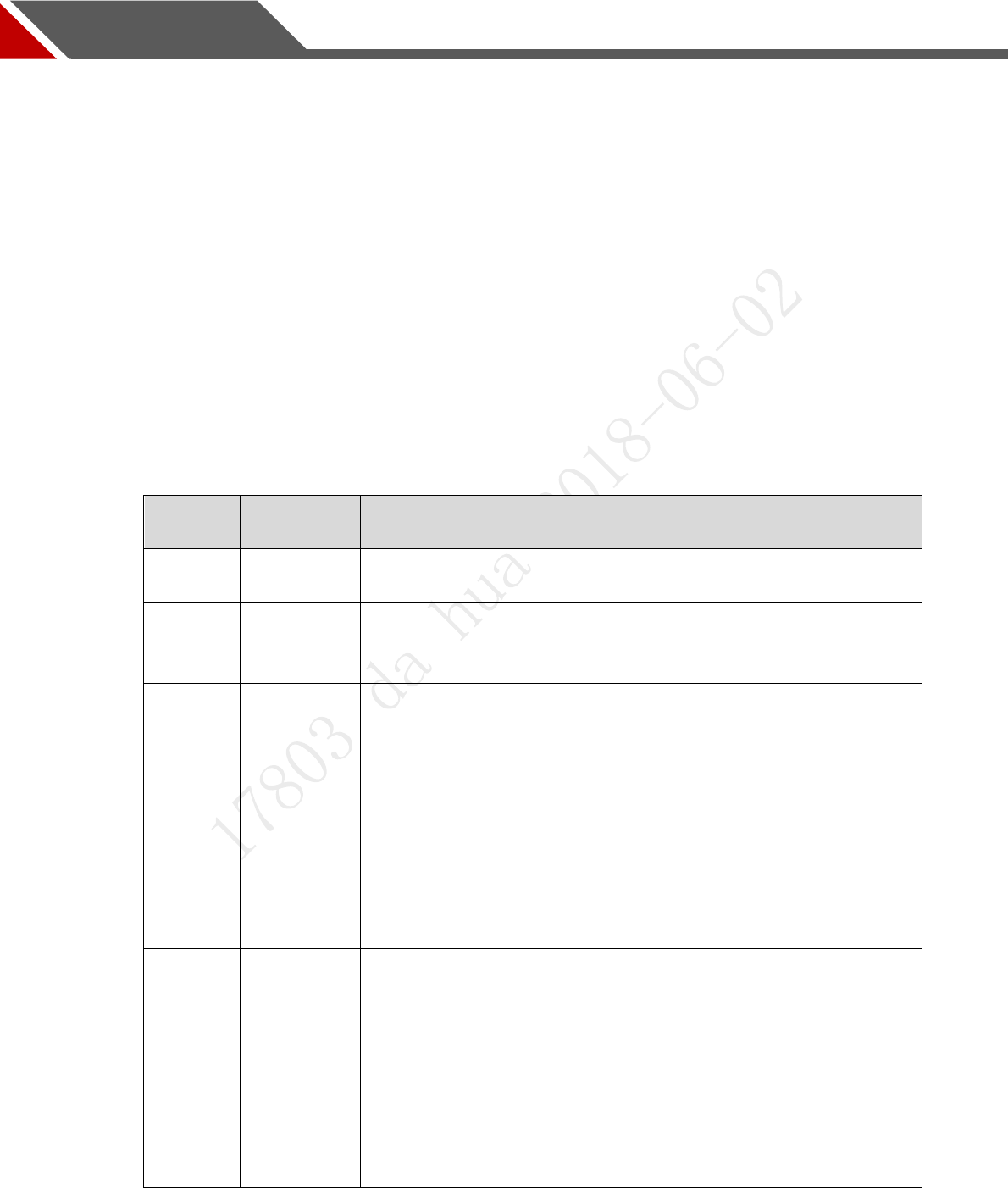
II
Preface
Document Overview
The manual is to comprehensively introduce function features, structure parameters,
installation, dismounting and flight guide etc. of the product.
Applied Model
X1100
Application Object
End users.
Reading Guide
Chapter
No.
Chapter
Name
Main Content
1
Product
Overview
It is to introduce the function features and application scenarios of the
product.
2
Product
Component
It is to comprehensively introduce main components of the product.
Read the chapter before use; understand product structure and
application methods of main components.
3
Flight
Preparation
It is to elaborate the complete flow of aircraft unlock before takeoff.
Strictly conform to the installation debugging sequence of the
chapter, install each component and make initial debugging before
first use.
If it is not the first time to use the device, you can select the
installation content according to the dismounting situation last time.
However, confirm that all the components (unnecessary steps
excluded) listed in the chapter have been stably installed. Please
conform to the operating steps in this chapter strictly and follow the
operating sequence.
4
Enable
Flight
It is to elaborate the complete flow of aircraft formal launch, landing
and locking. Complete the preparation steps listed in Chapter 3.
Confirm that all the inspection items, including environment and the
device itself, conform to flight requirements before enabling flight.
Please operate by strictly conforming to the steps described in the
chapter; the operation sequence can't be reversed.
5
End Flight
It is to elaborate the operation steps after aircraft landing.
Please operate by strictly conforming to the steps described in this
chapter; the operation sequence can't be reversed.

III
6
Upgrade
It is to introduce upgrade methods and points of attention.
7
Appendix 1
It is to introduce the technical parameters.
8
Appendix 2
It is to introduce the indicator definition of the aircraft.
9
Appendix 3
It is to introduce the matching method among the components.
10
Appendix 4
It is to list possible problems and solutions when using the product.
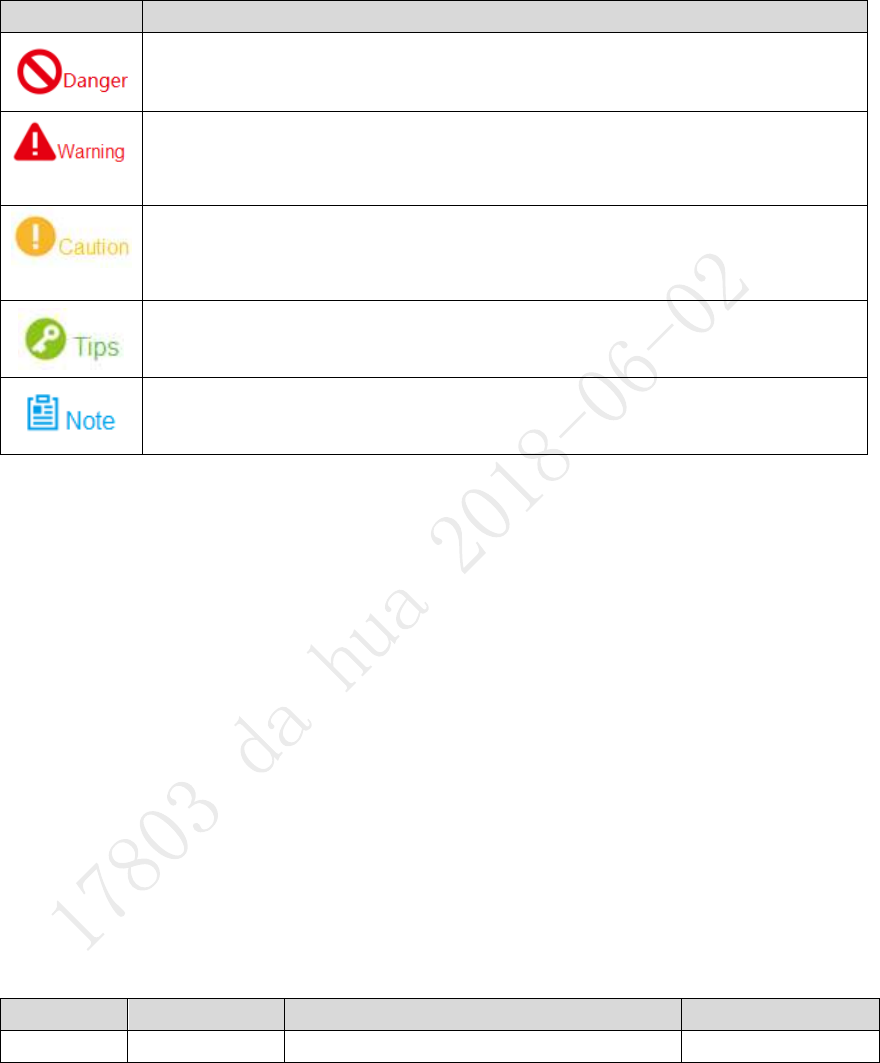
IV
Symbol Definition
The following symbol may appear in the document. Please refer to the table below for the
respective definition.
Symbol
Note
It indicates a potentially hazardous situation which, if not avoided, could
result in death or serious injury.
It indicates a moderate or low level of potential danger which, if not avoided,
could result in minor or moderate injury.
It indicates a potential risk that, if ignored, could result in damage to device,
degraded performance, or unpredictable results.
It means that it can help you to solve some problems or save your time.
It means the additional information, which is the emphasis and supplement
of the main body.
Document Material
The product includes the following document materials. Please search according to your
requirements:
Quick Start Guide
It applies to the first simple flight. Please refer to User’s Manual for operation details when it is used
for the second time or it has to use some other advanced functions.
Check the paper material in the packaging box or log in www.dahuasecurity.com to obtain the
User’s Manual.
User’s Manual (this document)
It comprehensively introduces the product function features, structure parameters, installation,
dismounting and flight guide etc.
Log in www.dahuasecurity.com to obtain the User’s Manual.
Revision Record
No.
Version No.
Revision Content
Release Date
1
V1.0.0
First release
2018.02.13
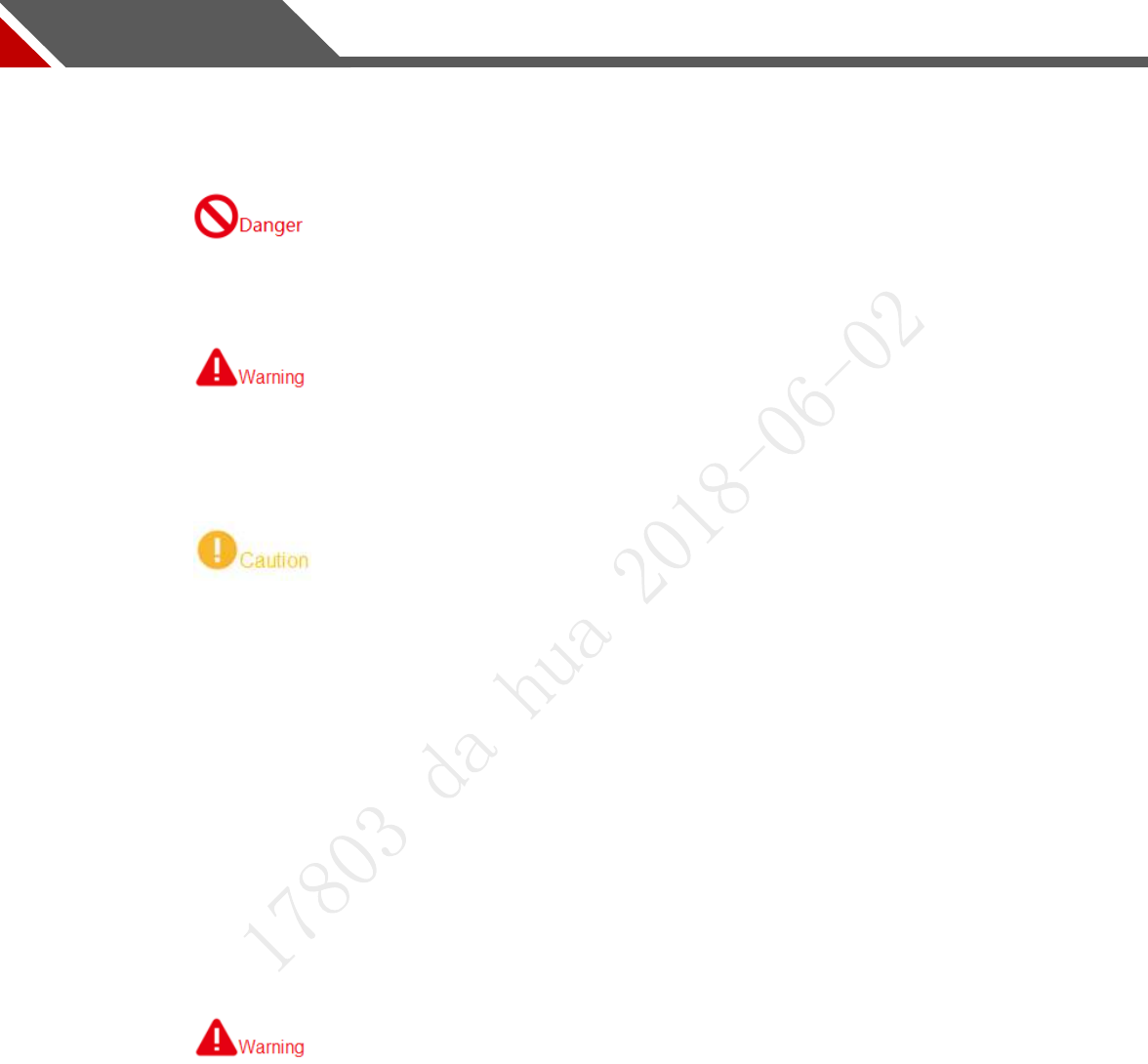
V
Important Safeguards and Warnings
The following description is the correct application method of the device. Please read the
manually carefully before use, in order to prevent danger and property loss. Strictly conform to
the manual during application and keep it properly after reading.
Please operate the aircraft in the environment which meets flight conditions, and keep
away from no-fly zone.
After unlocking, operators shall keep at least 5m away from the aircraft.
Please transport, use and store the product and all its components in the environment
which satisfies the requirements.
Please strictly conform to operation flows described in the manual when dismantling the
device. Please do not dismantle other components privately.
Please do not touch the lens of PTZ camera directly. Use hair drier to remove the dust or
dirt from the lens surface.
Please operate the device by strictly conforming to the steps described in the manual; the
operation sequence can’t be reversed.
Get to know local laws and regulations before using the aircraft. Please apply to local
authorities for flight permission if necessary.
For the first flight, please adopt loiter mode (before takeoff, it is suggested that GPS
satellites are ≥12 and horizontal dilution of precision (HDOP) is ≤1).
Please make sure that the device antenna has been properly installed before enabling the
power of remote control or aircraft. Otherwise, it may cause damages to internal module or
shorten the control distance.
Flight Environment
Please make flight in the environment which meets the following conditions:
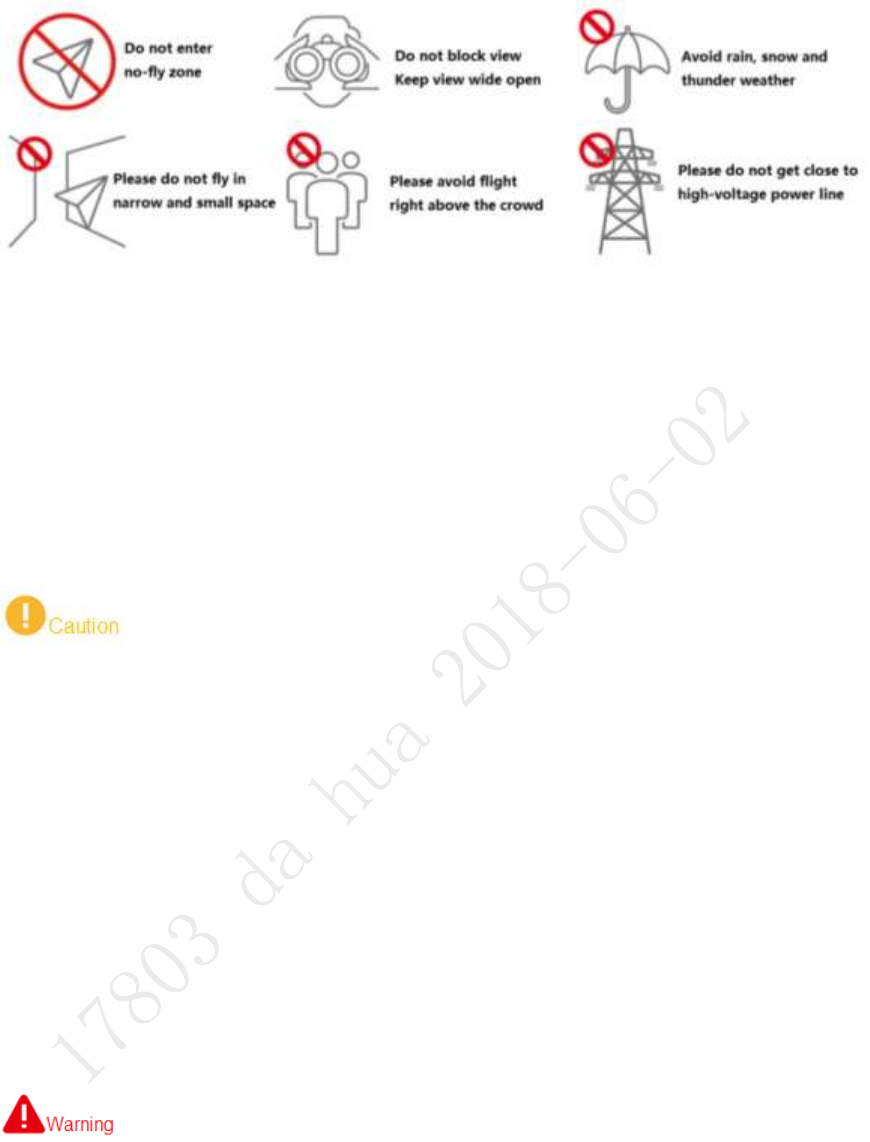
VI
Keep away from no-fly zone; please do not enter no-fly zone.
Keep view wide open; make sure the device is flying within field of view; please do not
block field of view.
Please do not fly the aircraft in rain, snow and thunder weather.
Please do not fly in narrow and small space.
Try not to fly right above the crowd, in order to prevent personal injury.
Please do not get close to high-voltage power line. Keep more than 10m distance.
Power Requirement
The product shall use electric wires (power wires) recommended by this area, which shall
be used within its rated specification!
Products with category I structure shall be connected to grid power output socket, which is
equipped with protective grounding.
Please conform to local electrical safety standards strictly.
Before operation, please check whether power supply is correct.
Please use power supply that meets SELV (safety extra low voltage) requirements, and
supply power with rated voltage that conforms to Limited Power Source in IEC60950-1. For
specific power supply requirements, please refer to device labels.
Prevent power cord from being trampled or pressed, especially the plug, power socket and
the junction extruded from the device.
Battery Points of Attention
It has to use the exclusive power adapter provided by Dahua Technology to charge the
device. Otherwise, it may damage the battery or lead to other unpredictable
consequences.
Charge the device at a temperature between 0 and 50℃.
Distinguish positive and negative poles when charging the device, to prevent short circuit.
Charge and discharge at least once every month; prohibit storing the device without
electricity.
Please do not place the device close to fire source or inflammables.
Please do not charge and discharge the device in unattended conditions.
Please do not use undesignated battery to the device.

VII
Please do not dismantle and destroy the battery without permission; water is not allowed to
enter the device; man-made damages are not covered by warranty.
Please do not throw the battery into fire or expose it to high-temperature environment.
Please do not dismantle, modify or deform the battery.
Avoid short circuit between positive and negative contacts (please do not place the battery
together with the objects such as necklace and hairpin etc. when carrying or storing the
battery).
Please replace new battery timely when it is damaged. Please contact local relevant
agency to deal with damaged battery properly, in order to prevent accidents.
Please charge the battery or discharge it to 50%~60% remaining capacity if it won't be
used for a long time, and place it in a dry and cool environment.
If the battery leaks and the liquid enters eyes accidentally, please do not rub your eyes;
wash your eyes with clean water and see a doctor immediately.
It is normal that the battery heats up after it is running for a period of time, because the
discharge power is quite big.
It is normal that the battery heats up when it is being charged.
The cycle times of power battery is 300 in normal application situation.
During charging of power battery, charging is completed when the charger displays “FULL”
and beeps continuously. Don’t take down batteries before charging is completed.
Application Environment Requirements
Please do not aim the PTZ at strong light (such as lighting, sunlight and so on).
Please transport, use and store the device within the allowed humidity and temperature
range.
Please do not let any liquid flow into the device.
Please do not block the device ventilation.
Please do not press, vibrate or soak the device.
Please pack the device with original package or material with equivalent quality.
This device complies with Part 15 of the FCC Rules. Operation is subject to the following
two conditions: (1) this device may not cause harmful interference, and (2) this device must
accept any interference received, including interference that may cause undesired
operation.
Caution: The user is cautioned that changes or modifications not expressly approved by
the party responsible for compliance could void the user's authority to operate the
equipment.
Note: This equipment has been tested and found to comply with the limits for a Class B
digital device, pursuant to part 15 of the FCC Rules. These limits are designed to provide
reasonable protection against harmful interference in a residential installation. This
equipment generates uses and can radiate radio frequency energy and, if not installed and
used in accordance with the instructions, may cause harmful interference to radio
communications. However, there is no guarantee that interference will not occur in a
particular installation. If this equipment does cause harmful interference to radio or
television reception, which can be determined by turning the equipment off and on, the
user is encouraged to try to correct the interference by one or more of the following

VIII
measures:
—Reorient or relocate the receiving antenna.
—Increase the separation between the equipment and receiver.
—Connect the equipment into an outlet on a circuit different from that to which the receiver
is connected.
—Consult the dealer or an experienced radio/TV technician for help.
FCC RF Radiation Exposure Statement:
This equipment complies with FCC radiation exposure limits set forth for an uncontrolled
environment. This equipment should be installed and operated with a minimum distance of
20cm between the radiator and any part of your body.
Operation and Maintenance Requirements
Please do not dismantle the device privately.
Please do not touch sensor CCD or CMOS directly; use hair drier to remove dust or dirt
from the lens surface.
Please use soft dry cloth or clean soft cloth to dip a little mild detergent to clean the device.
Please do not touch or wipe the lens surface directly.
Please use the accessories provided by manufacturer and it shall be installed and repaired
by professional staffs.
Please avoid laser beam radiation to the surface when using laser beam device.
Please do not provide two or more power supply modes to the device at the same time;
otherwise, it may damage the device.
Max 1 aircraft is allowed to fly in the same area at the same time.
Please make sure that there is no occlusion above the flight.
Privacy Protection Notice
As the device user or data controller, you might collect personal data of others' such as face,
fingerprints, car plate number, Email address, phone number, GPS and so on. You need to be
in compliance with the local privacy protection laws and regulations to protect the legitimate
rights and interests of other people by implementing measures include but not limited to:
providing clear and visible identification to inform data subject the existence of surveillance
area and providing related contact.
About the Manual
The Manual is for reference only. If there is inconsistency between the Manual and the
actual product, the actual product shall prevail.
We are not liable for any loss caused by the operations that do not comply with the Manual.
The Manual would be updated according to the latest laws and regulations of related
regions. For detailed information, see the paper User's Manual, CD-ROM, QR code or our
official website. If there is inconsistency between paper User's Manual and the electronic
version, the electronic version shall prevail.
All the designs and software are subject to change without prior written notice. The product

IX
updates might cause some differences between the actual product and the Manual. Please
contact the customer service for the latest program and supplementary documentation.
There still might be deviation in technical data, functions and operations description, or
errors in print. If there is any doubt or dispute, please refer to our final explanation.
Upgrade the reader software or try other mainstream reader software if the Guide (in PDF
format) cannot be opened.
All trademarks, registered trademarks and the company names in the Manual are the
properties of their respective owners.
Please visit our website, contact the supplier or customer service if there is any problem
occurred when using the device.
If there is any uncertainty or controversy, please refer to our final explanation.

X
Table of Contents
Legal Statement ....................................................................................................................................... I
Preface ..................................................................................................................................................... II
Important Safeguards and Warnings ..................................................................................................... V
1 Product Introduction ............................................................................................................................. 1
1.1 Overview ....................................................................................................................................... 1
1.2 Functional Features ...................................................................................................................... 1
2 Structure ................................................................................................................................................. 4
2.1 Aircraft ........................................................................................................................................... 4
2.1.1 Product Dimensions............................................................................................................ 4
2.1.2 Structural Component ......................................................................................................... 6
2.2 Airborne Device............................................................................................................................. 7
2.2.1 The 2 MP Visible Light PTZ Camera .................................................................................. 8
2.2.2 Structural Component of 2 MP Visible Light PTZ Camera ............................................... 10
2.3 Remote Control ............................................................................................................................ 11
2.3.1 Dimensions ........................................................................................................................ 11
2.3.2 Structural Component ....................................................................................................... 12
2.3.3 Buttons .............................................................................................................................. 16
2.3.4 Operation Interface ........................................................................................................... 18
3 Flight Preparation ................................................................................................................................ 27
3.1 Unpack ........................................................................................................................................ 27
3.2 Check Remaining Power ............................................................................................................ 27
3.2.1 Aircraft ............................................................................................................................... 28
3.2.2 Remote Control ................................................................................................................. 29
3.3 Charging ...................................................................................................................................... 30
3.3.1 Aircraft Battery Charging .................................................................................................. 30
3.3.2 Remote Control Charging ................................................................................................. 31
3.4 Prepare Airborne Device ............................................................................................................. 31
3.4.1 Dismantle PTZ Camera .................................................................................................... 32
3.4.2 Install PTZ Camera ........................................................................................................... 32
3.5 Prepare Aircraft ........................................................................................................................... 33
3.5.1 Unfold Arm ........................................................................................................................ 33
3.5.2 Open Antenna ................................................................................................................... 33
3.5.3 Install Aircraft Battery ....................................................................................................... 34
3.6 Prepare Remote Control ............................................................................................................. 34
3.6.1 Install Micro SD Card ........................................................................................................ 34
3.6.2 Open Antenna ................................................................................................................... 35
3.6.3 Enable Remote Control Power ......................................................................................... 35
3.6.4 Confirm Remote Control Mode ......................................................................................... 36
3.6.5 Set Quick Operation ......................................................................................................... 36
3.7 Enable Aircraft Power ................................................................................................................. 42
3.8 Check and Debugging ................................................................................................................ 42

XI
3.8.1 Remote Control Calibration .............................................................................................. 43
3.8.2 Accelerometer Calibration ................................................................................................ 43
3.8.3 Initialization Failure ........................................................................................................... 44
3.8.4 Geomagnetic Abnormity ................................................................................................... 45
3.8.5 GPS Satellites Insufficiency .............................................................................................. 47
3.9 Install Propellers.......................................................................................................................... 47
4 Enable Flight ........................................................................................................................................ 49
4.1 Flight Mode ................................................................................................................................. 49
4.2 Manual Mode .............................................................................................................................. 50
4.2.1 Introduction to Manual Flight Flow ................................................................................... 50
4.2.2 Unlock Flight Control ........................................................................................................ 50
4.2.3 Manual Takeoff ................................................................................................................. 51
4.2.4 Manual Flight Control ....................................................................................................... 52
4.2.5 Manual RTH and Landing ................................................................................................. 53
4.2.6 Manual Locking ................................................................................................................. 54
4.3 Intelligent Mode ........................................................................................................................... 55
4.3.1 Intelligent Flight Mode ...................................................................................................... 55
4.3.2 Intelligent Locking Mode ................................................................................................... 59
4.3.3 Intelligent Operation.......................................................................................................... 60
4.4 Intelligent Protection Mechanism ................................................................................................ 62
4.4.1 Low Battery ....................................................................................................................... 62
4.4.2 Out of Control ................................................................................................................... 62
4.5 Remote Control Setting ............................................................................................................... 62
4.5.1 Remote Button User-defined ............................................................................................ 62
4.5.2 Flight Control Settings ...................................................................................................... 63
4.5.3 Preview Settings ............................................................................................................... 66
4.5.4 Camera Settings ............................................................................................................... 67
4.5.5 General Settings ............................................................................................................... 70
5 End Flight ............................................................................................................................................. 75
5.1 Turn off Power ............................................................................................................................. 75
5.2 Remove Aircraft Battery .............................................................................................................. 76
5.3 Dismantle Airborne Device ......................................................................................................... 77
5.4 Fold Aircraft ................................................................................................................................. 77
5.5 Copy Video of Camera Micro SD Card ....................................................................................... 79
5.6 Remove Other Components ....................................................................................................... 79
6 Upgrade and Update......................................................................................................................... 80
6.1 Firmware Update......................................................................................................................... 80
6.2 Remote Control Update .............................................................................................................. 80
6.2.1 APP Update ...................................................................................................................... 80
6.2.2 Download and Update Offline Map of Remote Control .................................................... 81
Main Technical Parameters ............................................................................................. 82 Appendix 1
Aircraft State Indicator ................................................................................................... 85 Appendix 2
System Pairing .................................................................................................................. 87 Appendix 3
FAQ .................................................................................................................................... 89 Appendix 4
Appendix 4.1 FAQ and Solutions of Aircraft ..................................................................................... 89
Appendix 4.2 FAQ and Solutions of Remote Control ....................................................................... 89
Appendix 4.3 FAQ and Solutions of Airborne Device ....................................................................... 89

1
1 Product Introduction
1.1 Overview
This product is a hex-rotor drone designed for public security, transportation, firefighting, border
defense, agriculture, forest and energy source fields. It provides integrated solutions of aerial
video surveillance.
This product consists of aircraft, airborne device and remote control.
Aircraft: It consists of navigation system, flight control system and power system.
Airborne device: It consists of the PTZ control system and mission device.
Remote control: It consists of the remote control system, data chain and software.
1.2 Functional Features
Integrated Design
The aircraft adopts integrated design and neat appearance. Only the propeller shall be
dismantled and installed.
The remote control integrates the remote control and touch screen together. It is easy to
operate and has clear indicator.
Folded Packages
Arm can be folded repeatedly.
Antennas can be folded repeatedly, suitable to be carried, transported and stored.
Quick Dismantling
The propeller adopts quick dismantling structure.
It is easy to open or fold arm and antenna.
The PTZ camera adopts quick dismantling structure. Installation screws are secured on
the shock absorber plate, in order to prevent them from being lost.
HD Video
The shock absorber board and shock absorber ball work together to guarantee PTZ
camera stability.
Industrial 30x optical zoom visible light camera is optional, with professional HD video

2
effect.
IR thermal camera is optional, suitable for special environments such as fire scene or night
environment, so as to guarantee clear video and high restoration thermal images.
The remote control has snapshot button and record button, which are easy to operate and
instantly start snapshot and record function.
Accurate Positioning
Built-in GPS system ensures that positioning is accurate and real-time.
Wireless Transmission
Aircraft has 4 antennas. Connect the remote control and image transmission device to
send and receive radio wave signals.
The remote control has 3 antennas. Connect the aircraft to send and receive radio wave
signals.
Low Electric Quantity Protection
When electric quantity is lower than estimated safe return value, trigger low electric quantity
protection automatically, including alarm, return home and landing.
Intelligent Battery
Display remaining electric quantity: Battery has built-in power indicator light.
Balanced charging protection function: Automatically balance the battery cell voltage to
protect battery.
Overcharge protection function: Battery automatically stops charging when the voltage is
full.
Sleep protection function: Battery automatically goes to sleep state when there is no
operation within 5 minutes.
Charging temperature protection function: The battery charging temperature ranges from 0℃
to 50℃. Once the temperature is too high, battery automatically stops charging; otherwise,
it may result in battery damage.
Communication: The remote control can get remaining capacity and voltage information.
Flight Control
The aircraft adopts hex-rotor power system. It can switch among several flight modes and
control the flight direction flexibly.
Support 14,500g maximum take-off weight.
Support binocular obstacle avoidance, optical flow positioning, RTK and protection in case
of broken propeller.
Electronic Fence (e-fence)
Support e-fence function; prevent the aircraft from leaving the specified flight zone.

3
Support customized e-fence settings.
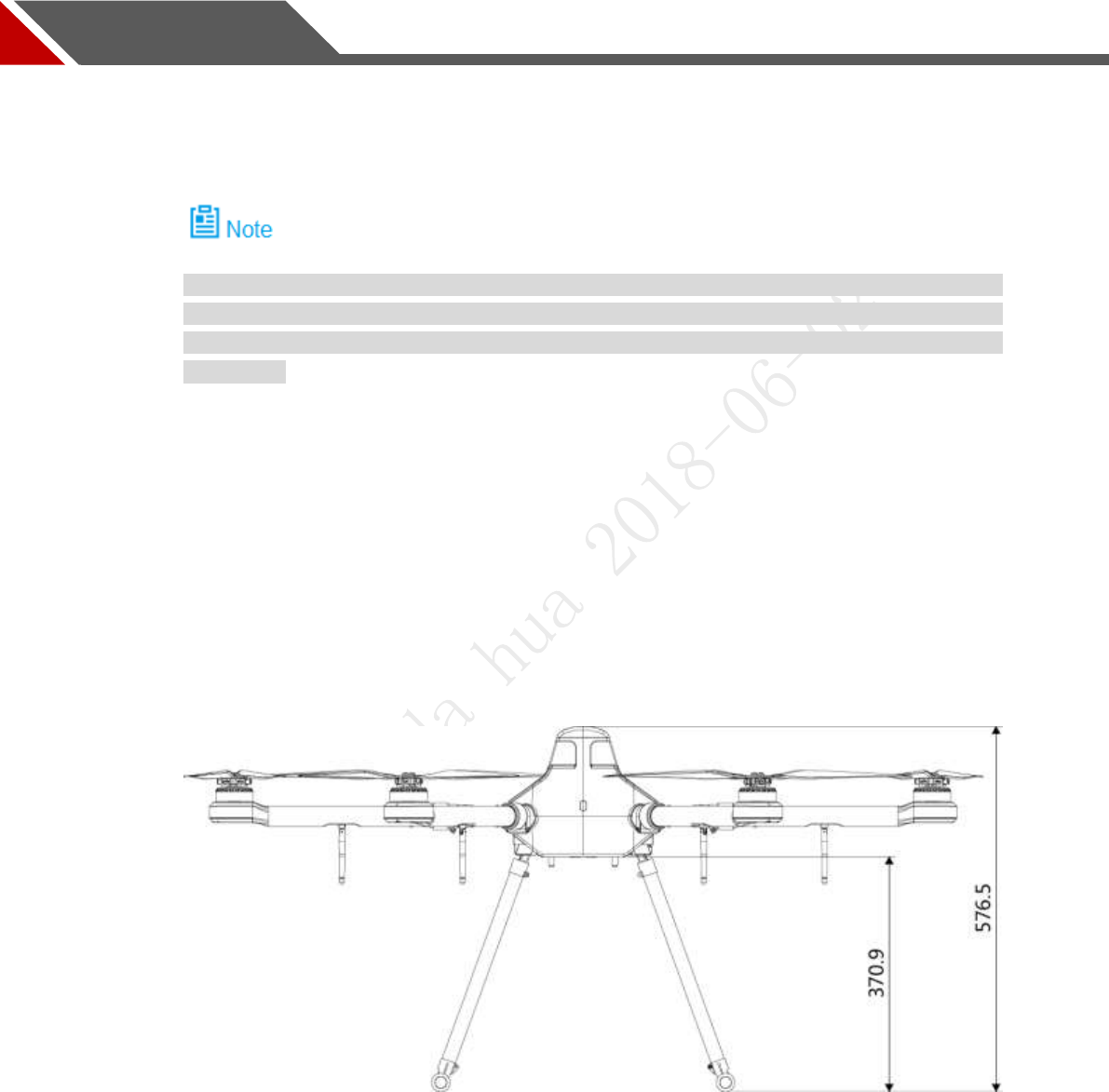
4
2 Structure
This product mainly consists of aircraft, airborne device and remote control. This chapter
introduces the structures of these 3 components. The detailed operations will be introduced in
“3Flight Preparation”.
All figures listed below and all dimensions listed here for reference only. The figure and the
dimensions may be slightly different from the user data due to measurement position,
measurement accuracy and position indication. Please refer to the actual product for detailed
information.
2.1 Aircraft
This section is introduced when the propeller is installed completely and the whole device is
unfolded. Please refer to Chapter 3 for details.
2.1.1 Product Dimensions
Unit is mm.
Figure 2-1
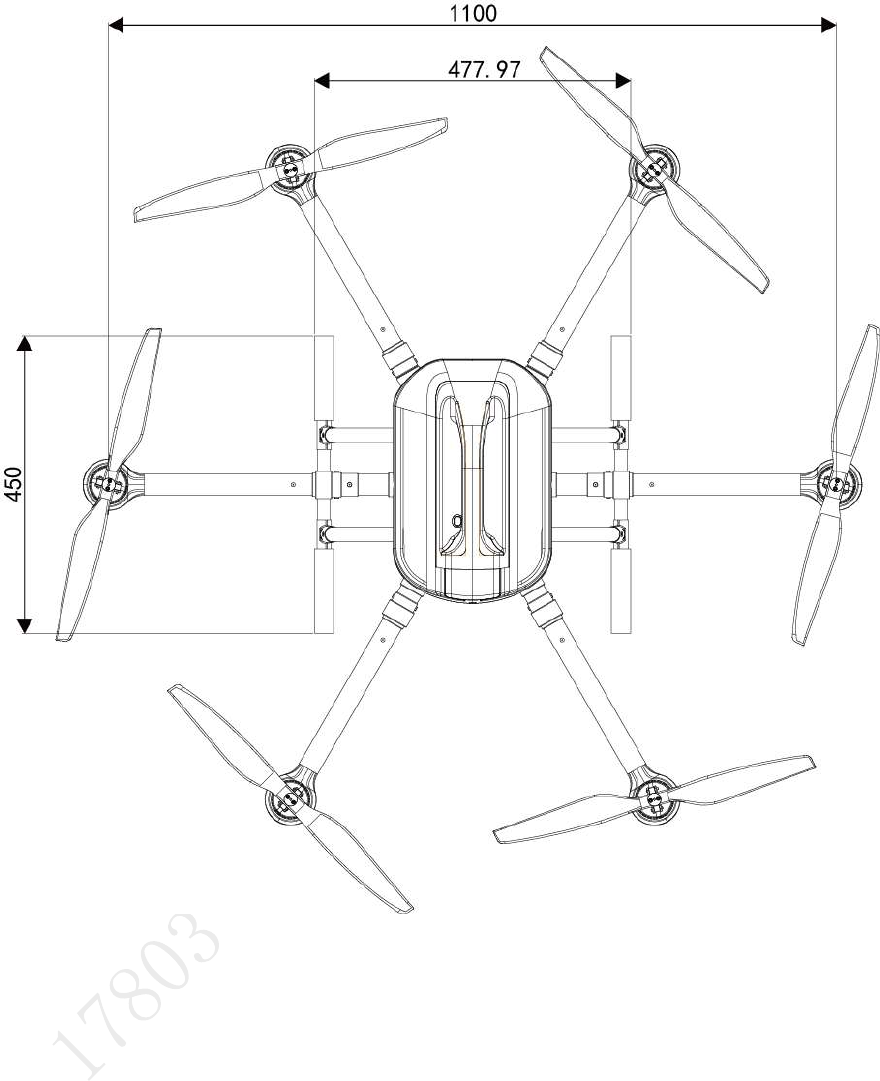
5
Figure 2-2
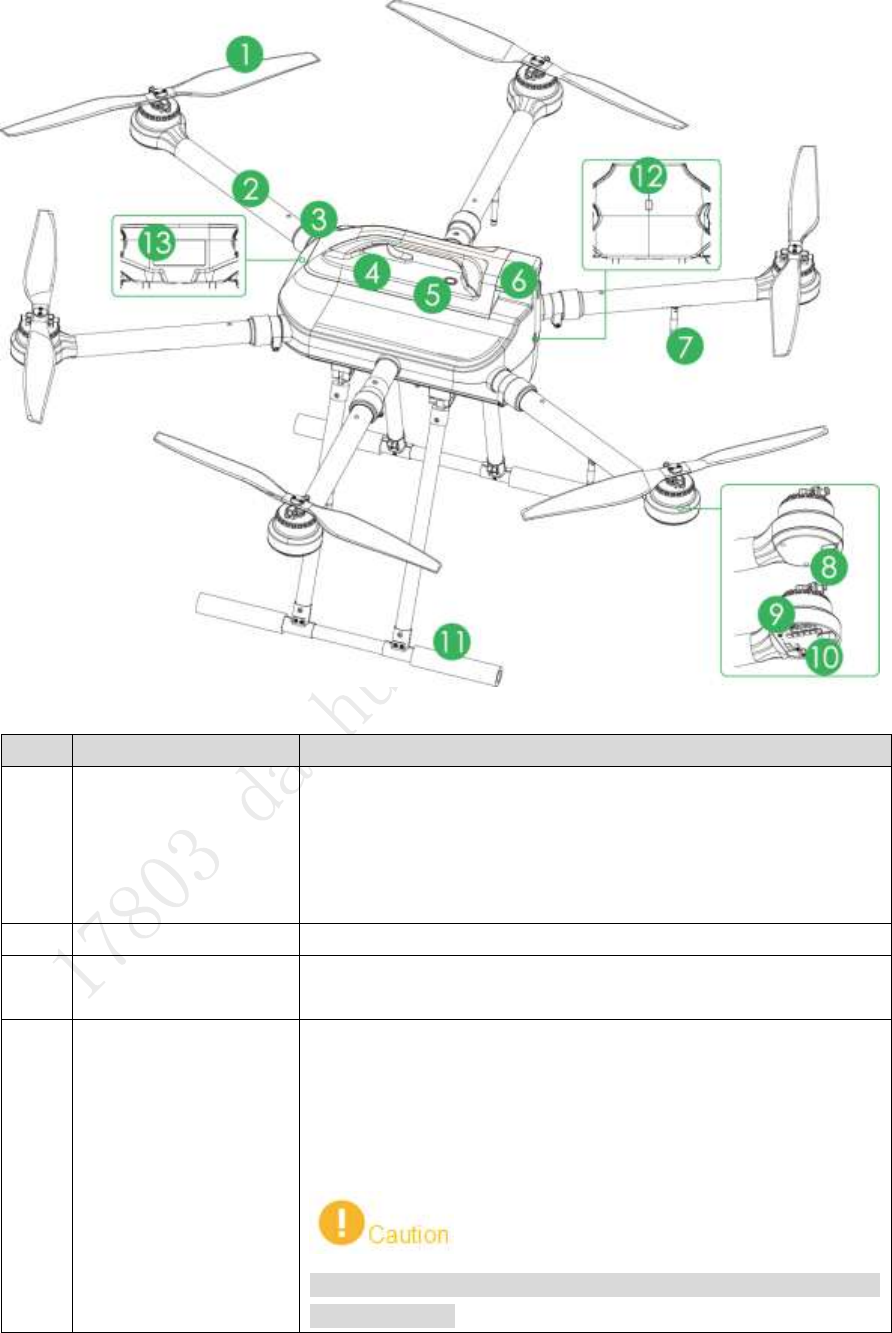
6
2.1.2 Structural Component
Figure 2-3
No.
Name
Function
1
Propeller
High-speed revolution to turn the brushless motor power to
propulsive force.
There are 3 pairs of propellers (3 CW propellers and 3 CCW
propellers) with different structures. Please install propellers
according to the actual situation.
2
Arm
Fold and unfold.
3
Protective cover of
propeller
Fix the horizontally unfolded arm.
4
Battery buckle
Dismantle and install the battery.
When it is opened, battery can be dismantled from the
device and replaced.
When it is closed, the battery cannot be dismantled from
the device.
After the battery is installed into the aircraft, battery buckle
shall be closed!
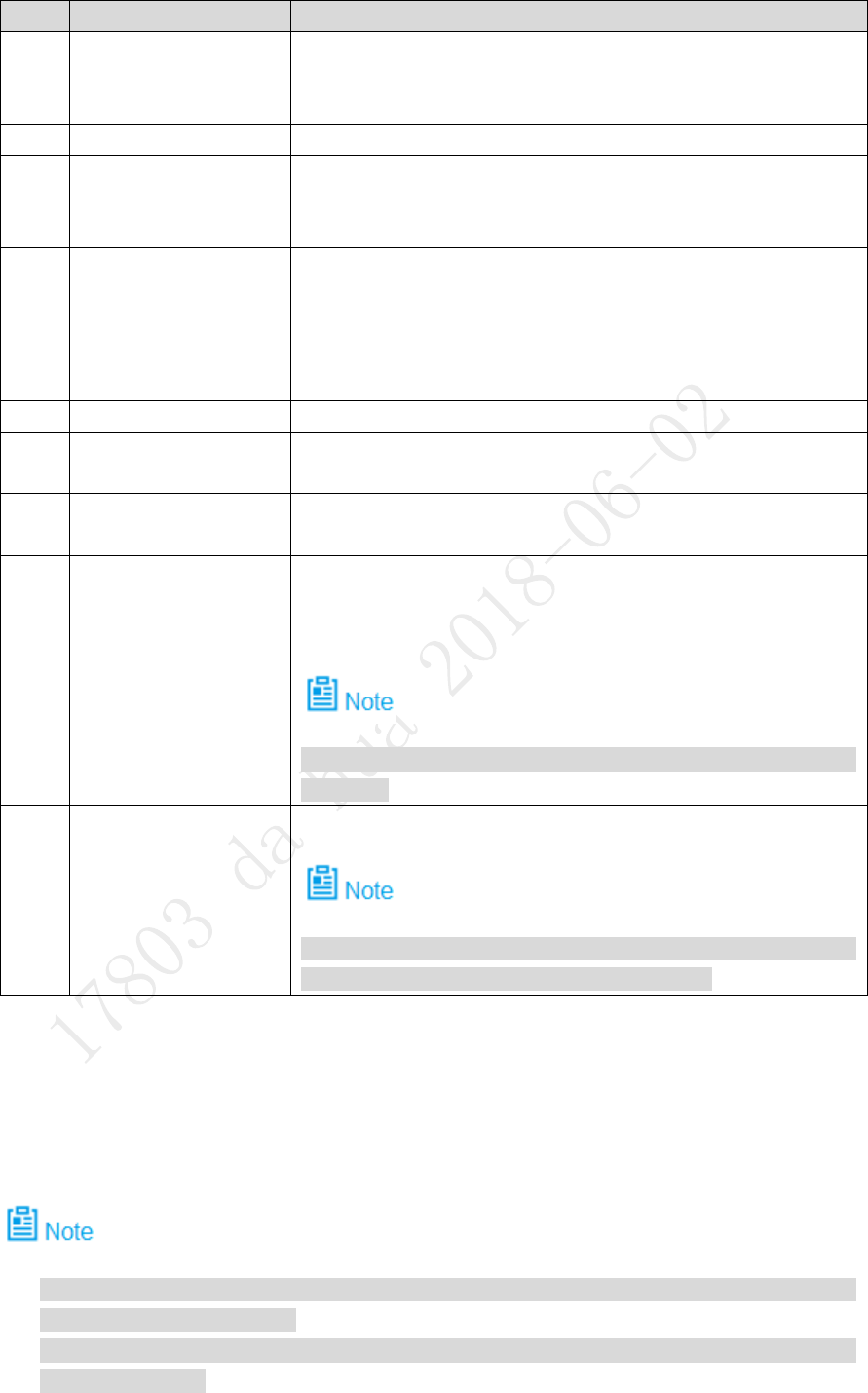
7
No.
Name
Function
5
Power switch (with
indicator)
Built-in indicator.
After the aircraft is power on, red indicates power-on state,
while green indicates remaining battery.
6
Empennage
Built-in GPS and electronic compass.
7
Antenna
Fold or unfold.
2 antennas are to receive the remote control signal.
2 antennas are for wireless image transmission.
8
Motor control panel
indicator
Display red and green.
Two adjacent indicators are normally on in red; their
middle part indicates aircraft nose.
Four adjacent indicators are normally on in green; their
middle part indicates aircraft tail.
9
Motor
Drive propeller rotation.
10
Motor speed
controller
With sine wave driving, have excellent acceleration and
deceleration performance.
11
Landing gear
Control the landing gear to open or fold with remote control
buttons.
12
Aircraft state indicator
There are two modes: normally on and flashing. It displays
five colors: red, yellow, blue, green and purple, to indicate
system state, flight mode, upgrade state and etc.
Refer to Appendix 2 for indicator light information and
definition.
13
Heat dissipation
module (cooling fin)
Built-in binocular heat dissipation module (cooling fin).
This module has different structures depending on device
configurations. Please refer to actual product.
Table 2-1
2.2 Airborne Device
This part takes visible light PTZ camera and IR thermal PTZ camera as an example, and
introduces airborne device.
For detailed info about various airborne device, please refer to their user’s manuals and
quick start guides.
The aircraft supports to carry 2 MP visible light PTZ camera and multiple airborne devices.
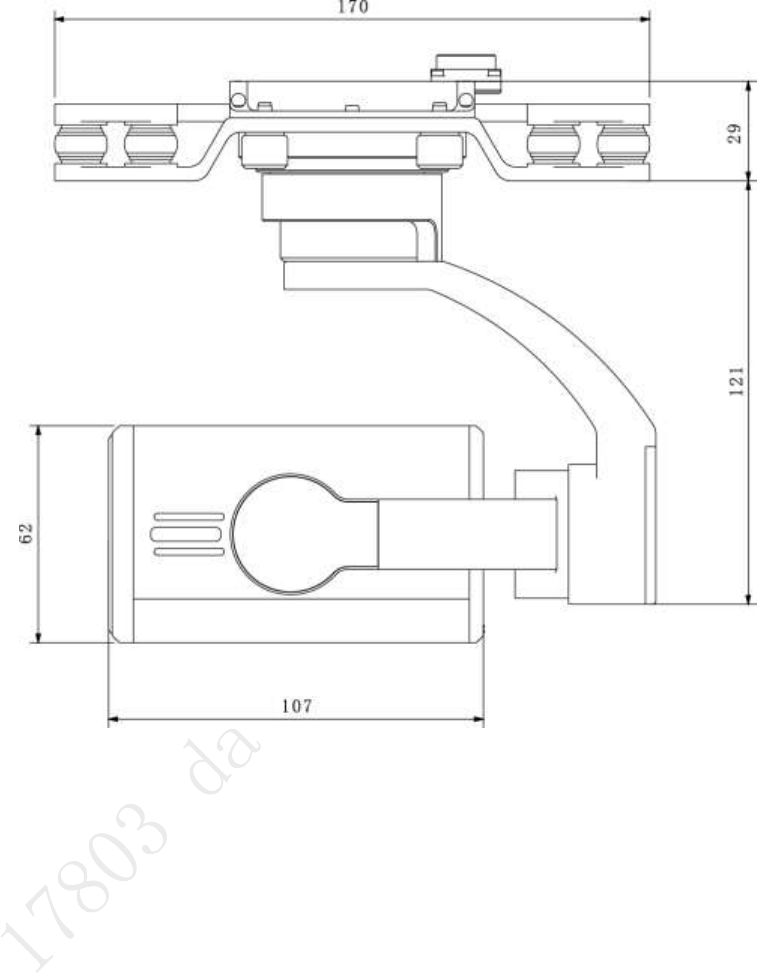
8
2.2.1 The 2 MP Visible Light PTZ Camera
Unit is mm.
Figure 2-4
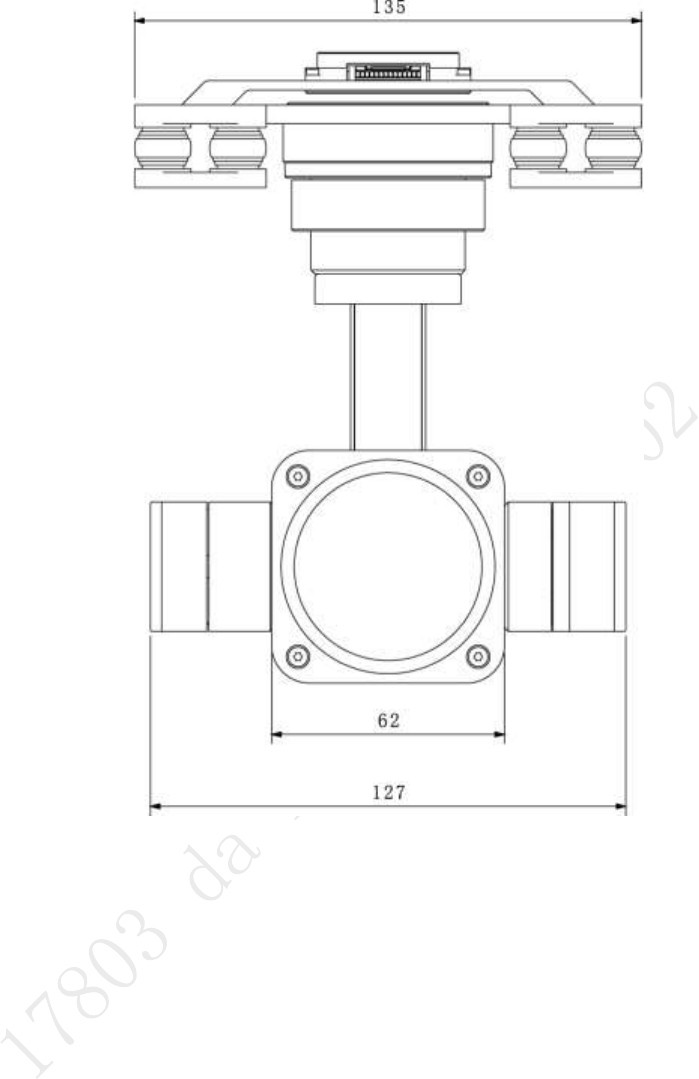
9
Figure 2-5
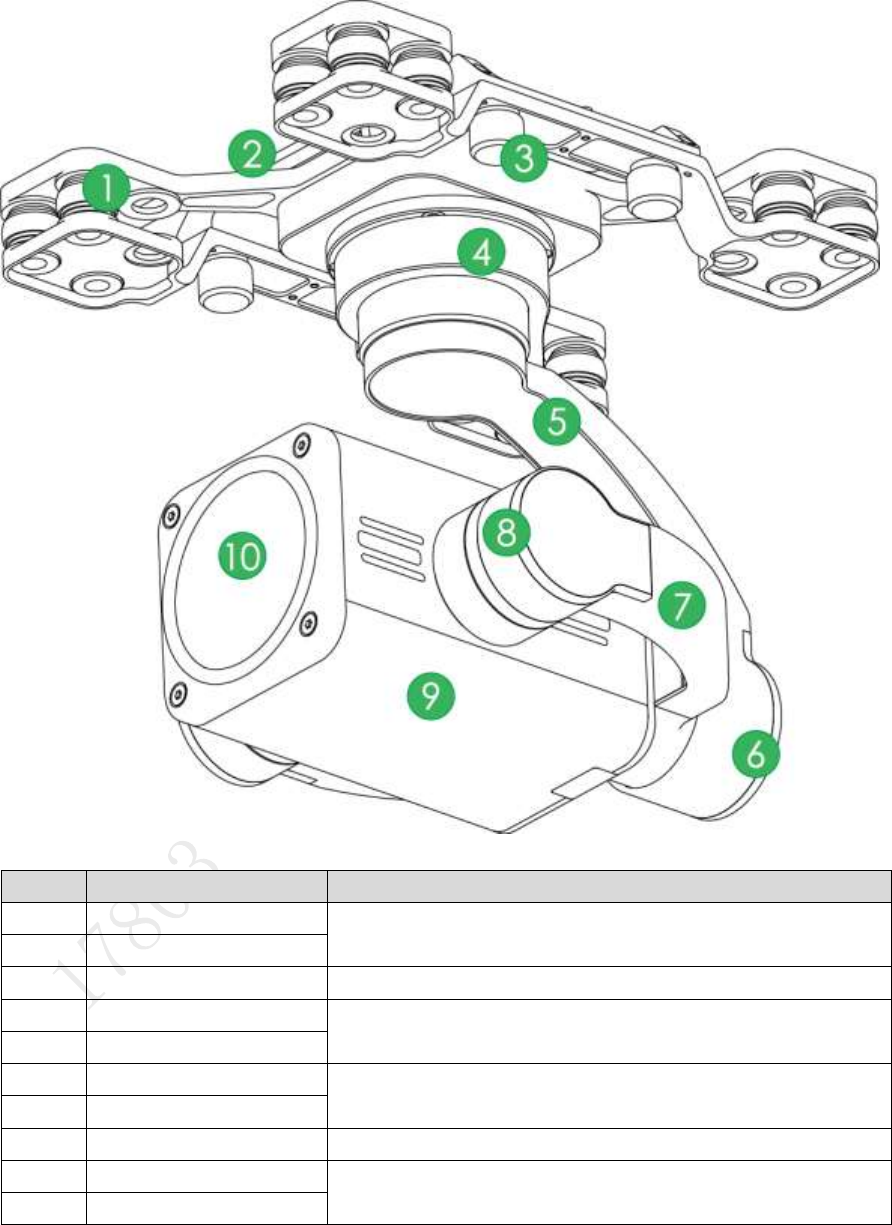
10
2.2.2 Structural Component of 2 MP Visible Light PTZ Camera
Figure 2-6
No.
Name
Function
1
Shock absorber ball
Reduce PTZ camera vibration during the flight, to get
clearer video.
2
Shock absorber board
3
Installation screw
Secure the PTZ camera on the aircraft.
4
Course motor
Control horizontal direction of the camera.
5
Course rotation arm
6
Roll motor
Control horizontal inclination angle of the camera.
7
Roll rotation arm
8
Pitching motor
Control vertical pitching angle of the camera.
9
Camera
Take pictures.
10
Lens
Table 2-2
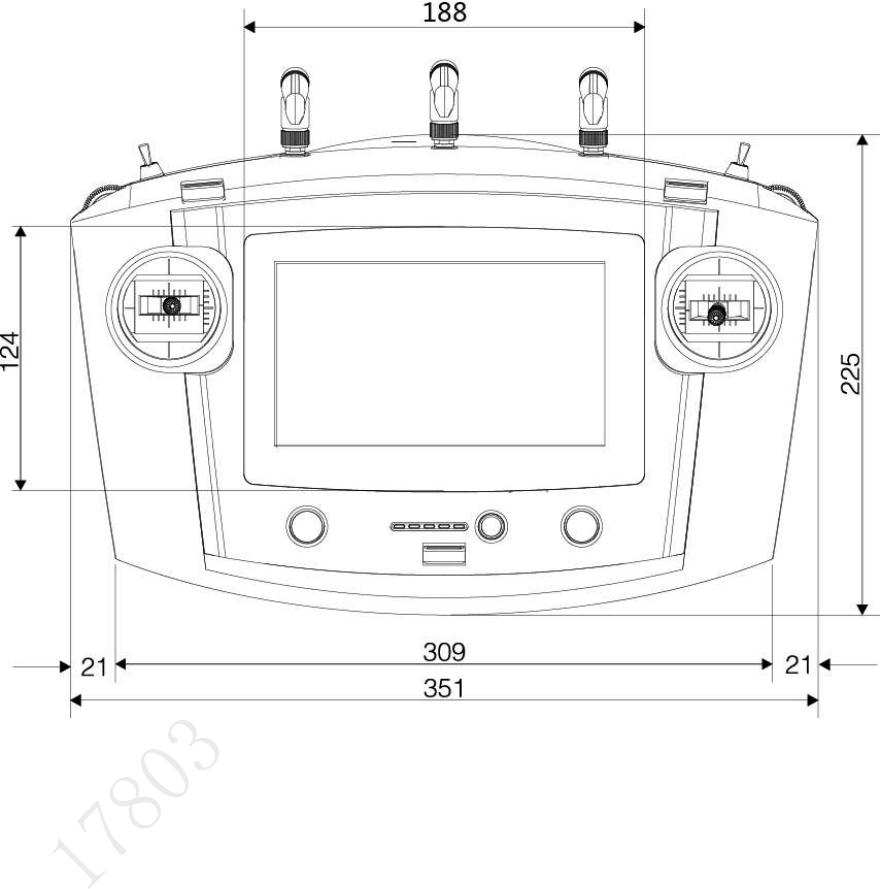
11
2.3 Remote Control
2.3.1 Dimensions
Unit is mm.
Figure 2-7
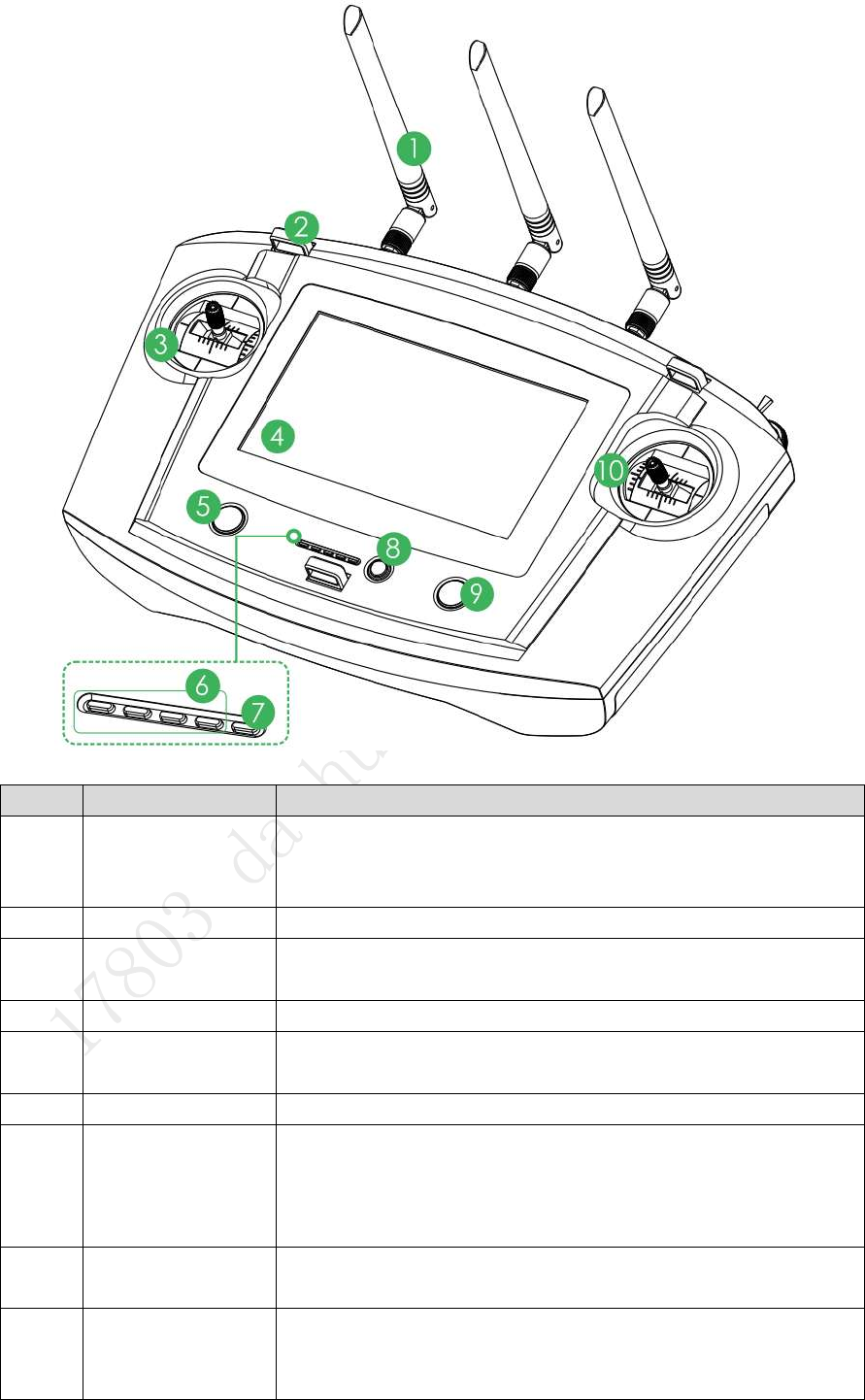
13
Figure 2-9
No.
Name
Function
1
Antenna
Establish the remote control relationship with the aircraft and
receive images. One silver antenna is installed in the middle,
while two yellow antennas are installed at both sides.
2
Hanger
Fix the hanger belt.
3
Left control
joystick
Control the aircraft flight state.
4
Touch screen
Set parameters and preview the video.
5
Landing gear
button
Control the landing gear.
6
Battery indicator
Each bar represents 25% battery power.
7
Charging indicator
Indicator light is on when connecting power to the charging
port.
Red light is normally on: charging.
Green light is normally on: charging is finished.
8
One-click return
button
Control aircraft to return home automatically.
9
One-click
takeoff/landing
button
Control aircraft takeoff or landing with one click. Takeoff height
is 2m.
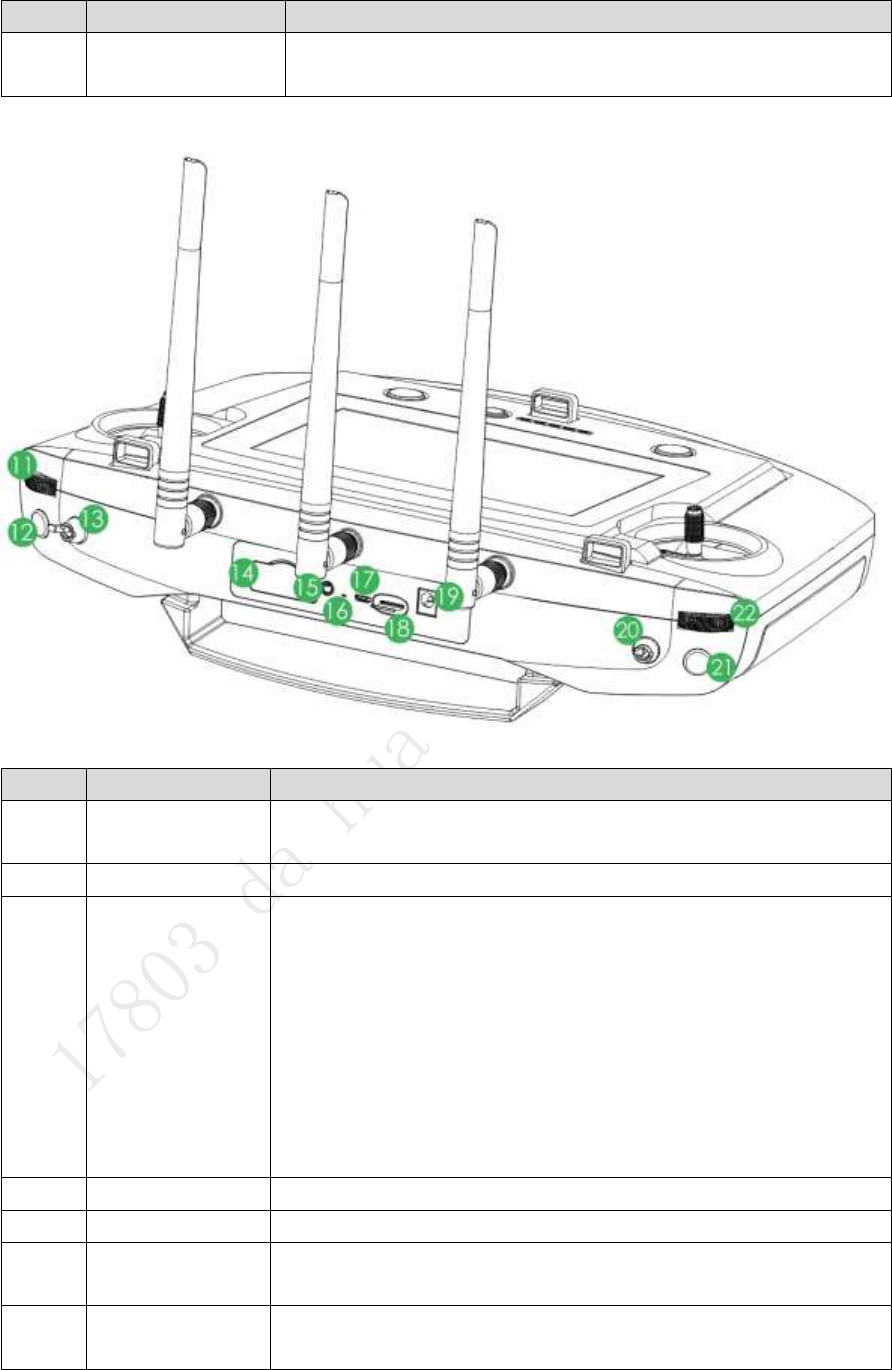
14
No.
Name
Function
10
Right control
joystick
Control the aircraft flight state.
Table 2-3
Figure 2-10
No.
Name
Function
11
PTZ course scroll
wheel
Control horizontal shooting angle of camera lens.
12
Snapshot
Press this button shortly to snapshot present image.
13
Flight mode lever
3-level lever to select flight mode.
Upper level: intelligent flight mode. The aircraft flights
automatically according to the specified course.
Middle level: flight at the specified height. When the throttle
lever is at the central mode, the aircraft flights at the same
height automatically.
Lower level: flight at the specified position. When all levers
are at the central mode, the aircraft hovers at the same
position.
14
4G SIM slot
Reserved
15
Audio output port
Connect to earphone, sound box and etc. It is to play audio.
16
Reset button of
remote control
Reserved.
17
Micro USB port
Insert data cable to connect PC. It is to transmit the data to the
PC.
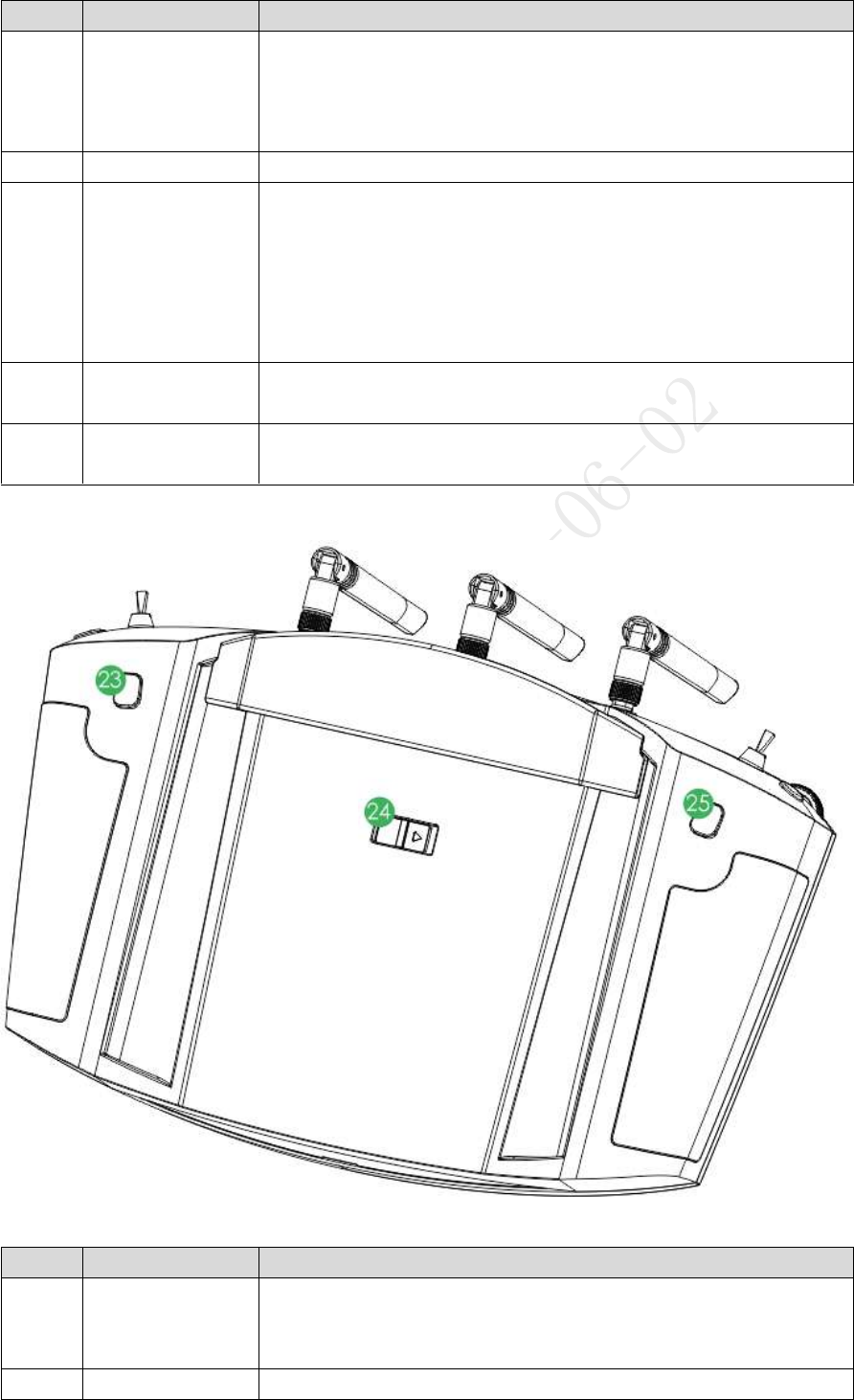
15
No.
Name
Function
18
SD slot
Insert micro SD card: The micro SD card with the chip is
facing down. Insert the card to the slot horizontally.
Remove micro SD card: Press micro SD card inwards, so
micro SD card pops up a little bit, and can be pulled out.
19
Power port
Input DC 12V power.
20
PTZ mode lever
2-level lever. It is to select PTZ mode.
Upper level: Course following mode. The PTZ camera angle
changes with aircraft flight direction.
Lower level: Course locking mode. No matter what the
aircraft flight angles are, the PTZ camera always faces the
same degree to shoot.
21
Record button
Press this button shortly to start recording, and press it again to
stop recording.
22
PTZ pitch scroll
wheel
Control vertical shooting angle of camera lens.
Table 2-4
Figure 2-11
No.
Name
Function
23
Zoom in button
Press it for a short time, to zoom in the camera.
Press it for a long time, to zoom in until the camera reaches
the maximum magnification.
24
Power switch
Turn on or turn off the remote control.
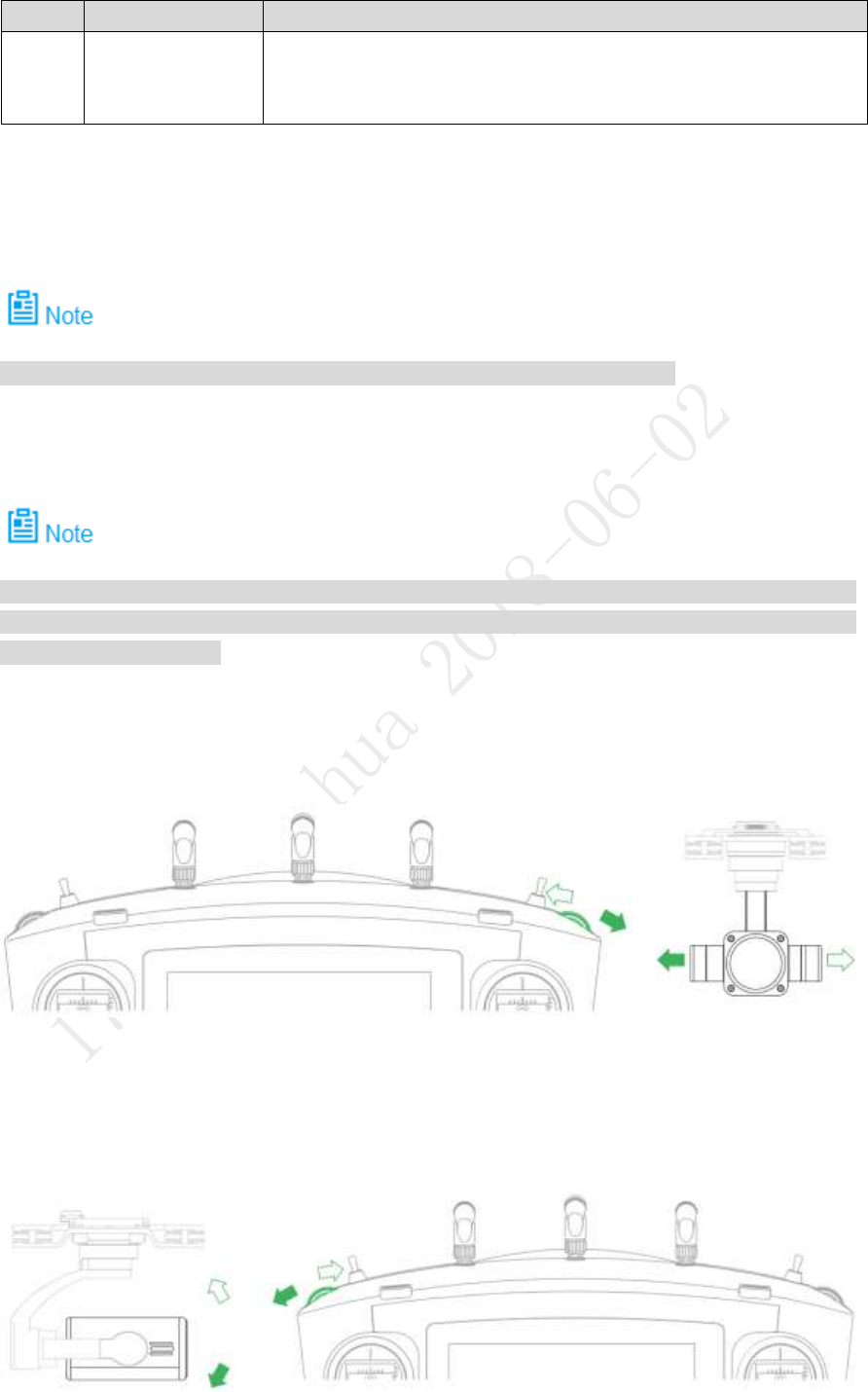
16
No.
Name
Function
25
Zoom out button
Press it for a short time, to zoom out the camera.
Press it for a long time, to zoom out until the camera
reaches the minimum magnification.
Table 2-5
2.3.3 Buttons
Refer to Chapter 4 for the joystick and flight mode lever button information.
2.3.3.1 Scroll Wheel
Besides “PTZ Course Scroll Wheel” and “PTZ Pitching Scroll Wheel” of remote control, control
PTZ “PZT Center” and “PTZ 90°” through “State Bar > Quick Operation > PTZ”. Please refer to
“3.6.5.2 PTZ” for details.
PTZ course scroll wheel: control horizontal shooting angle of camera lens, as shown in
Figure 2-12.
Scroll wheel turns to the left: PTZ turns to the left.
Scroll wheel turns to the right: PTZ turns to the right.
Figure 2-12
PTZ pitching scroll wheel: control vertical shooting angle of camera lens, as shown in
Figure 2-13.
Scroll wheel turns to the left: camera lens turns downwards.
Scroll wheel turns to the right: camera lens turns upwards.
Figure 2-13
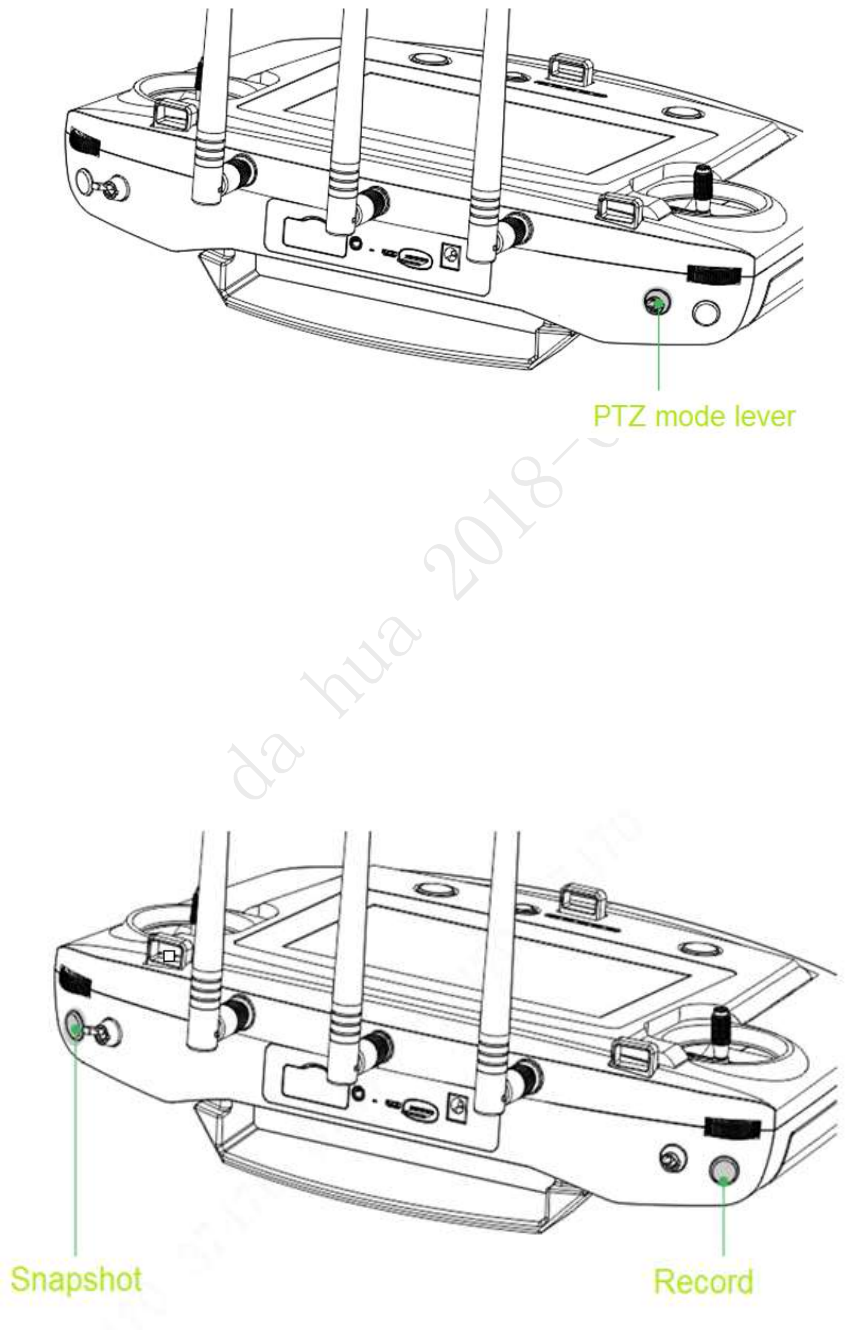
17
2.3.3.2 PTZ Mode Lever
Shooting direction of PTZ camera is controlled with PTZ mode lever, as shown in Figure 2-14.
Figure 2-14
2-level lever:
Upper level: Course following mode. Shooting angle of PTZ camera changes with aircraft
flight direction.
Lower level: Course locking mode. No matter what the aircraft flight angles are, the PTZ
camera always faces the same degree to shoot.
Lever returns to the center: start from any position, move the lever for three times
continuously. Shooting angle of PTZ camera will be consistent with aircraft flight direction.
2.3.3.3 Shooting
Figure 2-15
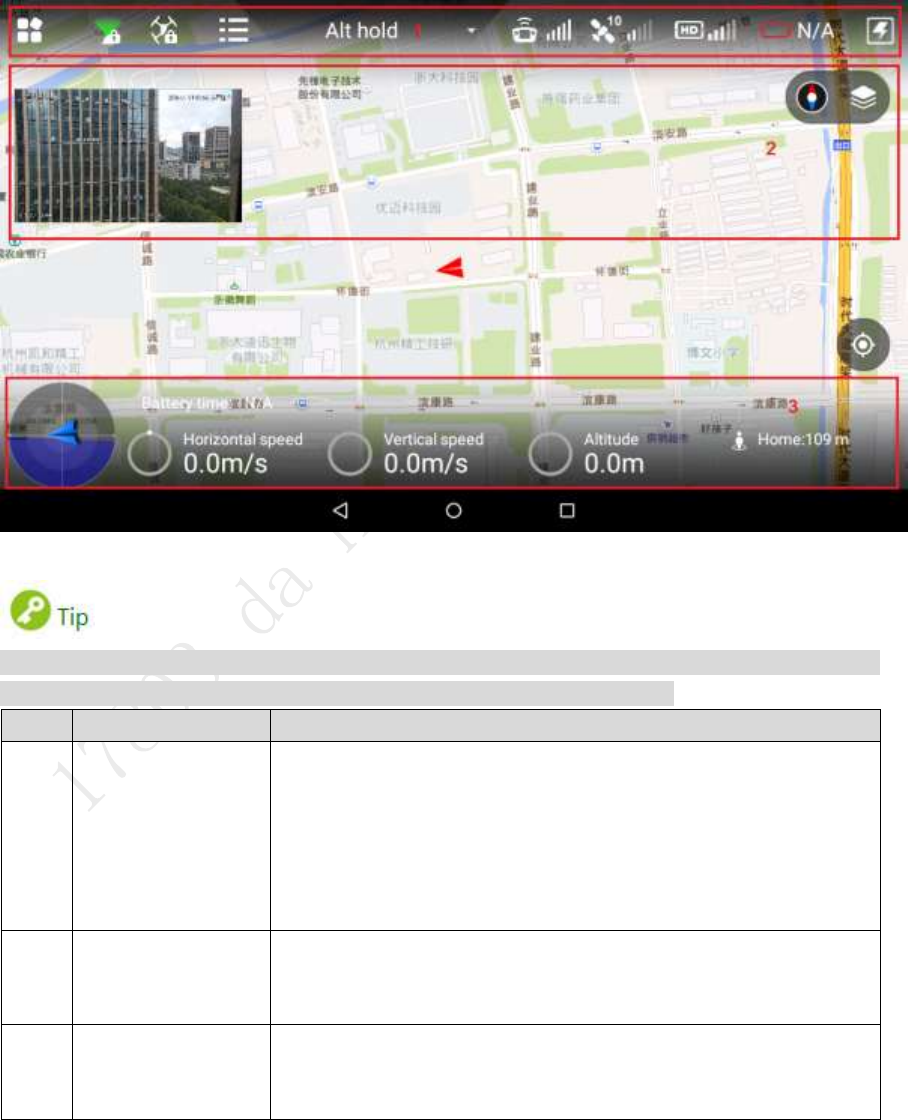
18
Snapshot: Press snapshot button for a short time to snapshot the present image.
Record: Press record button for a short time to begin recording video. Press it for a short
time again to stop recording.
2.3.4 Operation Interface
After turning on with the remote control, enter main interface. It consists of the following
function modules, as shown in Figure 2-16.
Figure 2-16
Slide up at any position on the preview interface to hide the setting menu, function bar and state
bar. Slide down at any position on the main interface to view them again.
No.
Name
Function
1
Function setting
and state bar
Set the menu and aircraft course; display PTZ mode, flight state
list, flight mode, remote control signal intensity, GPS signal
intensity, image transmission signal quality, aircraft battery and
quick viewing.
Please refer to “4.5 Remote Control Setting” for specific setting
items and descriptions.
2
Preview window
Quickly switch video preview and map preview to display
prompt information and PTZ control. Please refer to “2.3.4.3
Preview” for details.
3
State bar
Display remaining flight time, aircraft speed, height and
distance from the HOME. Please refer to “2.3.4.2 State Display
Bar” for details.
Table 2-6
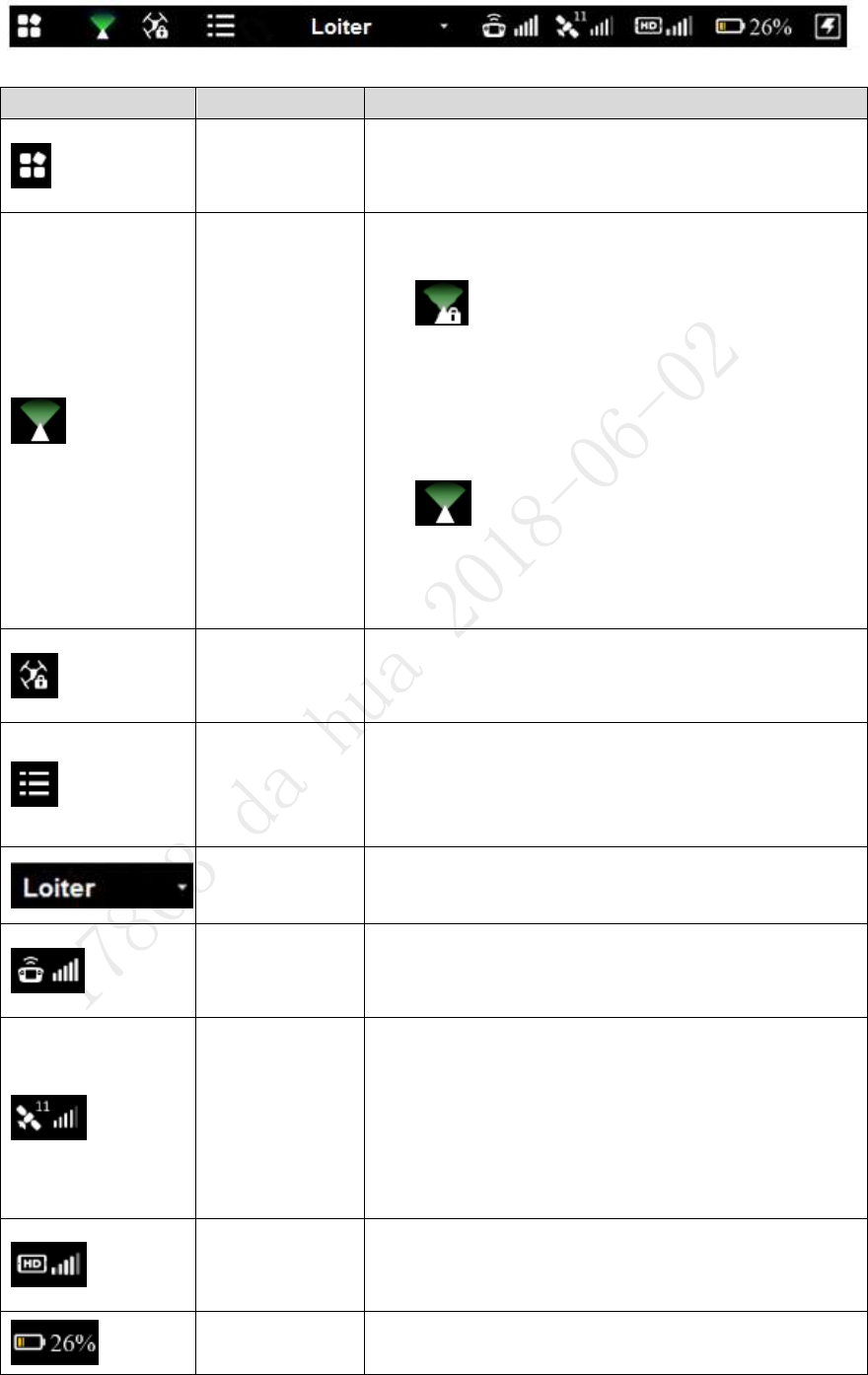
19
2.3.4.1 Function Setting and State Bar
Figure 2-17
Icon
Name
Function
Settings
Click this icon to enter setting menu.
Please refer to “1
Setting” for details.
PTZ mode
Display present PTZ mode (PTZ locking or PTZ
following mode).
: When the PTZ lever is at the lower level,
the PTZ camera has locked the course
direction. No matter how aircraft angle changes,
the PTZ camera is still facing the same direction
to shoot.
: When the PTZ lever is at the upper level,
the PTZ camera direction is flight following
mode. The shooting angle changes with the
aircraft course angle.
Locking mode
Click this icon to set aircraft course locking or return
locking mode.
Please refer to “2.3.4.4.2 Locking Mode” for details.
Drone state list
Click this icon, and aircraft state list will pop up.
View compass, accelerometer, gyro, remote mode,
GPS signal, drone battery and camera SD card
remaining/total capacity info.
Flight mode
display
Display present flight mode of the aircraft, including
intelligent flight, loiter and fixed point mode.
Remote control
signal intensity
Display signal intensity of remote control and aircraft.
There are max. 5 bars. The more the highlighted bar
amount is, the stronger the remote control effect is.
GPS satellite
and signal
intensity
The number on the left side is the GPS satellite
amount.
The GPS signal intensity is shown on the right.
There are max. 5 bars. The more the highlighted
bar amount is, the stronger the remote control
effect is.
Image
transmission
signal quality
Click this icon, and image transmission signal quality
frame will pop up. Display general signal quality of
image transmission antenna.
Remaining
battery of
Display battery info of the aircraft.
Display N/A when the aircraft is not connected;
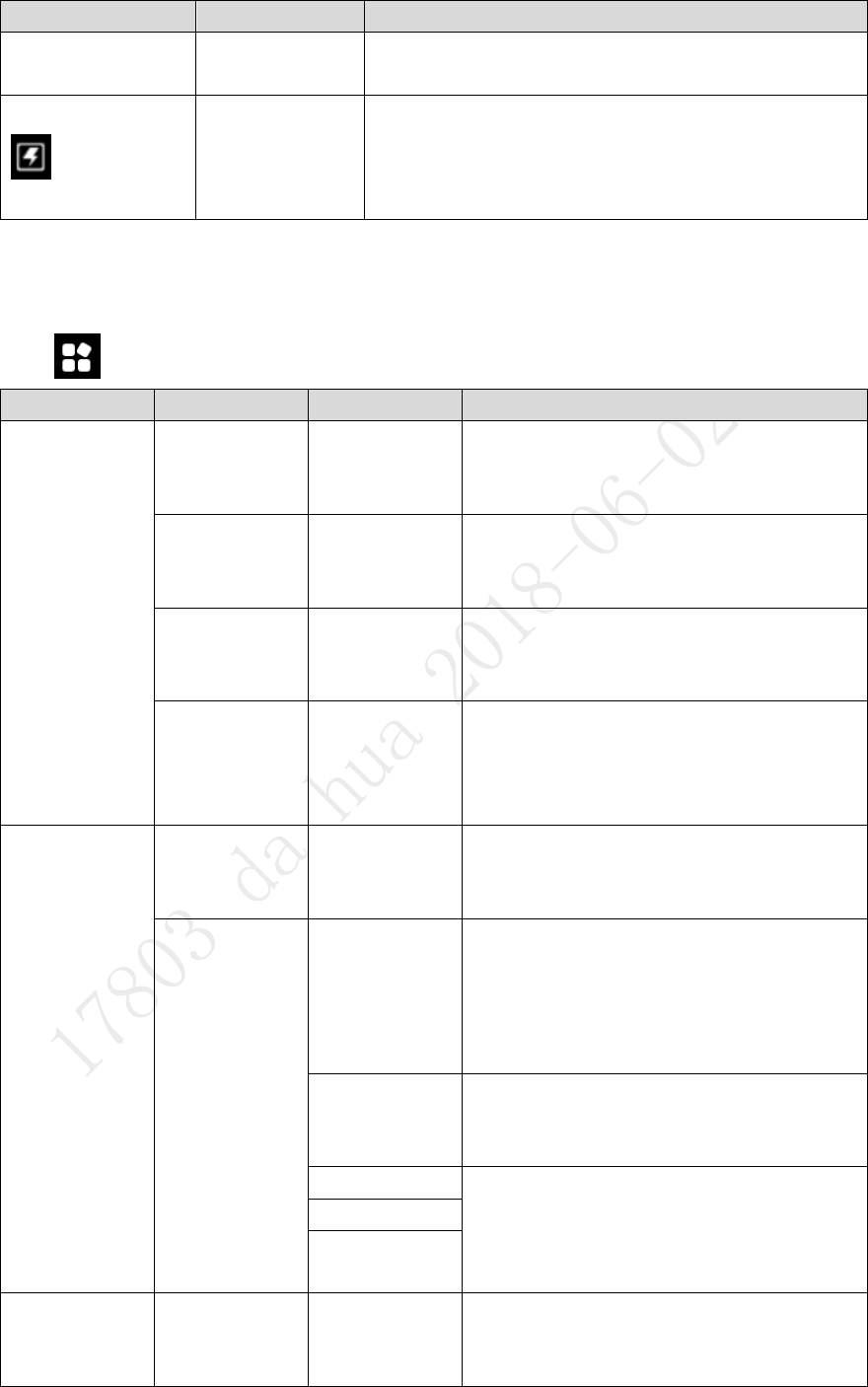
20
Icon
Name
Function
aircraft
display present aircraft battery percentage after
pairing connection.
Quick operation
Click this icon to enter quick entry interface, and set
dashboard, PTZ, image transfer and other quick
options. Please refer to “3.6.5 Set Quick Operation”
for details.
Table 2-7
3.3.4.1.1 Setting
Click to enter setting interface, as shown in Table 2-8.
Level 1 Menu
Level 2 Menu
Level 3 Menu
Function
Remote
Control
Control
joystick mode
-
Provide two modes.
Please refer to “4.2.4 Manual Flight
Control” for details.
Remote
control
calibration
-
Calibrate the remote control.
Please refer to “3.8.1 Remote Control
Calibration” for details.
Remote pair
-
Pair the remote control and aircraft again.
Please refer to “Appendix 3 System
Pairing” for details.
Remote
button
user-defined
-
Indicate A1 button and function of the
remote control.
Please refer to “4.5.1 Remote Button
User-defined” for details.
Flight
Fence enable
-
Enable or disable e-fence.
Please refer to “4.5.2.2 Enable Electronic
Fence” for details.
Fence
settings
Fence type
Set e-fence type.
Please refer to “5
Fence Type” for details.
Fence action
Select fence action.
Please refer to “4.5.2.1.1
Fence Action” for details.
Max height
Set max. height, max. radius and reach
distance of the fence.
Please refer to “4.5.2.1.3 Other Settings”
for details.
Max radius
Reach
distance
Preview
Image
transmission
settings
-
Set preview image size.
Please refer to “4.5.3 Preview Settings”
for details.
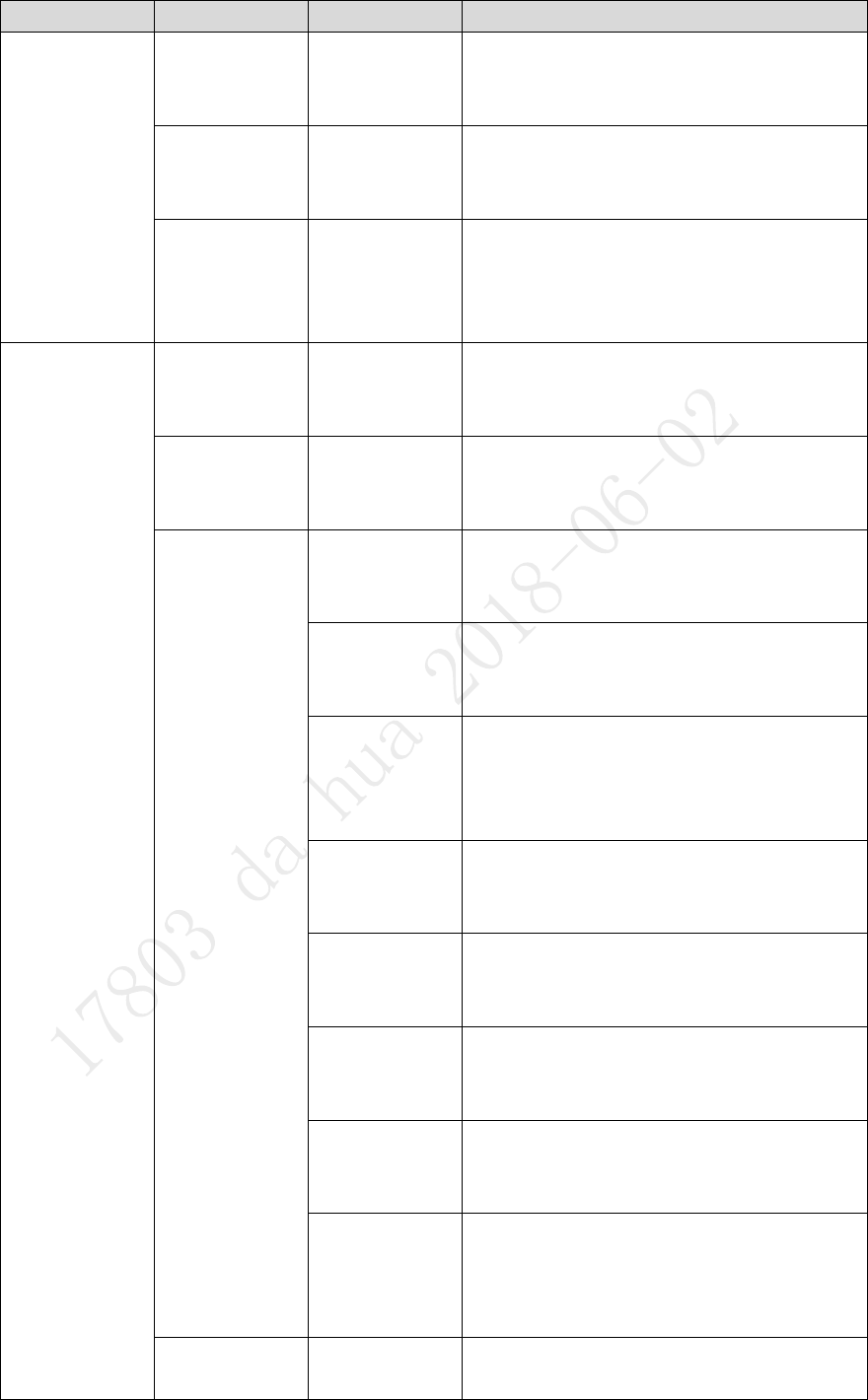
21
Level 1 Menu
Level 2 Menu
Level 3 Menu
Function
Camera
Photo settings
-
Set photo size.
Please refer to “4.5.4.1 Photo Settings”
for details.
Video settings
-
Set relevant parameters of video.
Please refer to “4.5.4.2 Video Settings” for
details.
Advanced
Image
settings
Set brightness, contrast, saturation,
sharpness and gamma value.
Please refer to “4.5.4.3 Image Settings”
for details.
General
Aircraft
firmware
upgrade
-
Check firmware status and upgrade.
Please refer to “6.1 Firmware Update” for
details.
APP upgrade
-
Check APP status and upgrade.
Please refer to “6.2.1 APP Update” for
details.
Other
Geomagnetic
calibration
Calibrate geomagnetism.
Please refer to “3.8.4 Geomagnetic
Abnormity” for details.
Acceleromete
r calibration
Calibrate accelerometer.
Please refer to “3.8.2 Accelerometer
Calibration” for details.
Offline map
Add or delete offline map.
Please refer to “6.2.2 Download and
Update Offline Map of Remote Control”
for details.
Brightness
Adjust brightness of tablet PC.
Please refer to “4.5.5.1.3 Brightness” for
details.
Date and time
Set the date and time of remote control.
Please refer to “4.5.5.1.4 Date and time”
for details.
Network
setting
Set networking mode.
Please refer to “4.5.5.1.1 Network
Settings” for details.
Language
Set software language of remote control.
Please refer to “4.5.5.1.5 Language” for
details.
Storage
setting
View total storage space of Micro SD card
and the space occupied by every part.
Please refer to “4.5.5.1.2 Micro SD
Settings” for details.
About
Hardware
version
Display hardware info.
Table 2-8
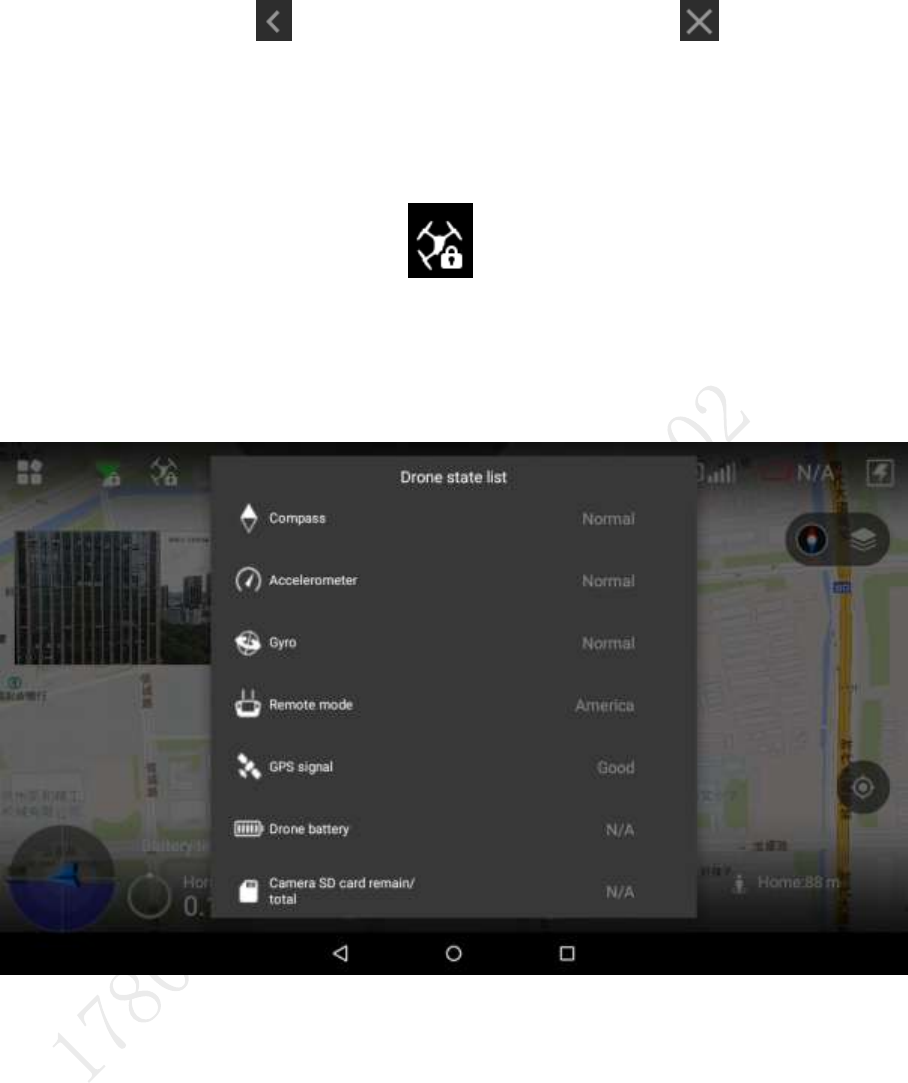
22
On settings interface, click to return to the previous menu and click to exit settings.
3.3.2.1.1 Locking Mode
Click it to select locking mode of the aircraft on the popped up dialog box, as shown in Figure
2-18.
Figure 2-18
3.3.2.1.2 Flight State List
Click the icon to display drone state list, as shown in Figure 2-19.
Figure 2-19
View drone state info in a real-time way.
3.3.2.1.3 Quick Operation
Realize quick setting of dashboard, PTZ, image transfer and others. Please refer to “3.6.5 Set
Quick Operation” for details.
Click the icon to display quick operation, as shown in Figure 2-20.
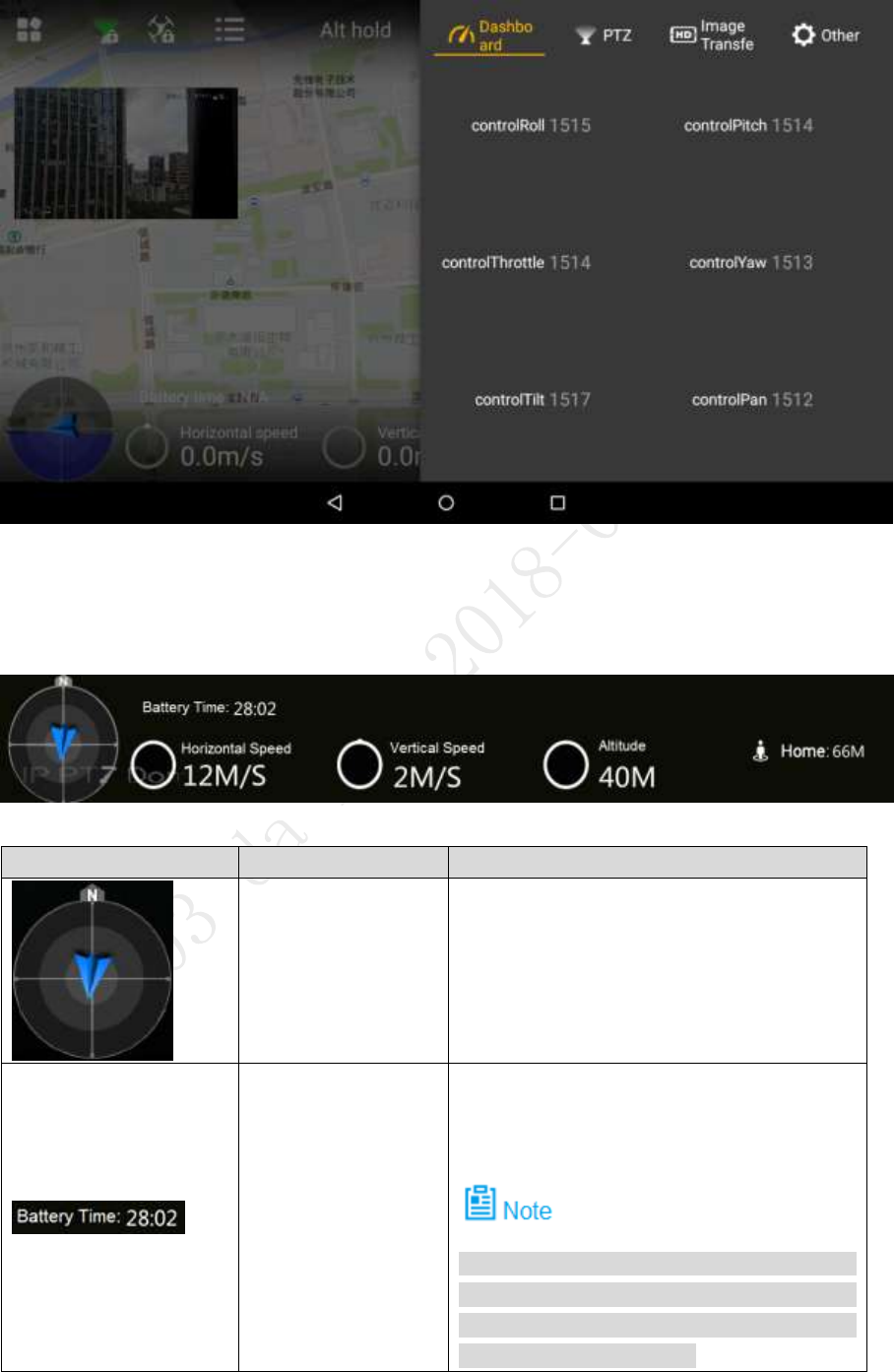
23
Figure 2-20
2.3.4.2 State Display Bar
Figure 2-21
Icon
Name
Function
Aircraft direction
and camera lens
direction
Blue triangle: it indicates the aircraft
direction on the geographic position.
Battery time
Display remaining flight time of the aircraft.
It displays N/A when the aircraft is not
connected.
This estimated value is for reference only.
Actual flight time may be affected by
enviroment and etc., so it may be different
from the actual flight time.
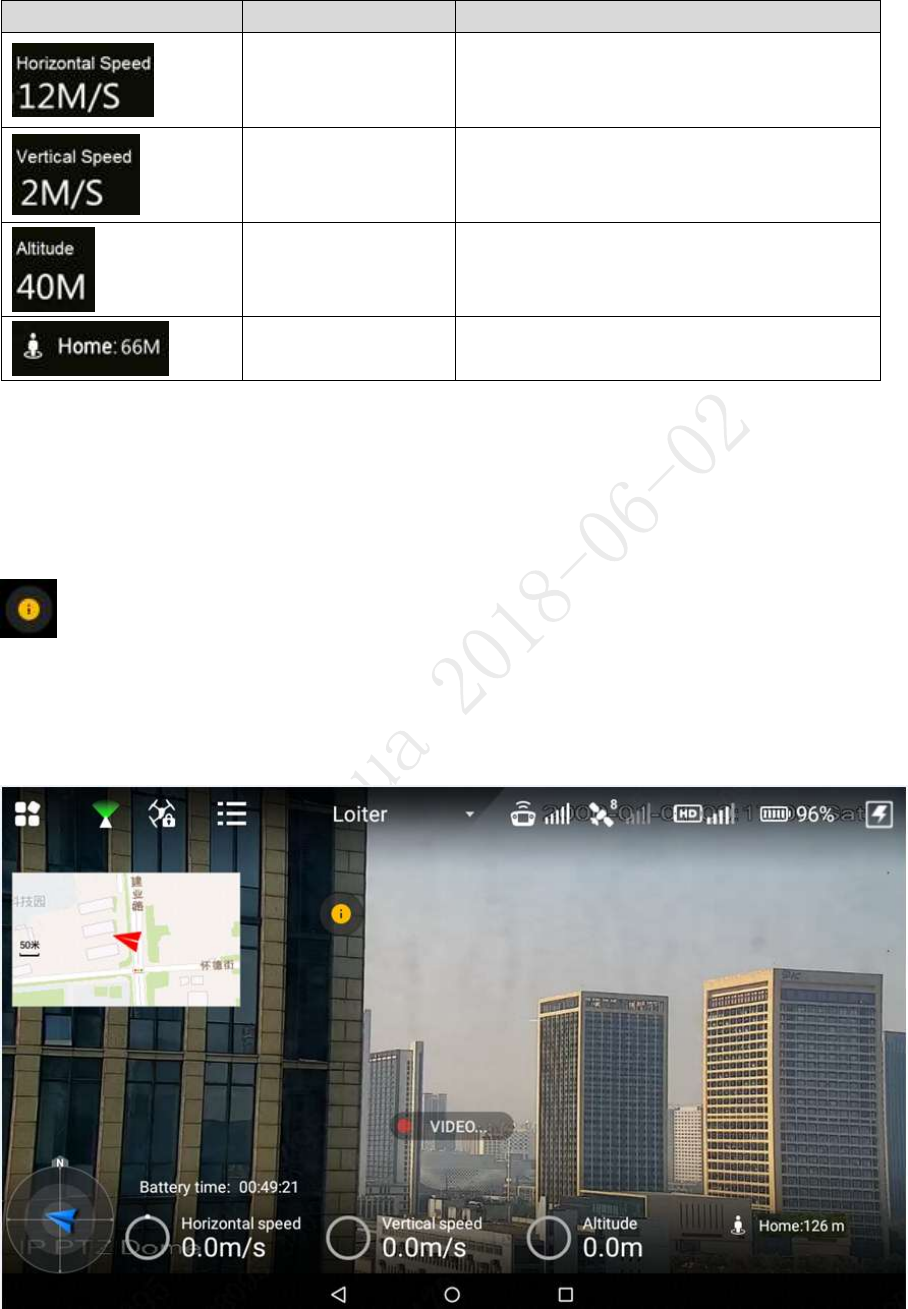
24
Icon
Name
Function
Horizontal speed
Horizontal forward and backward speed of
the aircraft. It displays N/A when the aircraft
is not connected.
Vertical speed
Vertical ascending and descending speed
of the aircraft. It displays N/A when the
aircraft is not connected.
Altitude
Relative altitude from the takeoff position. It
displays N/A when the aircraft is not
connected.
Distance from the
HOME
Distance between the aircraft and Home.
This value is planar projection distance.
Table 2-9
2.3.4.3 Preview
Click the window at the top left corner, to switch between video preview mode and map preview
mode.
Prompt information is displayed on the right side of the icon. Click the icon to view
message list.
2.3.4.3.1 Video Preview Mode
Default preview mode is shown in Figure 2-22.
Figure 2-22
In this mode, the map is displayed in a small window at the top left corner of the preview
interface.
In this mode, the large window displays the real-time image transmitted by the camera to
the remote control.
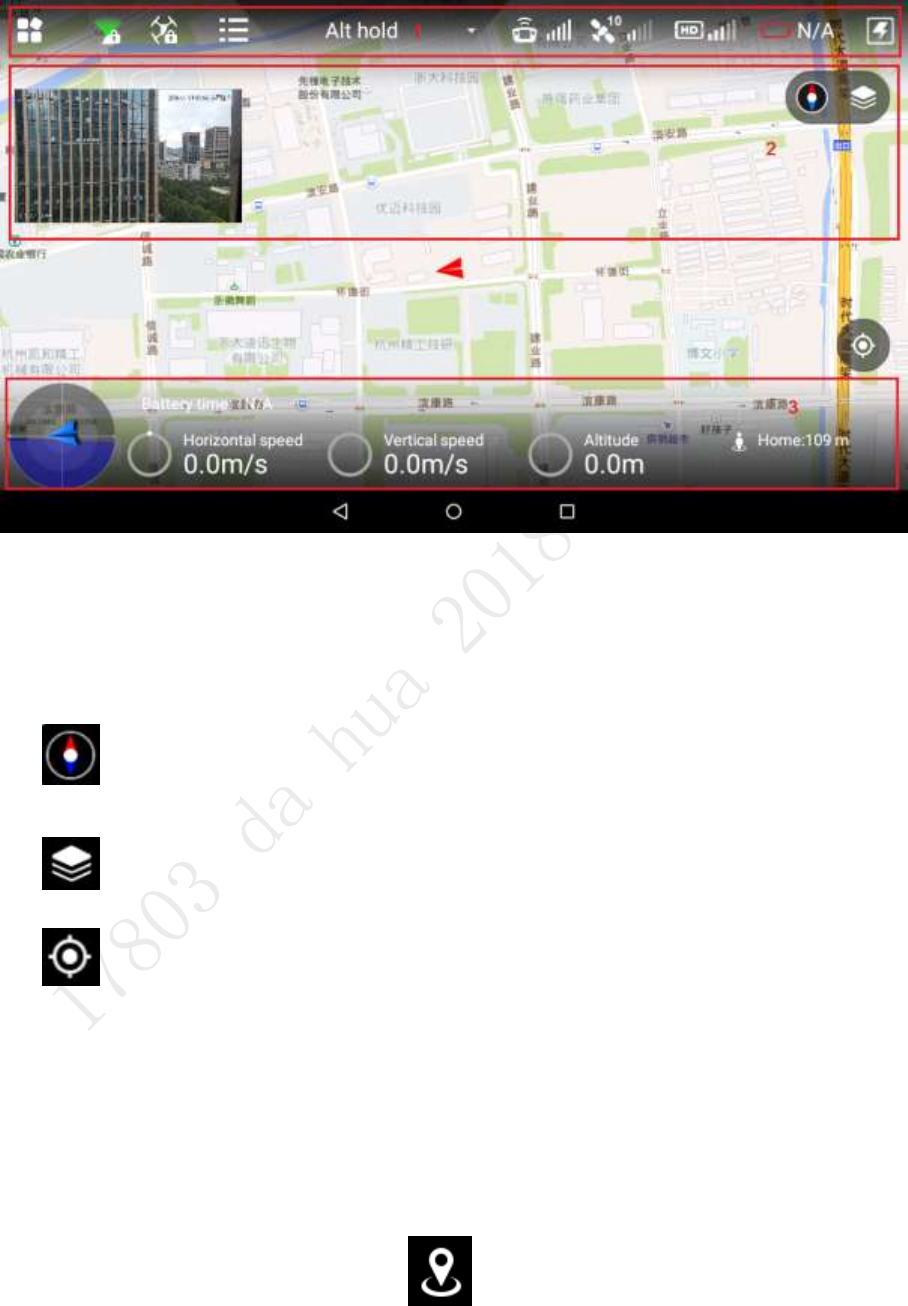
25
2.3.4.3.2 Map Preview Mode
Figure 2-23
In this mode, the image transmitted by the camera to the remote control is displayed in a
small window at the top left corner of the preview interface.
In this mode, the large window displays aircraft position on the map.
Buttons in map preview mode are described as follows:
Map direction locking button: When it is unlocked, press the map interface with two
fingers to rotate the map; when it is locked, map direction cannot be changed.
Map display mode switching button: Switch to display the map in the form of satellite
imagery or 2D image.
Central button: Switch to current position of the aircraft quickly and center at current
position of the aircraft.
2.3.4.4 General Functions
2.3.4.4.1 Set Home Point
Click the icon to set current location of the aircraft to be Home, as shown in Figure 2-24.
Figure 2-24
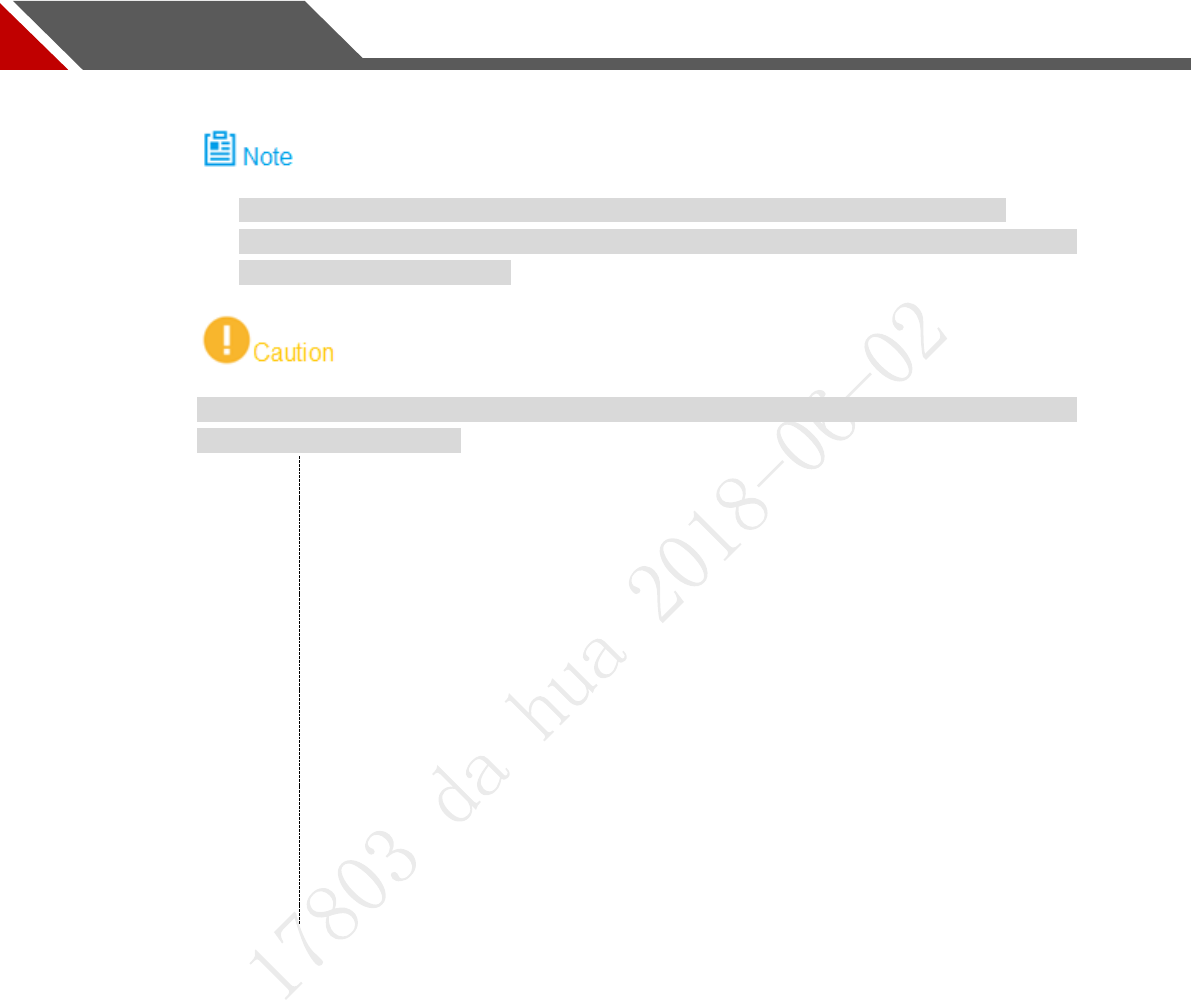
27
3 Flight Preparation
This chapter elaborates complete flow before the aircraft is unlocked and takes off.
Please select operation according to the actual situation after the first flight is over, if it is
not the used for the first time.
Please operate by strictly conforming to the steps described in this chapter; the operation
sequence can't be reversed.
Flight
Preparation
Phase
Unpack
↓
Check remaining power →Please charge in case of low battery
↓ ↙
Prepare airborne device
↓
Prepare aircraft
↓
Prepare remote control
↓
Enable aircraft power
↓
Check debugging →All debugging is normal
↓ ↙
Start flight
Figure 3-1
4.1 Unpack
Take out aircraft, battery, propellers and remote control from the packing box.
4.2 Check Remaining Power
Check the remaining power of aircraft battery and remote control. Implement the subsequent
steps after confirming that the battery reaches the standard.
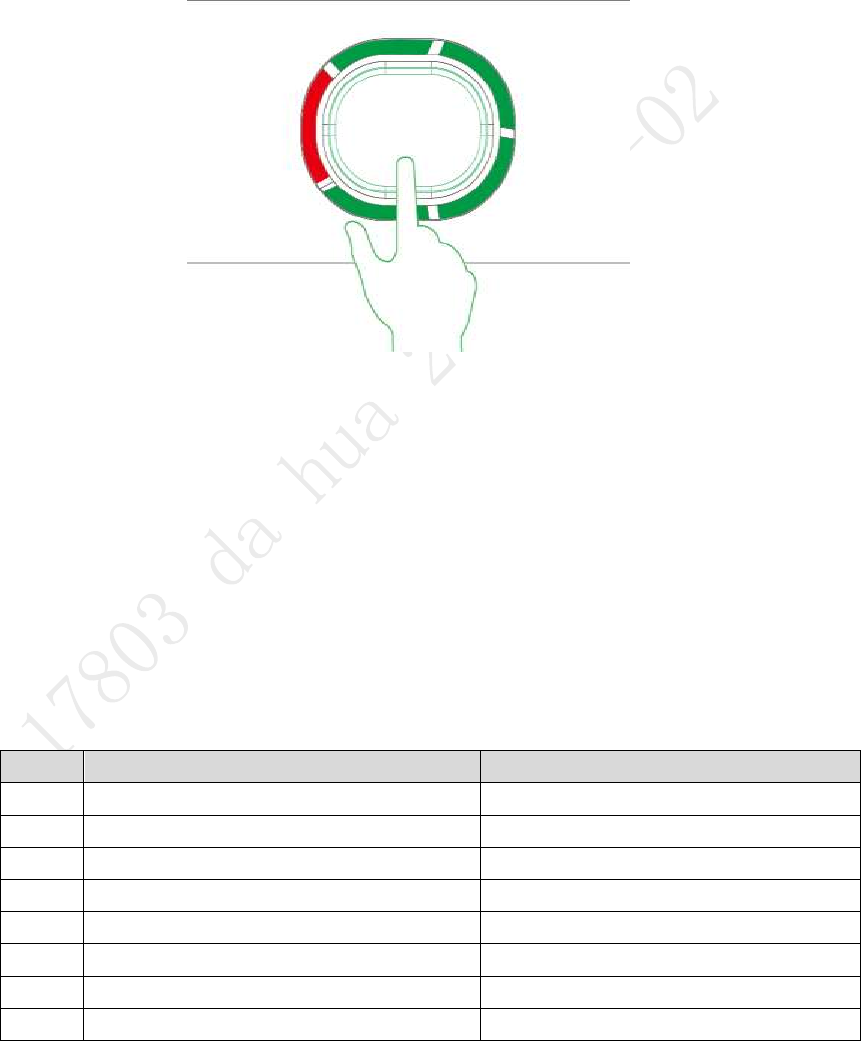
28
Please refer to “3.3 Charging” when the battery is low. Please implement the sebsequent steps
after charging.
4.2.1 Aircraft
3.2.1.1 Aircraft Battery Check
Short press the aircraft battery switch and check the state of indicator lights, as shown in Figure
3-2.
Figure 3-2
Battery switch has 5 indicator light states. The front red indicator light means that the battery is
on, whereas the other 4 green indicator lights represent remaining power of the battery.
At normal temperature, the remaining power shall be ≥2.
The aircraft shall take off with full power when temperature is lower than -10℃.
3.2.1.2 Aircraft Remaining Power
There are three states for each indicator light of the aircraft battery, which are normally on, flash
and off.
The following table describes remaining power percentage in different status. “●” means
normally on, “◎” means flash and “○” means off, as shown in Table 3-1.
No.
Indicator Light Status
Remaining Battery Percentage Range
1
●●●●~●●●◎
100%~87.5%
2
●●●◎~●●●○
87.5%~75%
3
●●●○~●●◎○
75%~62.5%
4
●●◎○~●●○○
62.5%~50%
5
●●○○~●◎○○
50%~37.5%
6
●◎○○~●○○○
37.5%~25%
7
●○○○~◎○○○
25%~12.5%
8
◎○○○~○○○○
12.5%~0
Table 3-1
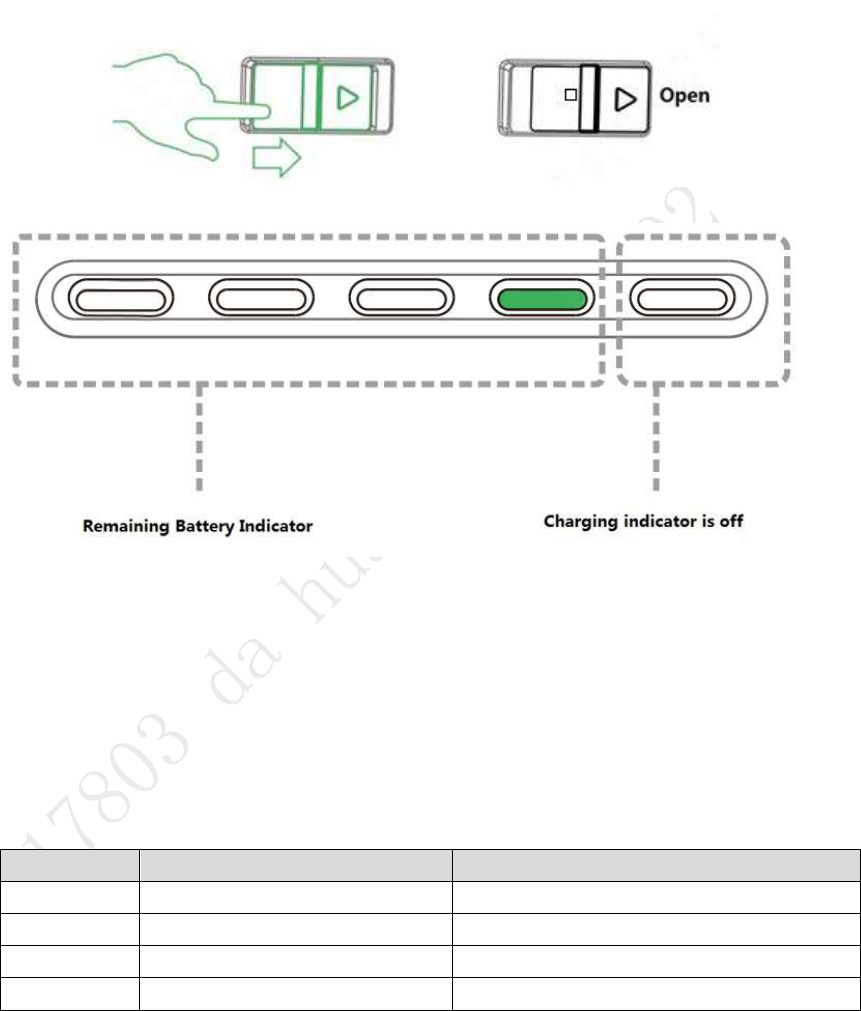
29
3.2.2 Remote Control
3.2.2.1 Remote Control Battery Check
Move the power switch to the arrow location; view the number of indicator lights which are on.
Figure 3-3
Figure 3-4
At normal temperature, the remaining power shall be ≥2.
Remaining power shall be ≥3 when the temperature is lower than -10℃.
3.2.2.2 Remaining Power of Remote Control
There are two statuses for each indicator light of remote control, which are normally on and off.
The following table describes remaining power percentage in different status, “●” means
normally on and “○” means off, as shown in Table 3-2。
No.
Indicator Light Status
Remaining Battery Percentage Range
1
●●●●~○●●●
100%~75%
2
○●●●~○○●●
75%~50%
3
○○●●~○○○●
50%~25%
4
○○○●~○○○○
25%~0
Table 3-2
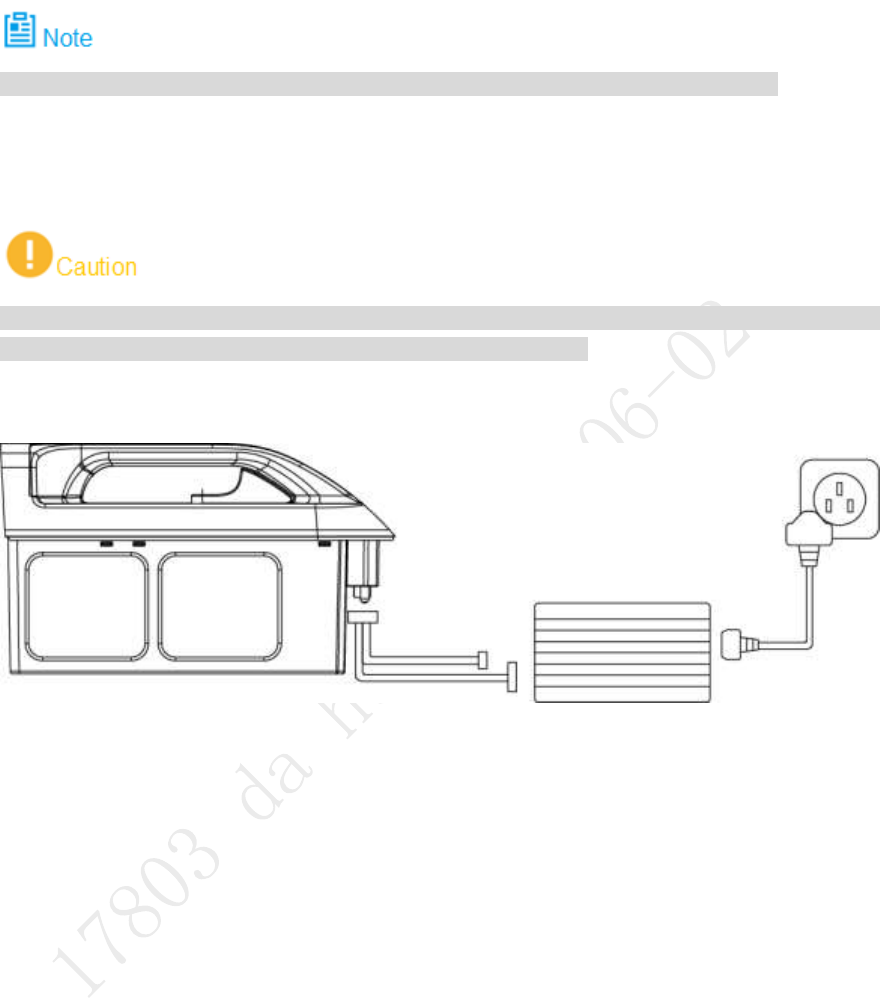
30
3.3 Charging
It doesn't need to implement the following chapter if the remaining power is enough.
3.3.1 Aircraft Battery Charging
During charging of power battery, charging is completed when the charger displays “FULL” and
beeps. Don’t take down batteries before charging is completed.
The entire charging period (from 0 to full) is about 2 hours. Charging period is related with
remaining power and charging current.
Figure 3-5
Take out the battery: open battery switch, and lift the battery vertically to take it out. Step 1
Connect AC: connect charger power wire with charger port, and connect AC power. Step 2
Connect DC: insert charging adapter cable into battery and charger port. Step 3
Select charging mode: open charger switch, turn the black button, select BLC and short Step 4
press the black button. The value displayed by LED nixie tube bounces and flashes.
Select charging current: turn the button to adjust current, whose proposed value is 20A. Step 5
After adjustment, short press the black button to confirm.
Open the battery: short press the battery indicator light button once, and then long Step 6
press it for 3 seconds, to turn on the electric quantity indicator light and check present
battery.
Long press the button to start charging and wait for the charger prompt. It means Step 7
charging is completed when the charger beeps for 5 times and LED nixie tube displays
FULL.
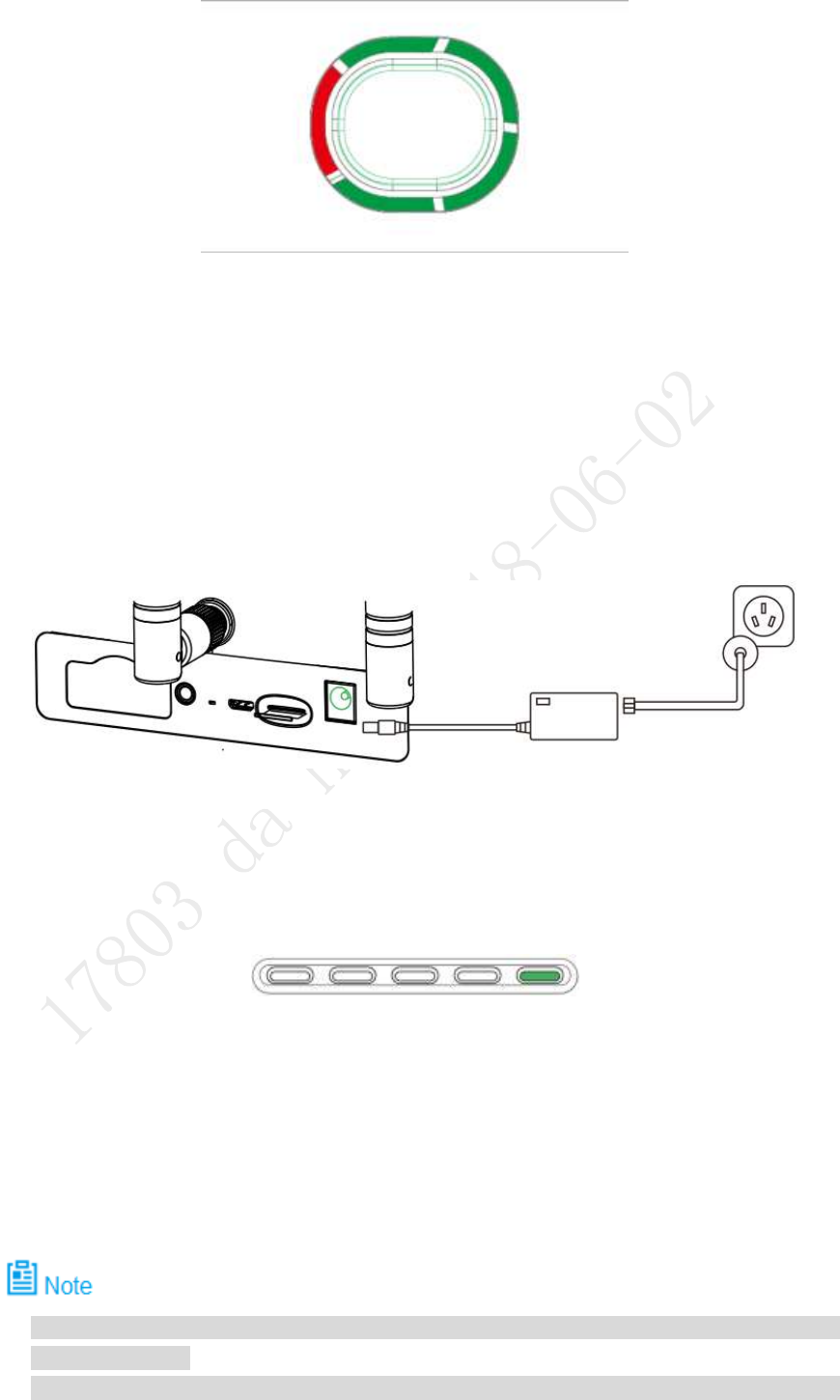
31
Figure 3-6
After charging is completed, disconnect it from the power socket, and then press stop Step 8
button on the charger to turn off the charger.
3.3.2 Remote Control Charging
The entire charging period (from 0 to full) needs approximately 3.5 hours.
Please charge the remote control when its power is off.
Connect DC: connect the remote control and power adapter with a charging cable. Step 1
Figure 3-7
Connect AC: connect power adapter with AC power (AC 100V- AC 240V). Step 2
Check charging state: it means the remote control is charging when the indicator light is Step 3
red and normally on. It means charging is done when the indicator light becomes green
and normally on, as shown in Figure 3-8.
Figure 3-8
Disconnect it from the power socket, and then disconnect other cables after charging is Step 4
completed.
3.4 Prepare Airborne Device
The following chapter is optional for operation. It is for your reference when airborne device
shall be replaced.
This chapter introduces operation of airborne device with PTZ camera as an example.
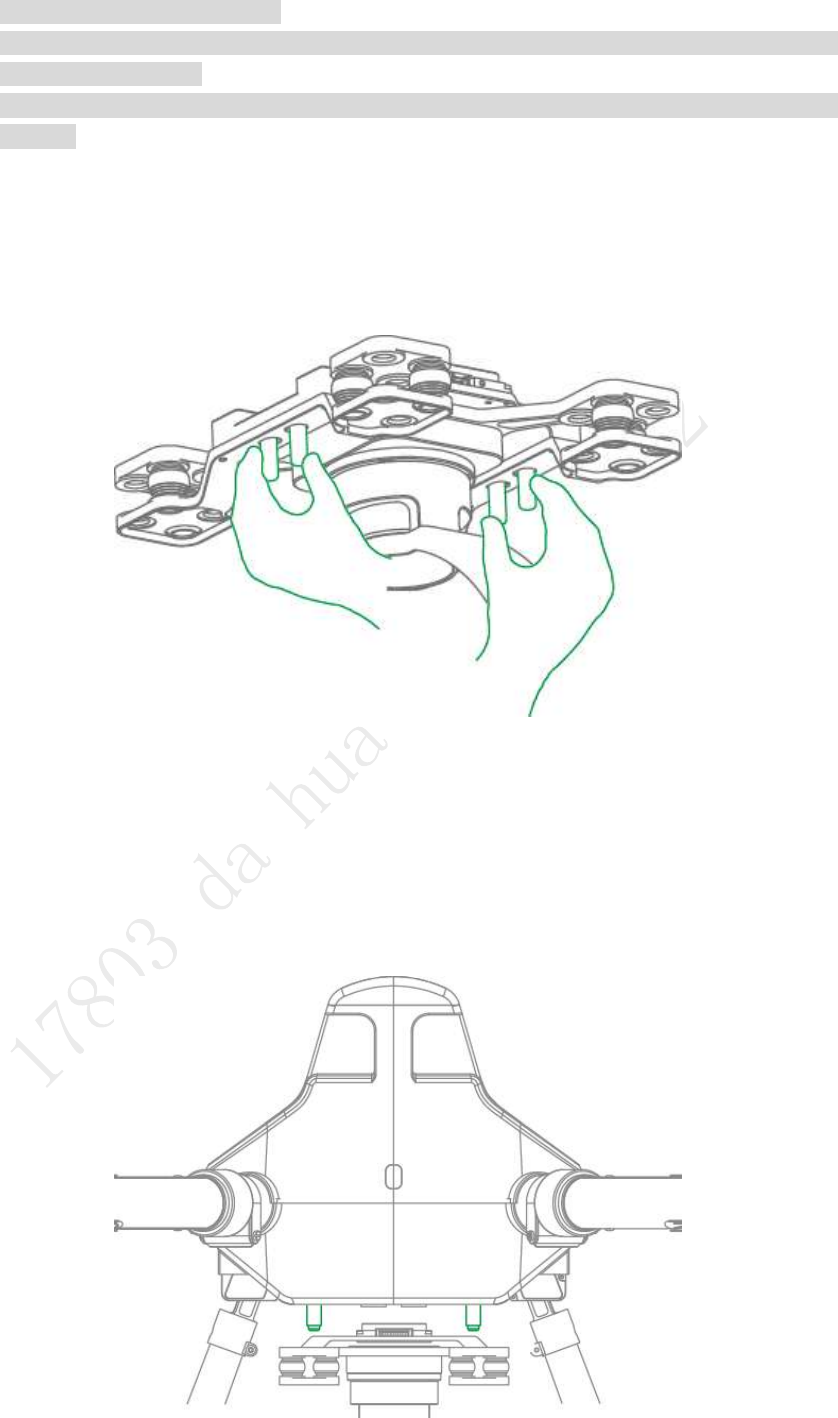
32
Please refer to actual product.
Please implement demounting step first and then connection step when the PTZ camera
needs to be replaced.
It only needs to implement demounting step when the aircraft flies directly without PTZ
camera.
3.4.1 Dismantle PTZ Camera
Hold 2 handles of the PTZ camera with both hands and pull them downwards, as Step 1
shown in Figure 3-9.
Figure 3-9
PTZ camera is separated from the aircraft, so it is dismantled quickly. Step 2
3.4.2 Install PTZ Camera
Insert the upper port on the vibration damper plate of the PTZ camera into Step 1
corresponding port at the bottom of the aircraft, as shown in Figure 3-10.
Figure 3-10
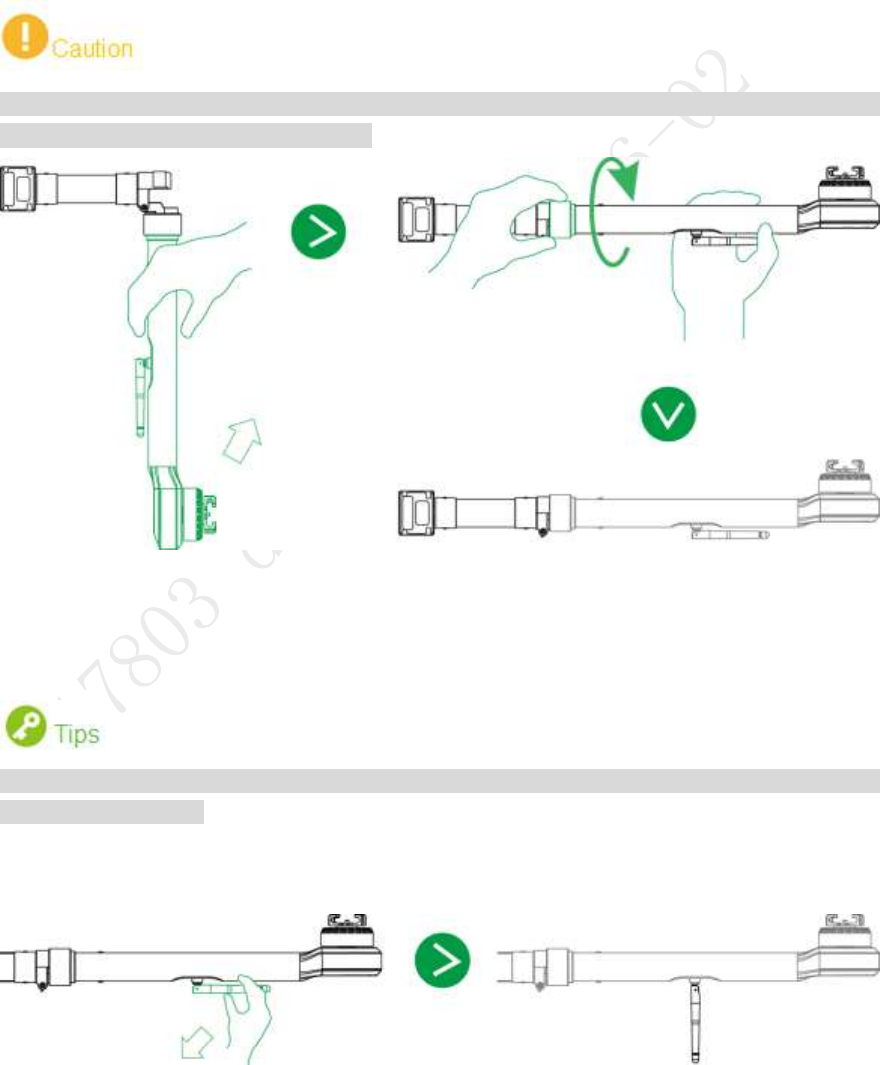
33
Push the PTZ camera upwards quickly, so PTZ installation is completed. Step 2
3.5 Prepare Aircraft
3.5.1 Unfold Arm
Unfold the arm to horizontal position. Hold the arm with left hand, and tighten helical casing with
right hand, so as to fix the arm horizontally, as shown in Figure 3-11.
The subsequent steps can be implemented only when the arm is fixed horizontally. Please
contact our company if the arm is loose.
Figure 3-11
3.5.2 Open Antenna
It is recommended to unfold the antenna to vertical position, in order to realize optimum
communication effect.
Unfold the aircraft antenna, move it to vertical position and make it firmly stuck, as shown in
Figure 3-12.
Figure 3-12
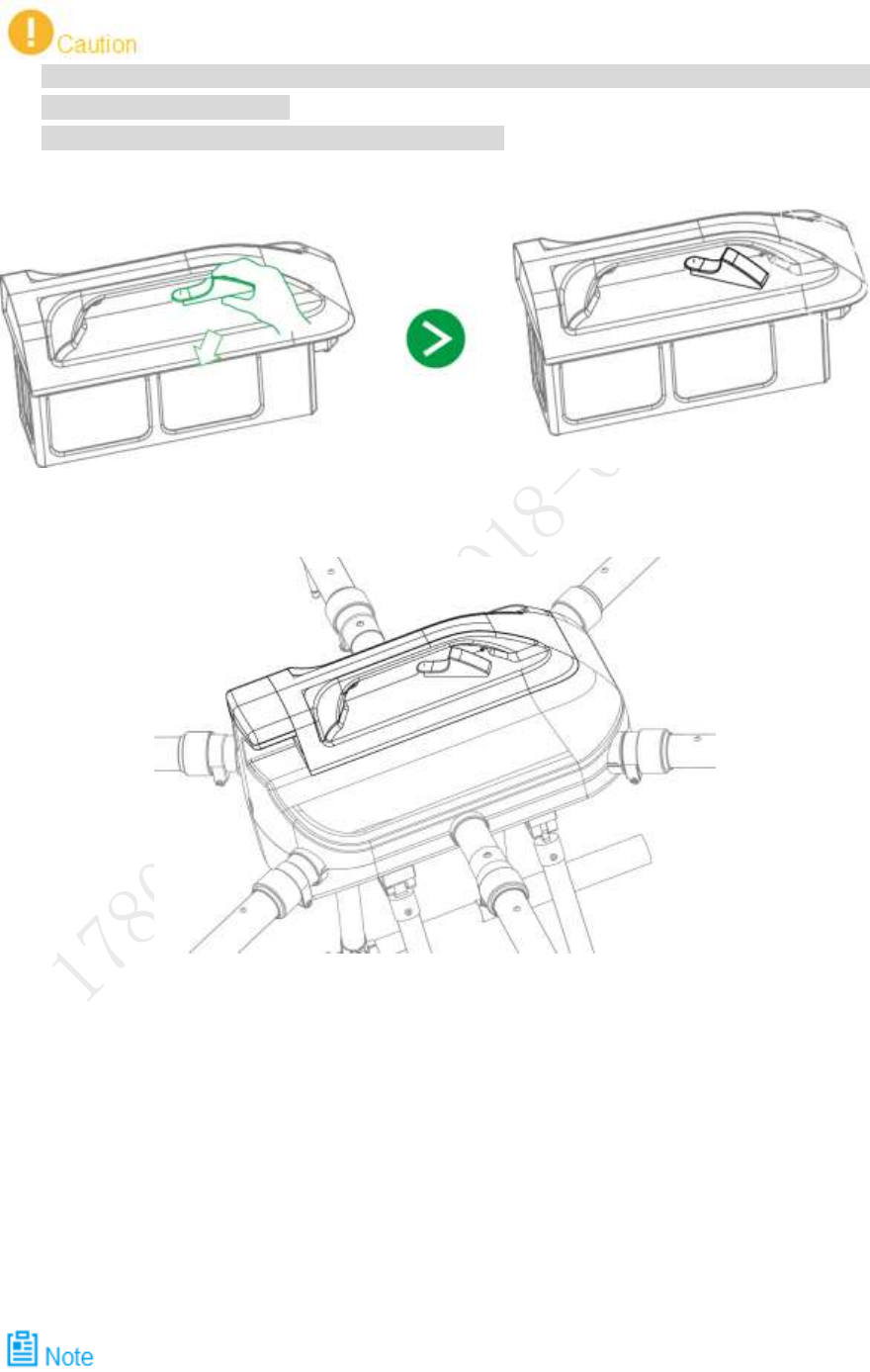
34
3.5.3 Install Aircraft Battery
After battery has been installed, battery buckle shall be fixed. Then, the aircraft can be
moved with battery handle.
If battery buckle is not fixed, the aircraft will fall off.
Open the battery buckle, as shown in Figure 3-13. Step 1
Figure 3-13
Put the battery into battery compartment horizontally, as shown in Figure 3-14. Step 2
Figure 3-14
Close the battery buckle, and aircraft battery installation has been completed. Step 3
3.6 Prepare Remote Control
3.6.1 Install Micro SD Card
Remote control owns about 3G memory space. Please choose and install micro SD Card
according to actual needs.
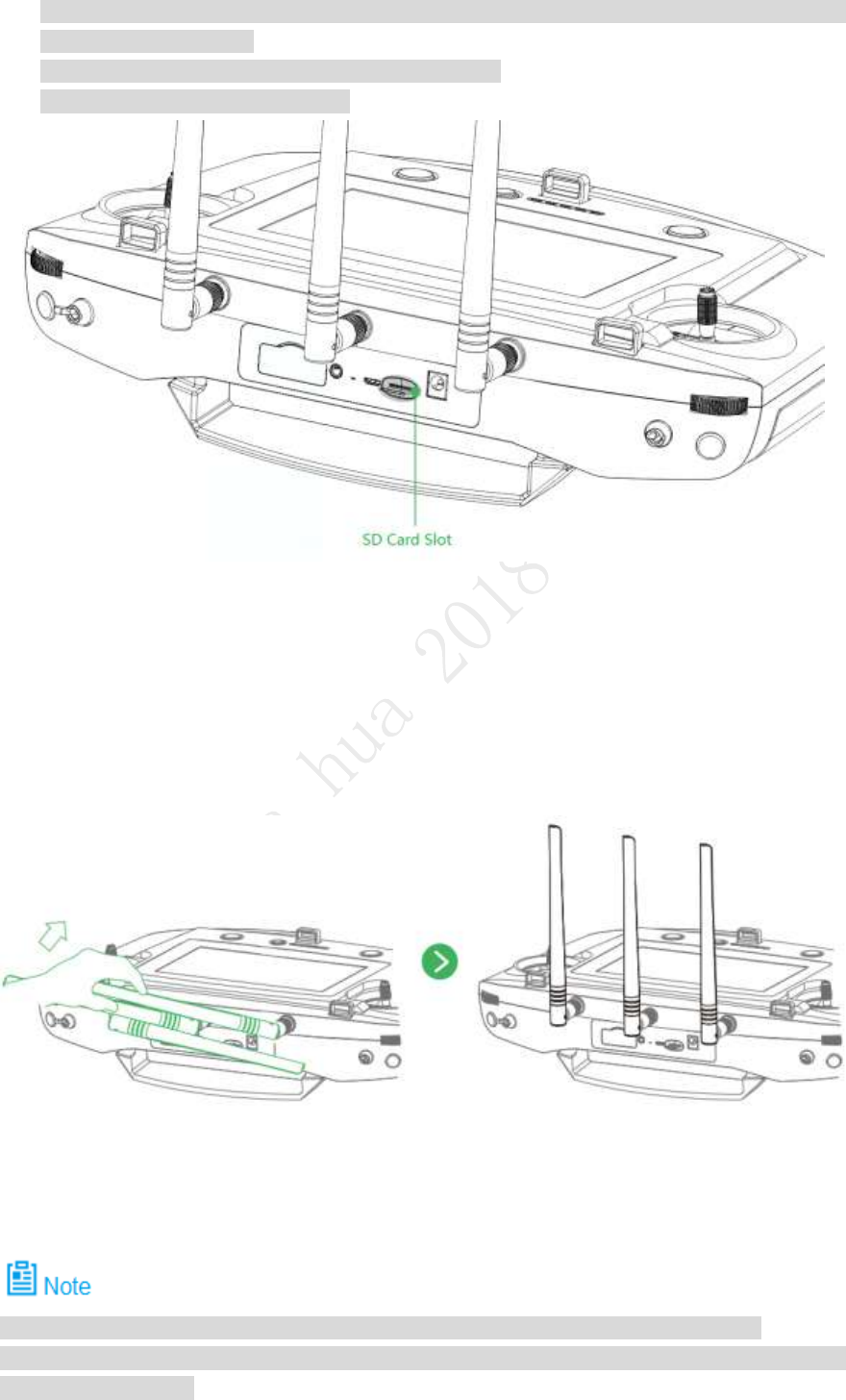
35
The following chapter is optional for operation. It is for your reference when the user needs
to install micro SD card.
Micro SD card needs to be configured on your own.
Micro SD card supports max. 16G.
Figure 3-15
Make the metal surface of micro SD card face downward and insert it into the micro SD card
slot of the remote control side panel horizontally.
3.6.2 Open Antenna
Open the antenna of remote control to proper location, as shown in Figure 3-16.
Figure 3-16
3.6.3 Enable Remote Control Power
Please skip the chapter if the power is not turned off after checking remaining battery.
Enable remote control power: move the power button of remote control to the arrow location, as
shown in Figure 3-17.
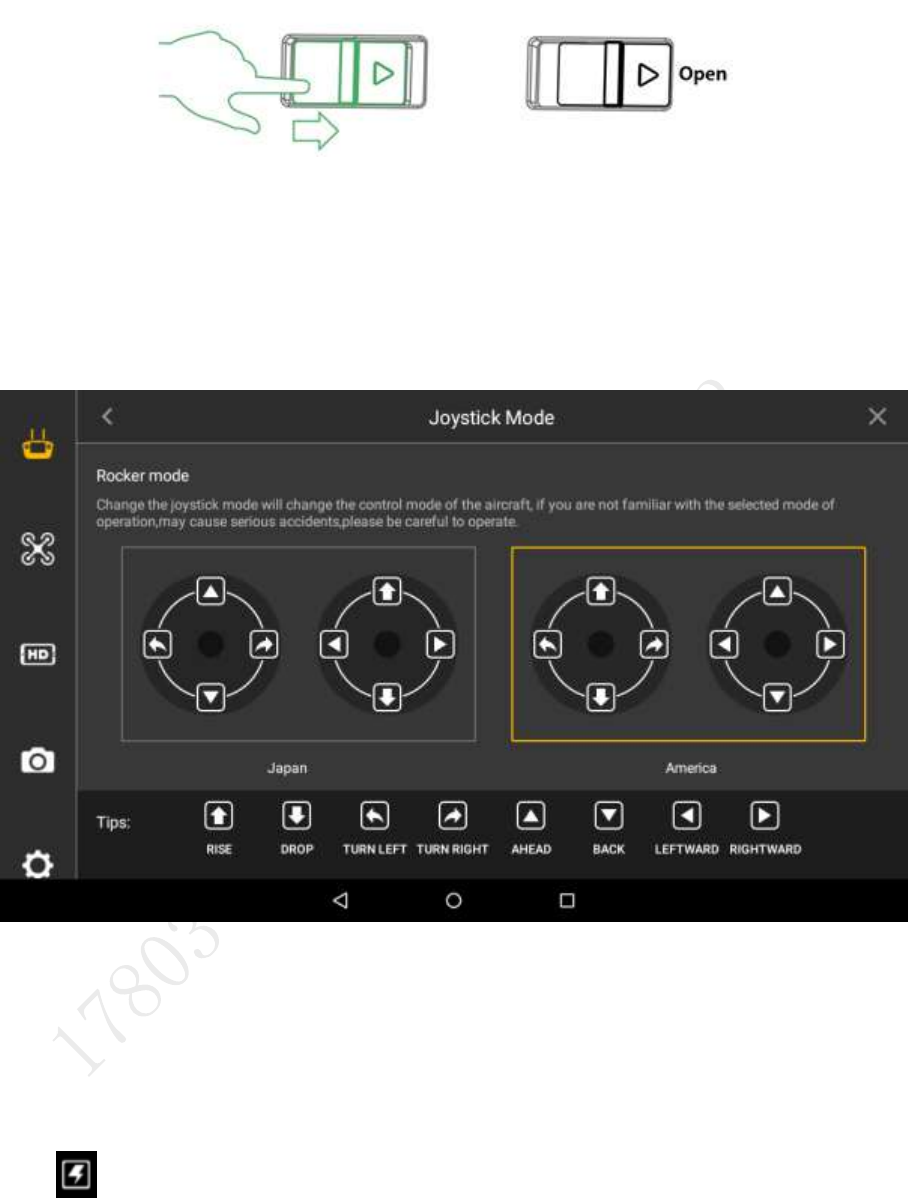
36
Figure 3-17
3.6.4 Confirm Remote Control Mode
It is mode 2 by default. Please set in “Settings > RC Settings > Joystick Mode” to switch mode,
as shown in Figure 3-18.
Figure 3-18
Please refer to “4.2.4 Manual Flight Control” for remote control mode and its corresponding
relations.
3.6.5 Set Quick Operation
Click at the upper right corner of main interface, set quick operation items of remote
control interface, view dashboard, and set PTZ, image transfer, flight task, flight path and stop
beep.
3.6.5.1 Dashboard
View parameters of remote control dashboard.
Click “Dashboard”, and the system enters “Dashboard” interface, as shown in Figure 3-19.
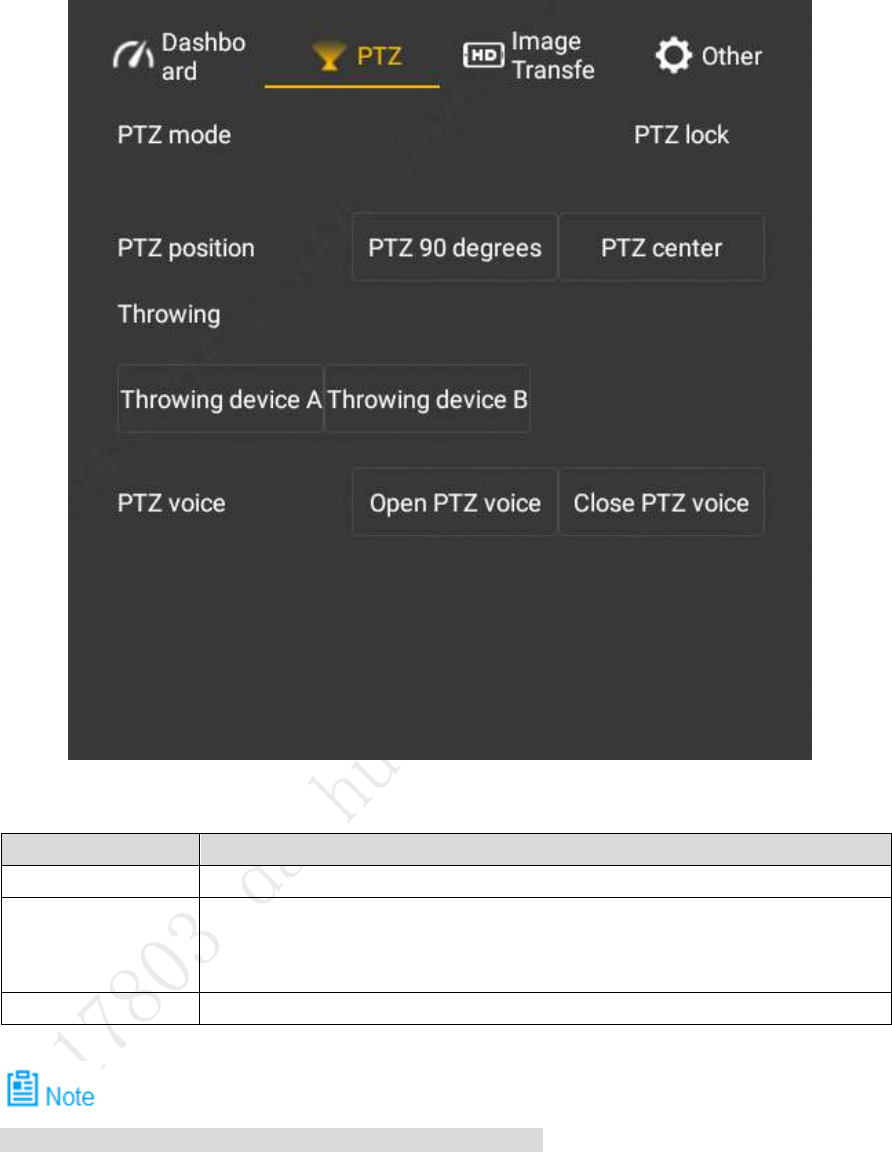
38
Figure 3-20
Set parameters according to actual needs. Please refer to Table 3-3 for details. Step 2
Parameter
Note
PTZ Mode
View present mode of PTZ.
PTZ Position
Set PTZ position, including PTZ 90 degrees and PTZ center.
PTZ 90 degrees: the camera is vertically downward.
PTZ center: the camera lens faces the front.
Throwing
Set throwing, including throwing device A and throwing device B.
Table 3-3
Click key A on the remote control, to carry out PTZ control.
3.6.5.3 Image Transfer
Set resolution ratio, frame rate and maximum bandwidth of preview image according to needs.
Select “Image Transfer”, and the system enters “Image Transfer” interface, as shown in Step 1
Figure 3-21.
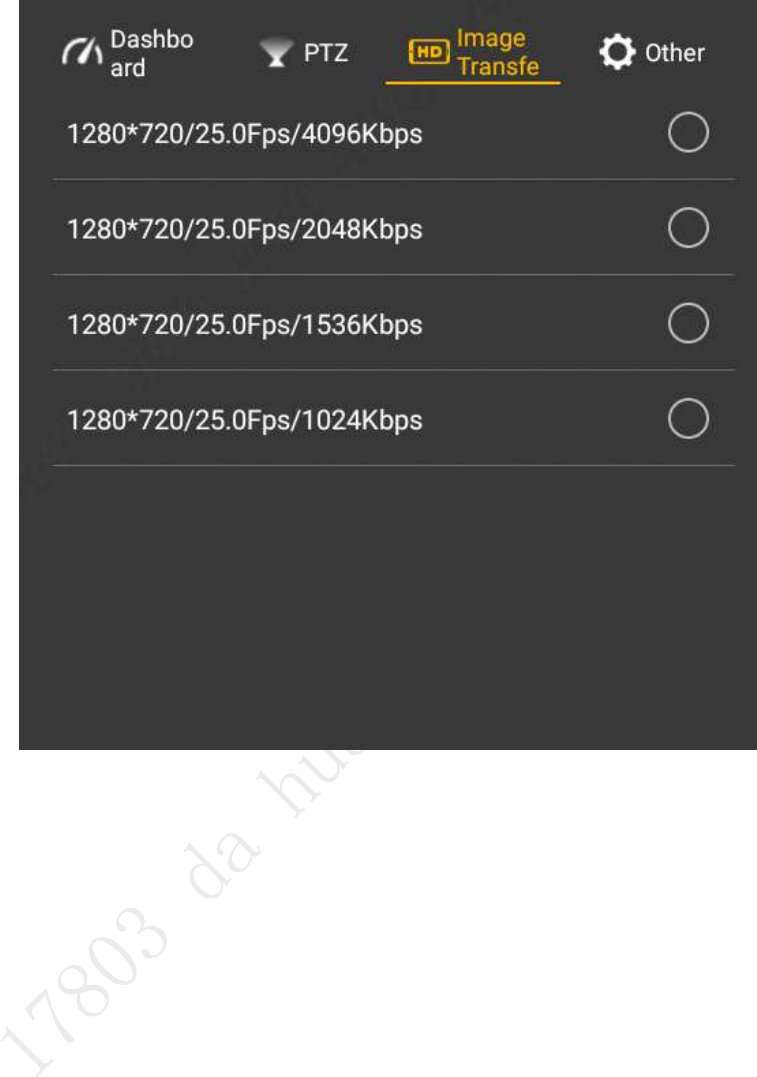
39
Figure 3-21
Select resolution ratio, frame rate and maximum bandwidth of preview image according Step 2
to actual needs.
3.6.5.4 Other
Set the flight task, flight path and stop beep here.
3.6.5.4.1 Fly Task
Set the flight task of remote control according to actual needs, including flight path and flight
time.
Select “Other > Flight Task”. Step 1
The system displays “Flight Task” interface, as shown in Figure 3-22.
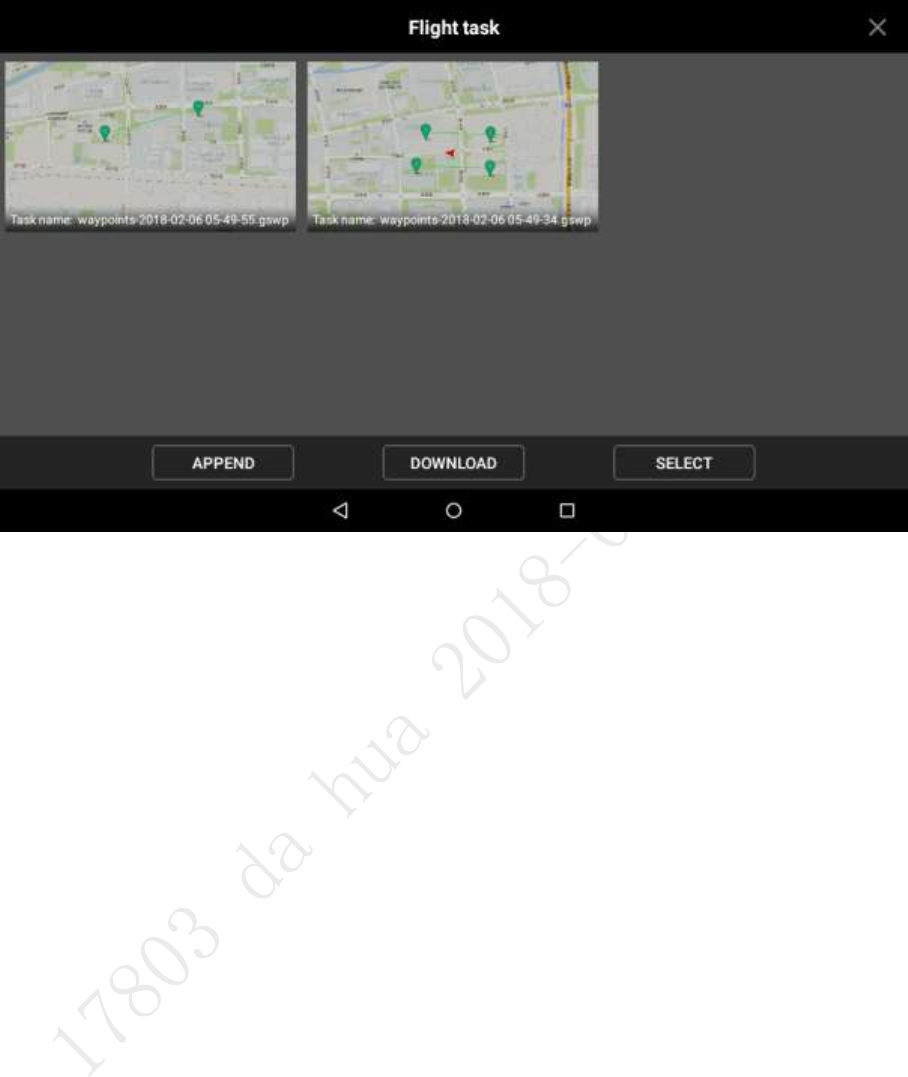
40
Figure 3-22
Configure flight task according to actual needs. Step 2
Append: click this icon to enter waypoint setting interface, set waypoint flight task
according to actual needs and save it.
Download: click this icon to download present saved flight path automatically.
Modify waypoint according to actual needs and save the task at remote control.
Select: click this icon to select one task or multiple tasks, and delete the task.
3.6.5.4.2 Flight Data
Save and delete the flight path data of the aircraft.
Select “Other > Flight Data”. Step 1
The system displays “Flight Data” interface, as shown in Figure 3-23.
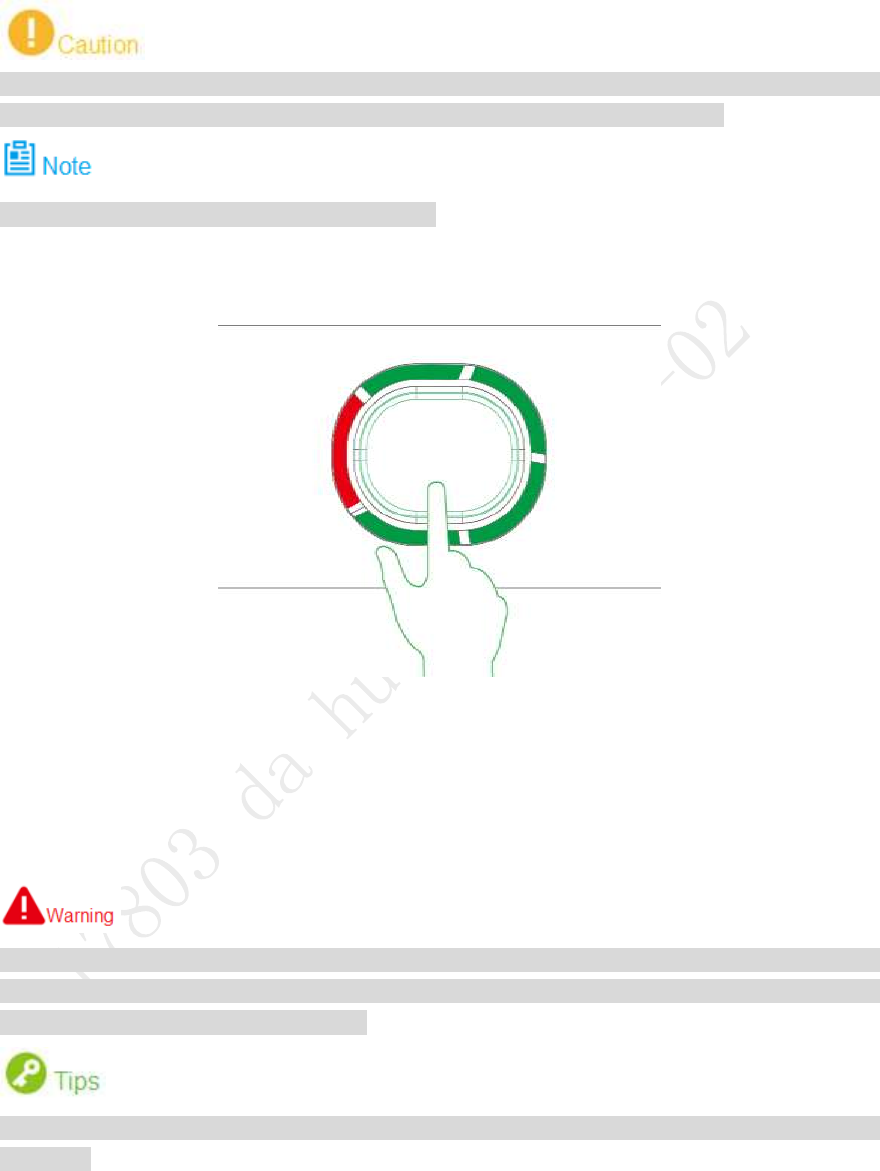
42
3.7 Enable Aircraft Power
After power on, when the remote control doesn’t require other operations, please always keep
the aircraft horizontal and static; otherwise, it may result in initialization failure.
The battery is full if 4 indicator lights are green.
Insert intelligent battery of the aircraft, short press power switch, and green indicator light
indicates present battery electricity, as shown in Figure 3-25.
Figure 3-25
3.8 Check and Debugging
The subsequent steps can be implemented only after checking and debugging all the items
listed in the chapter below. Besides, the remote control prompts that each state is normal and
the aircraft indicator light flashes green.
It is recommended to set the display image of remote control as video preview mode before
taking off.
Check operation condition. Please debug each component to make it operate normally when
both remote control prompts abnormity.
It is going to list common calibration items, abnormities and solutions in the following chapter.
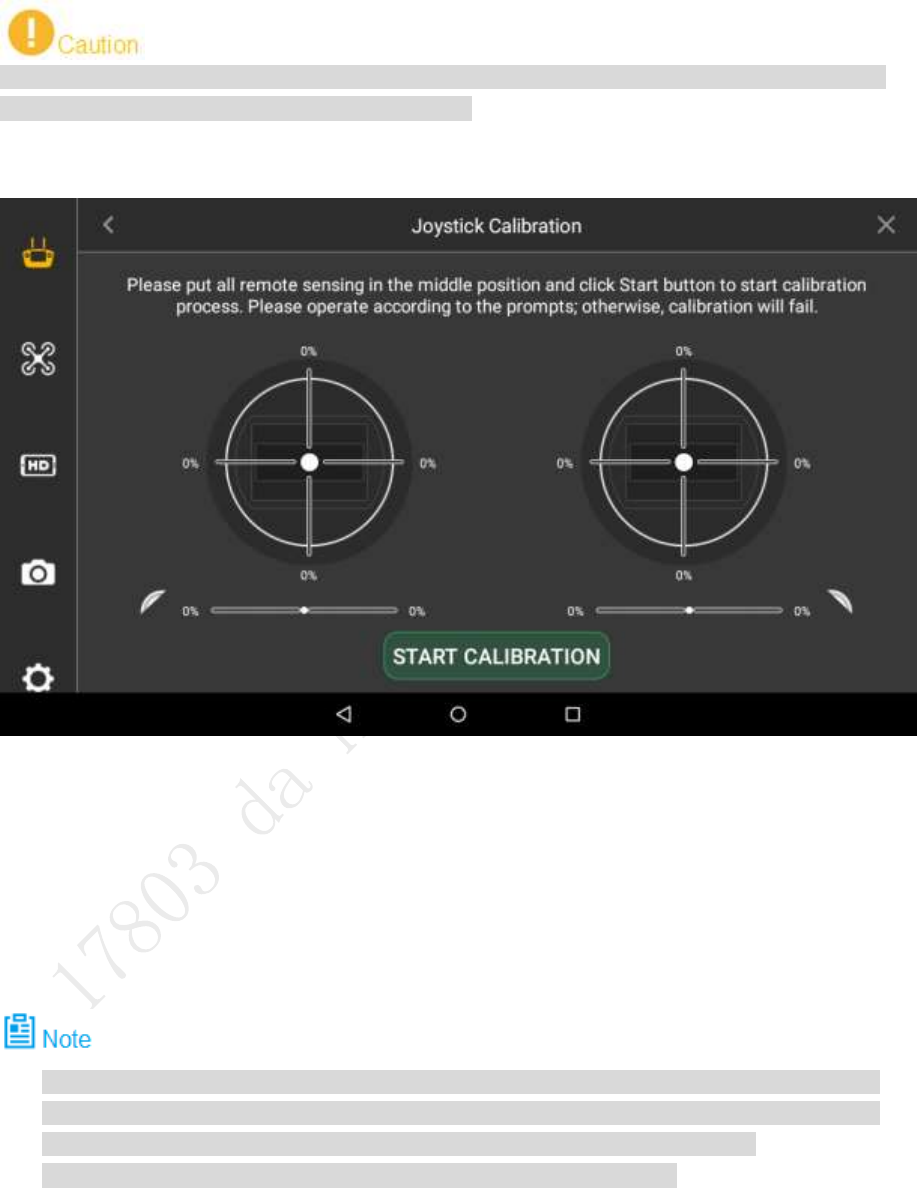
43
3.8.1 Remote Control Calibration
If it isn’t turned to maximum value end, it may not respond to operation, operation is not smooth,
and the aircraft may even explode after calibration.
Select “Settings > Remote Control Settings> Joystick Calibration”. Step 1
The system displays “Joystick Calibration” interface, as shown in Figure 3-26.
Figure 3-26
Move both the left and right joysticks back to the middle. Step 2
Click “Start Calibration”. Step 3
Turn two joysticks and turn to the maximum value end of each direction for several Step 4
times.
Slide the rolling wheels on both sides, slide to the maximum value end of two directions Step 5
for several times.
Click “Complete Calibration” after turning the rolling wheels and joysticks. Step 6
After calibration, view “3.6.5.1 Dashboard“, and turn corresponding buttons to confirm if
calibration is successful. After successful calibration, each parameter is about 1514.
Turning the endpoint, maximum value is 19XX while minimum value is 10XX.
The remote control can be normally used about 30s after calibration.
3.8.2 Accelerometer Calibration
Select “Settings > General > Other > Accelerometer Calibration” to enter “Accelerometer
Calibration” interface, as shown in Figure 3-27.
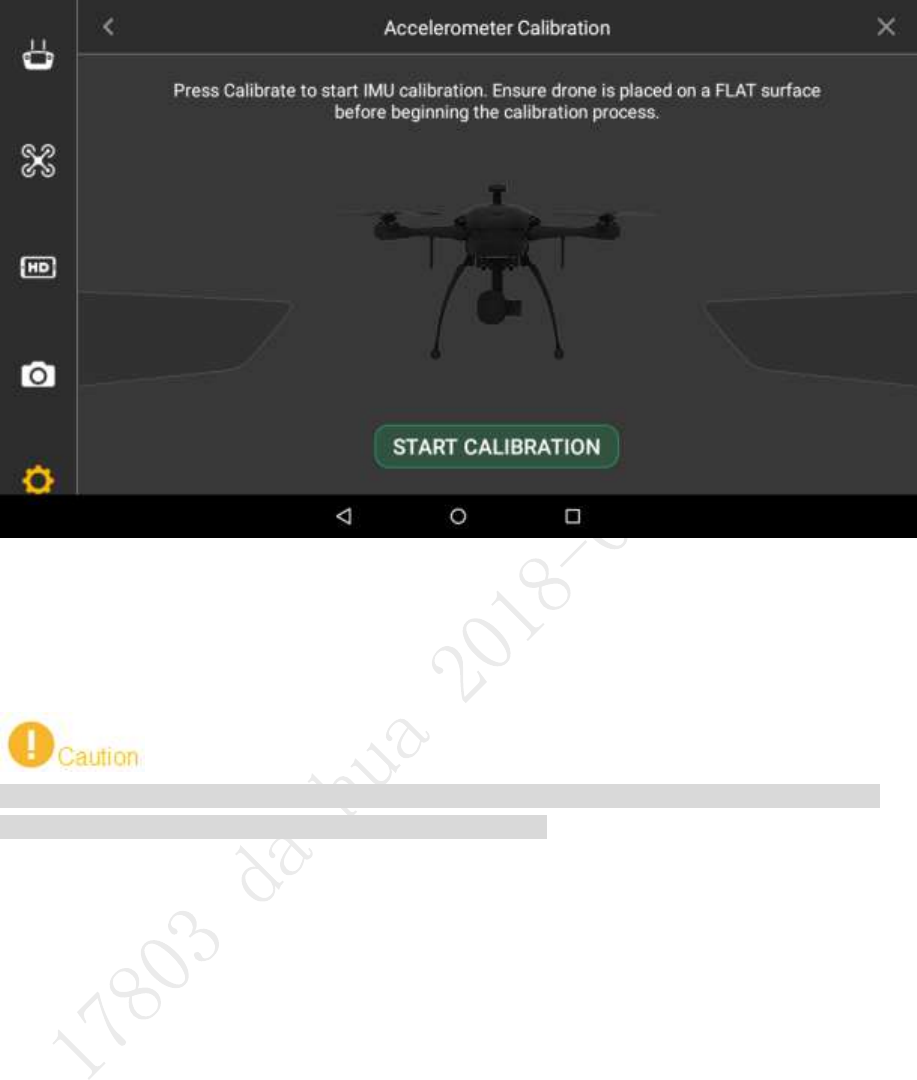
44
Figure 3-27
Place the aircraft on a flat surface, and click “Start Calibration”.
The remote control will prompt “Calibration Success” if it is successfully calibrated.
The remote control will prompt “Calibration Failure” if it fails to calibrate. Click “Retry” till it
is successfully calibrated.
Pay attention to levelness and perpendicularity during calibration. Non-standard posture during
calibration will lead to abnormal flight and even explosion.
3.8.3 Initialization Failure
Abnormity Prompt
Remote control prompts “Initialization Failure”.
Possible Reasons
After power on and before taking off, it may result in initialization failure if you move the aircraft.
Solutions
Power on the aircraft again after the power is cut off, and keep the aircraft horizontal and static
during initialization. Please contact our company if initialization fails for several times.
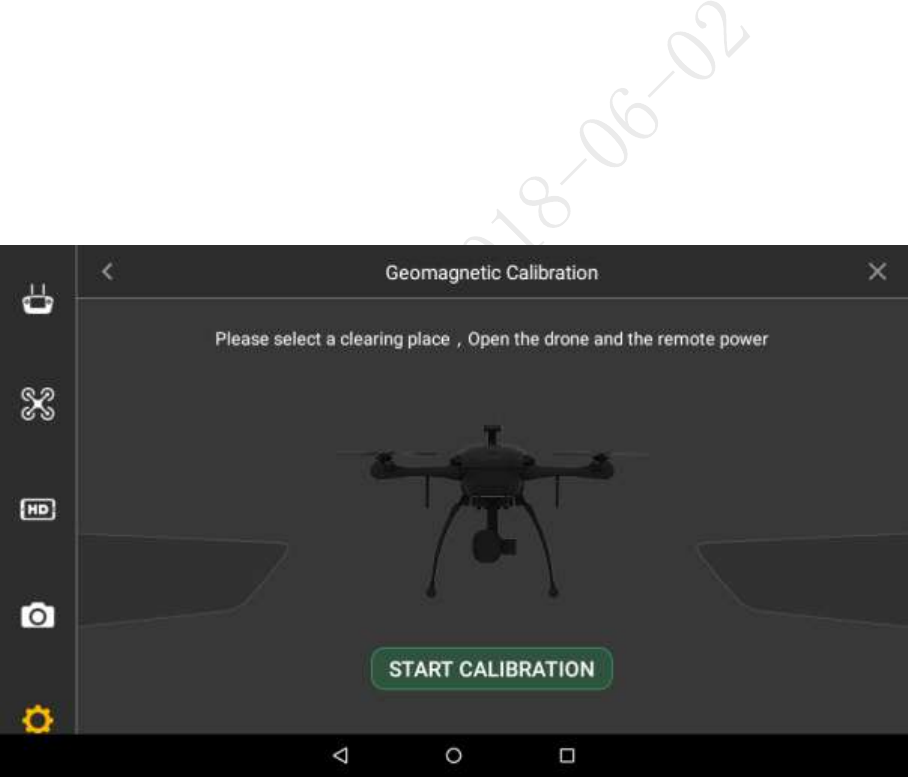
45
3.8.4 Geomagnetic Abnormity
Abnormity Prompt
Aircraft indicator ●●● flashes.
Remote control prompts “Geomagnetic Abnormity”.
Possible Reasons
The use position has changed a lot, which means the geographical location is quite far
away from the last geographical location where the aircraft is used, causing big change to
geomagnetic field.
There is another intensive magnetic field or abrupt change in the environment, affecting
geomagnetic field.
Solutions
Select “Settings > General > Other > Geomagnetic Calibration” on the remote control. Step 1
The system displays “Geomagnetic Calibration” interface, as shown in Figure 3-28.
Figure 3-28
Click “Start Calibration”. Step 2
Keep the aircraft horizontal and rotate it for 360° horizontally, as shown in Figure 3-29. Step 3
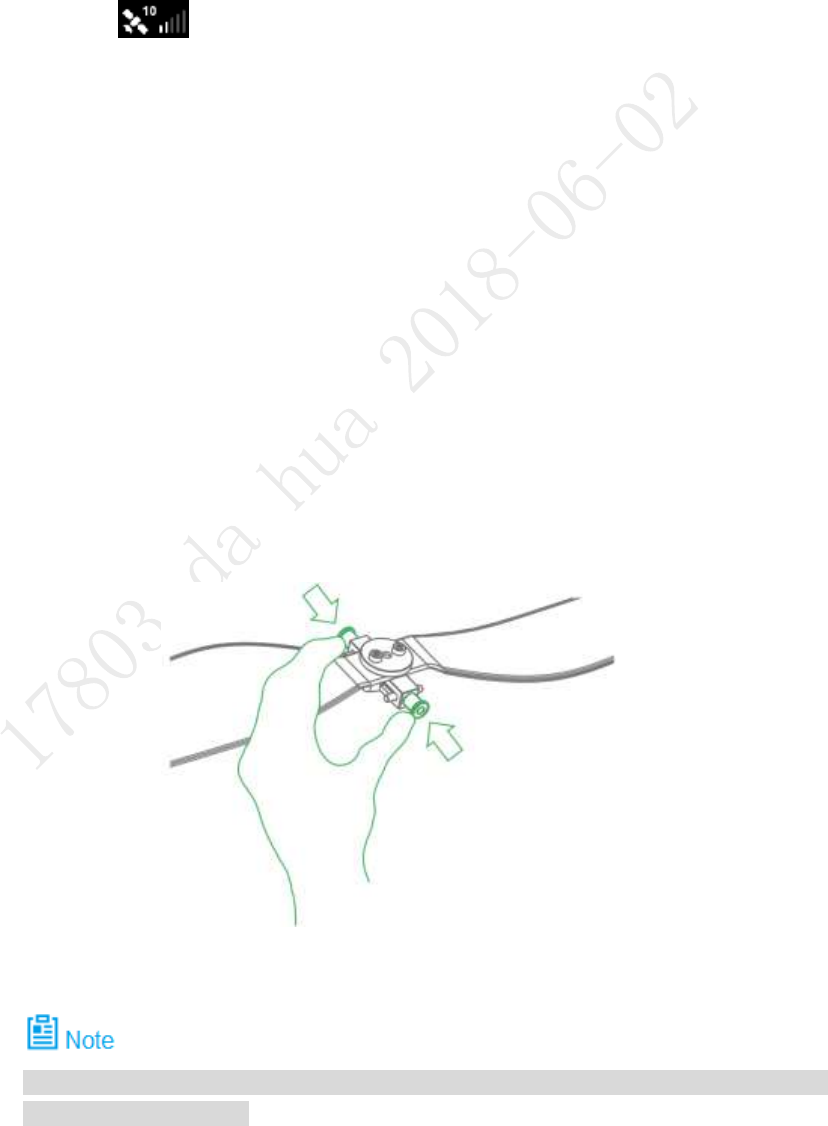
47
It will prompt geomagnetic calibration success if it is successfully calibrated.
It will prompt geomagnetic calibration failure if it fails to calibrate. Repeat Step 2, 3
and 4 to calibrate again.
3.8.5 GPS Satellites Insufficiency
Abnormity Prompt
Displayed number of satellites of remote control is less than 6.
GPS HDOP: at the top status bar of remote control is less than 1 bar or there is
no signal.
Possible Reasons
The flying environment is not wide open enough, which is severely blocked.
There is some other interference around the surroundings.
Solutions
Move the aircraft to a wider area and wait for 30s.
3.9 Install Propellers
Press the spring buckle on both sides of the propeller center, as shown in Figure 3-31. Step 1
Figure 3-31
Buckle the latch on the motor, as shown in Figure 3-32. Step 2
Structures of 2 types of propellers are different. Adjust to the adjacent motor position to
install if it fails to buckle.
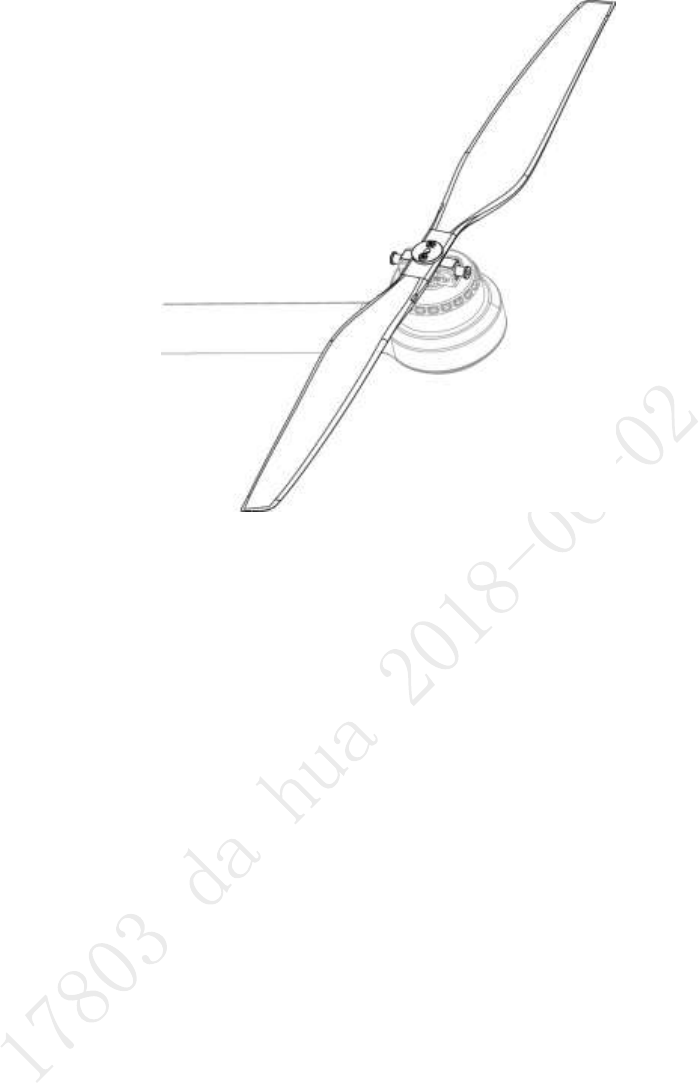
48
Figure 3-32
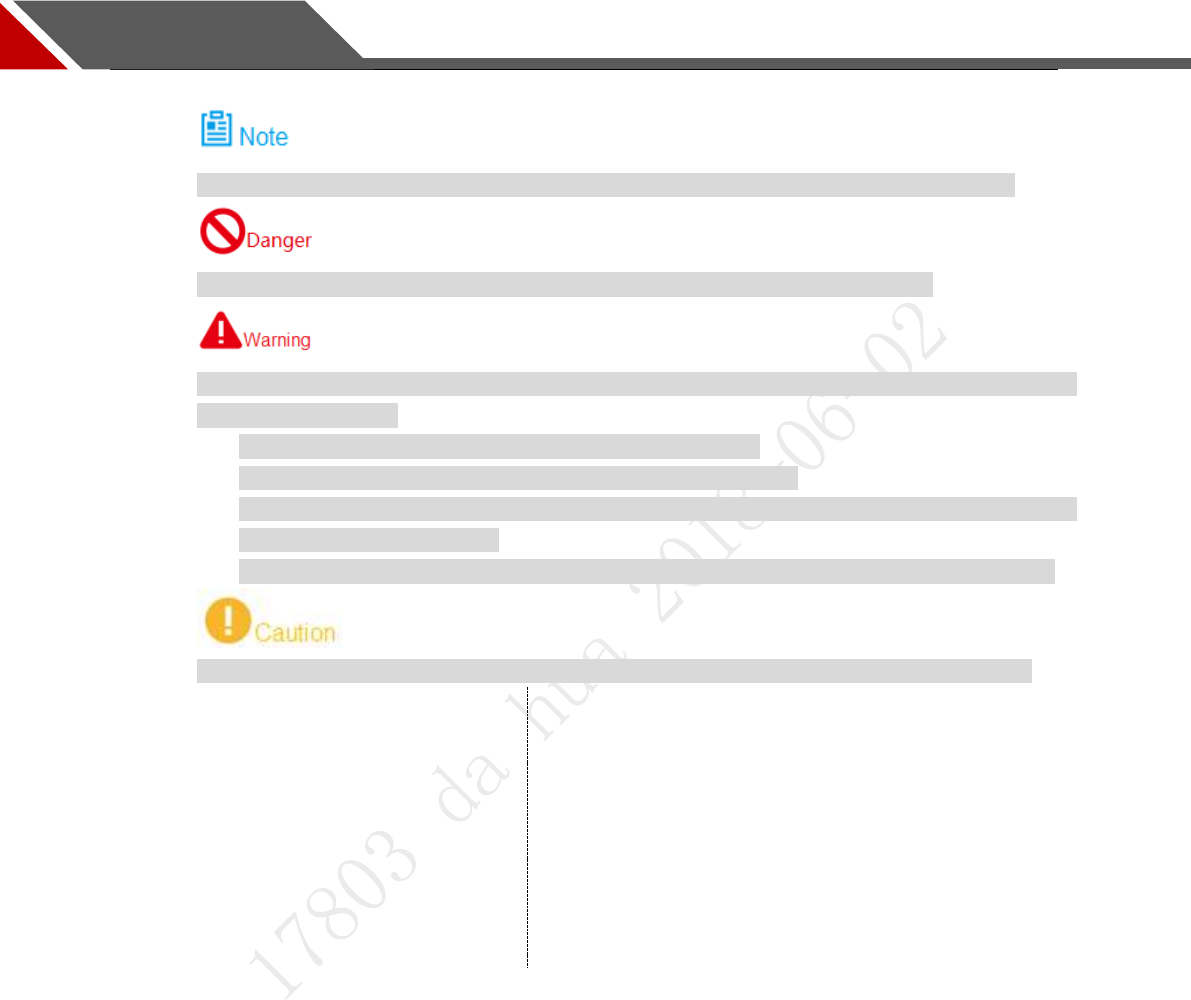
49
4 Enable Flight
This chapter will elaborate the complete flow of formal takeoff and landing of the aircraft.
Please stay away from the rotating propellers or motor, to avoid personal injury.
For your personal and property safety, please make sure to check the following items carefully
before enabling flight.
Flight preparations listed in Chapter 3 are all completed.
All the components have been correctly and stably installed.
Make sure that each spare part is in good condition. Please do not fly the aircraft if some
parts are aged or damaged.
Flight environment meets the requirements listed in important safeguards and warnings.
Please do not block the ventilation near heat dissipation hole when the motor is operating.
Enable Flight
Unlock
↓
Take off
↓
Flight
↓
RTH and Landing
↓
Lock
Figure 4-1
This chapter will introduce manual and intelligent flight mode separately.
Switch between these two modes. For example, you can use one-key takeoff and landing
buttons in the manual flight mode.
4.1 Flight Mode
Control flight mode via driving lever during flight phase, as shown in Figure 4-2.
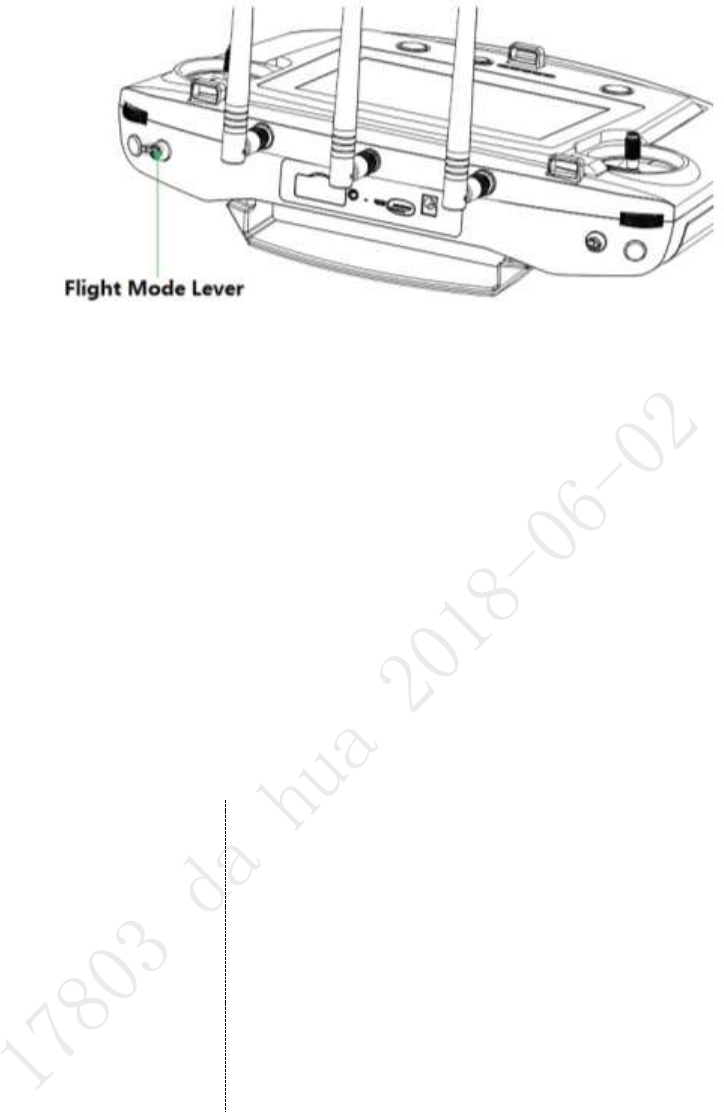
50
Figure 4-2
Three-level driving lever:
Upper level: Intelligent flight mode. The aircraft will fly automatically according to the
pre-set flight route.
Medium level: It is the fixed height flight mode in manual flight mode. The aircraft will
maintain the current flight height when the throttle joystick is in the middle.
Lower level: Fixed point flight mode in manual flight mode. The aircraft will maintain the
current location when all sticks are located in the middle.
4.2 Manual Mode
4.2.1 Introduction to Manual Flight Flow
Manual Flight Mode
Manual Unlock
↓
Manual Takeoff (One Key Takeoff)
↓
Manual Flight Control
↓
Manual RTH and Landing (One Key RTH and
Landing)
↓
Manual Lock (Auto Lock Available)
Figure 4-3
4.2.2 Unlock Flight Control
Move the left joystick to lower left, meanwhile move the right joystick to lower right (or move the
left joystick to lower right, meanwhile move the right joystick to lower left), and keep the status
for 2s. At this moment, the propellers are unlocked and start to rotate. Move all the sticks back
to middle, as shown in Figure 4-4.
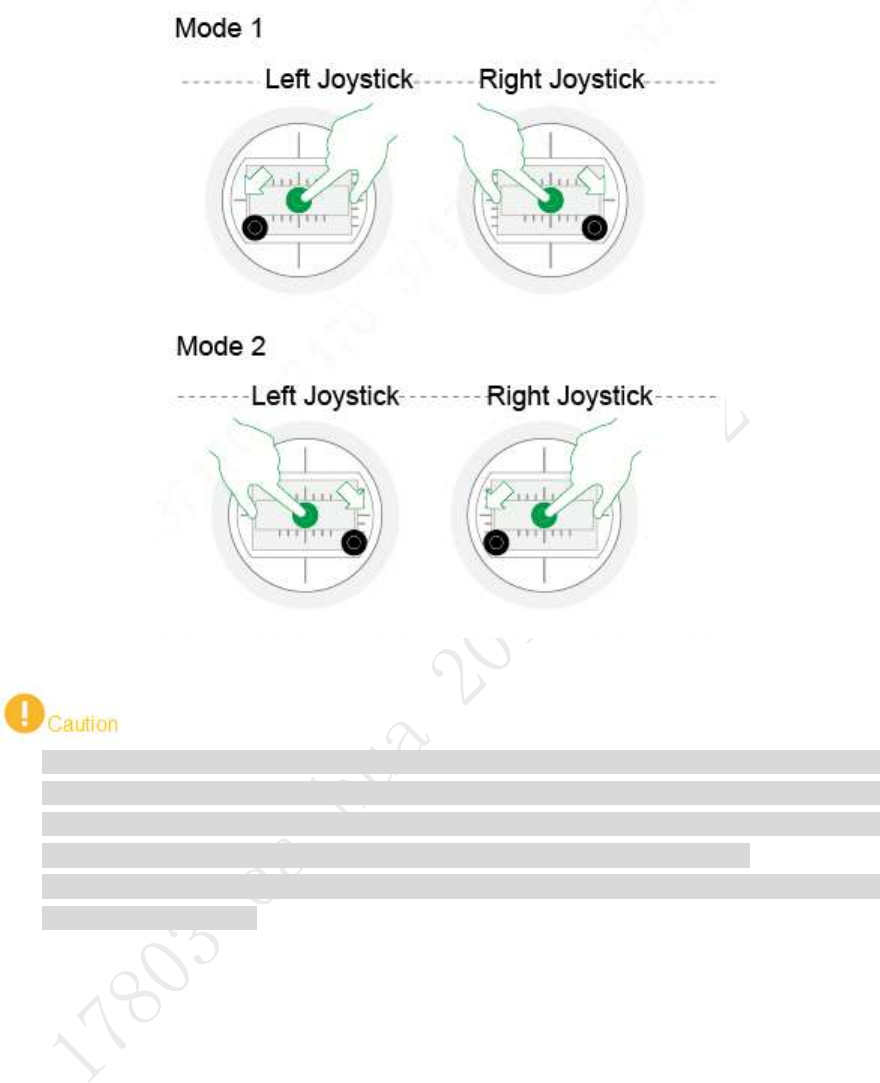
51
Figure 4-4
If there is obvious difference about rotating speed of the propellers, move the left joystick to
lower left and meanwhile move the right joystick to lower right (or move the left joystick to
lower right, and meanwhile move the right joystick to lower left), and then keep the status
till the propellers stop rotating. Turn off the aircraft and contact our company.
The aircraft will be automatically locked if it stays on the ground and doesn’t take off within
10s after it is unlocked.
4.2.3 Manual Takeoff
Slightly push the throttle to mid-point or higher, as shown in Figure 4-5.
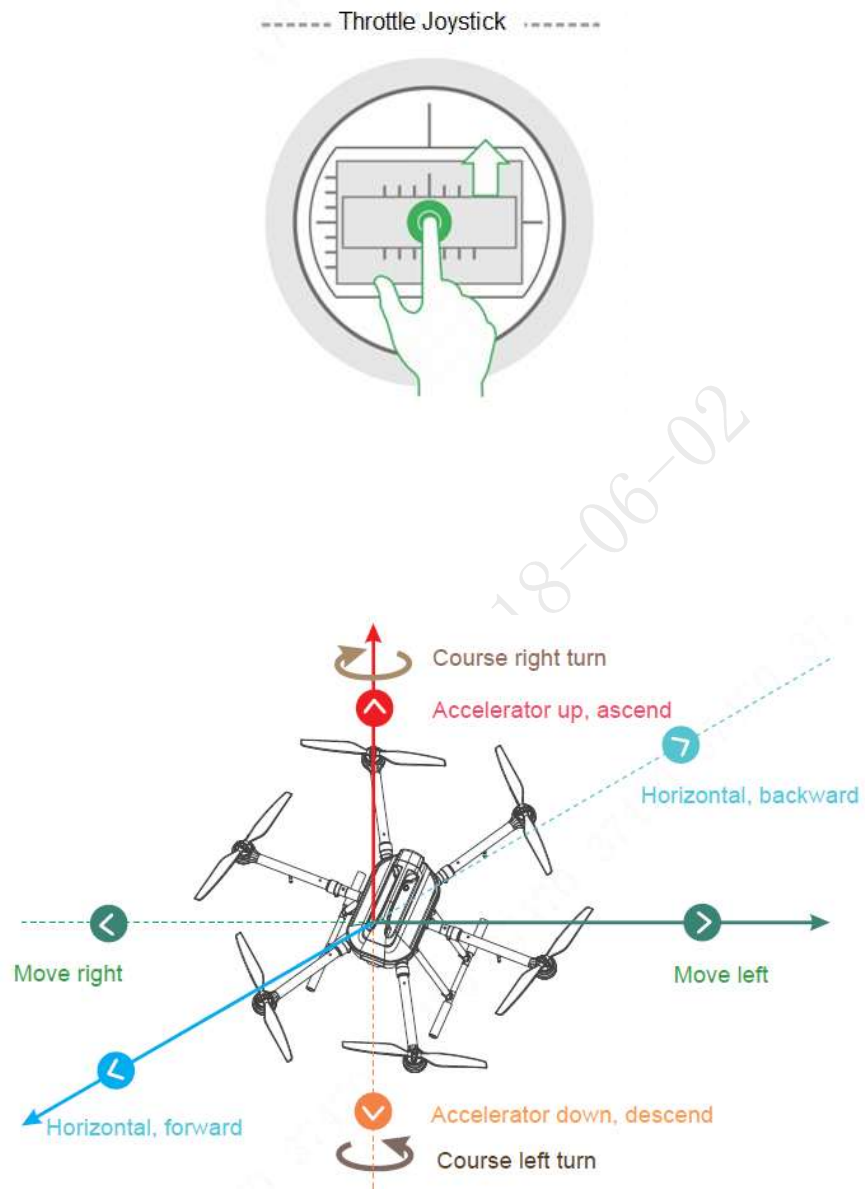
52
Figure 4-5
4.2.4 Manual Flight Control
Set remote control mode and control flight direction of the aircraft.
Figure 4-6
The joystick presets two remote control modes.
It is mode 2 by default. Please modify in “Settings > Remote Control Settings > Joystick Mode”
to switch to mode 1.
Mode 1:
Vertical direction of left joystick is pitching joystick, which controls the aircraft to go
forward and backward horizontally.
Horizontal direction of left joystick is course joystick, which controls the aircraft to
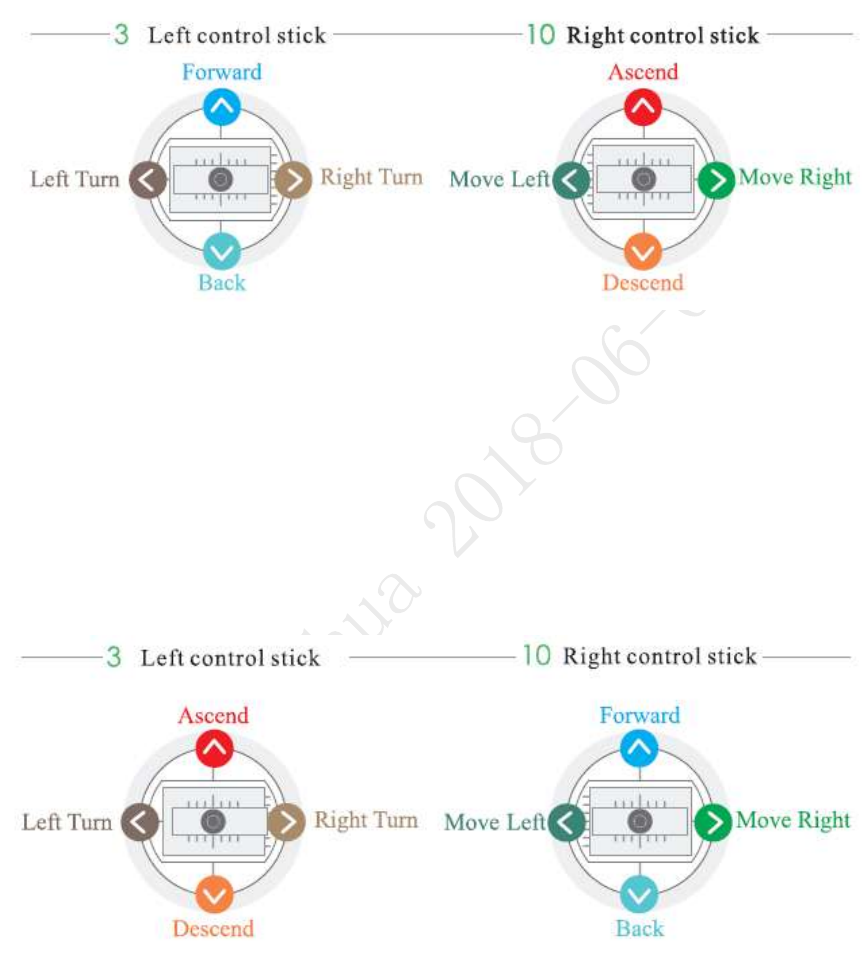
53
make left and right turn horizontally.
Vertical direction of right joystick is throttle joystick, which controls the aircraft to
ascend and descend.
Horizontal direction of right joystick is rolling joystick, which controls the aircraft to
move left and right horizontally.
Figure 4-7
Mode 2:
Moving the left joystick up and down (throttle joystick) to control aircraft’s ascending
and descending.
Moving the left joystick left and right (course joystick) to control aircraft’s left and right
turn horizontally.
Moving the right joystick up and down (pitching joystick) to control aircraft’s forward
and backward movement horizontally.
Moving the right joystick left and right (rolling joystick) to control aircraft’s left and right
movement horizontally.
Figure 4-8
4.2.5 Manual RTH and Landing
Manual RTH: Control the aircraft to hover over a proper landing point.
Manual landing: Reduce the throttle to make the aircraft land slowly.
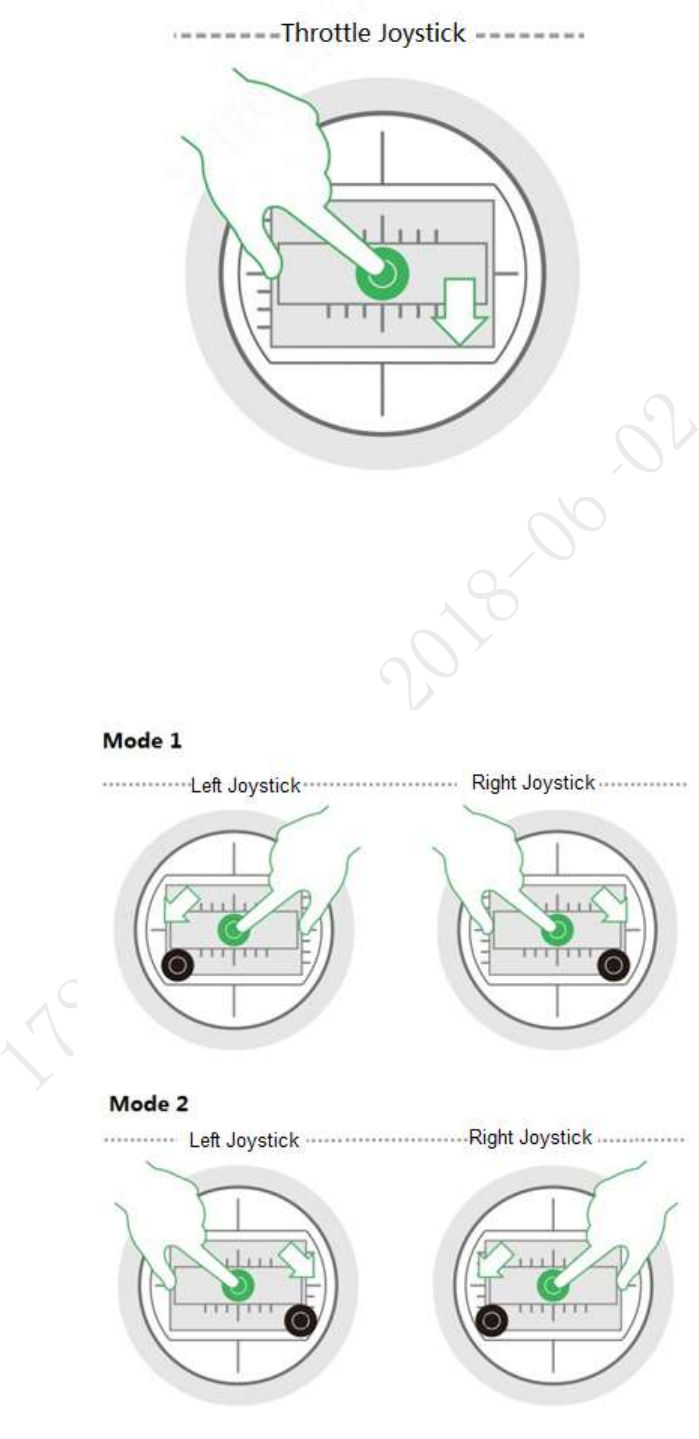
54
Figure 4-9
4.2.6 Manual Locking
Move the left joystick to lower left and move the right joystick to lower right at the same time (or
move the left joystick to lower right and move the right joystick to lower left at the same time).
Figure 4-10
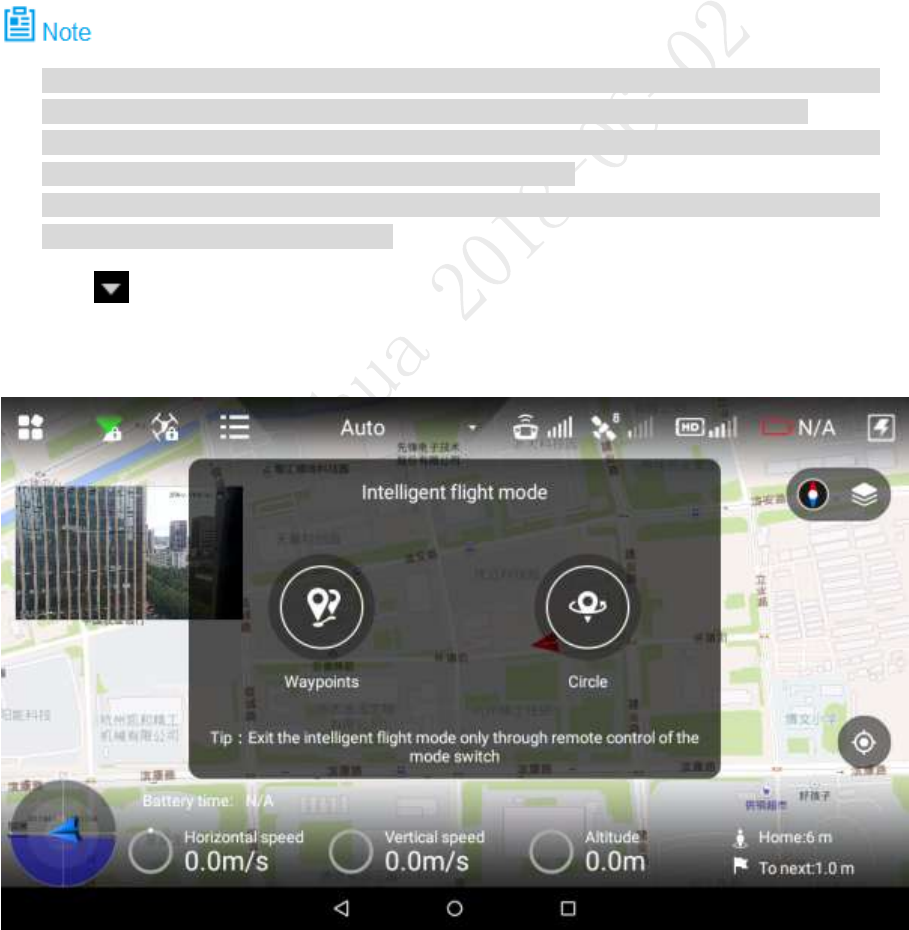
55
4.3 Intelligent Mode
4.3.1 Intelligent Flight Mode
Intelligent flight mode includes waypoints and circle around point of interest.
Waypoints flight: Set waypoint flight mission according to requirements. Move the flight
mode joystick at right rear of remote control to intelligent mode after the aircraft takes off,
select proper flight mission and click “Start Mission”.
Circle (around point of interest) flight: Set circle flight mission according to requirements.
Move the flight mode joystick at right rear of remote control to intelligent mode after the
aircraft takes off, select proper flight mission and click “Start Mission”.
When the flight mode joystick of remote control is moved to any mode (point, elevation or
intelligent mode), you can set waypoint flight or circle flight and save flight mission.
The aircraft is allowed to implement flight mission only when the flight mode joystick of
remote control is moved to the intelligent mode (Mode F).
It can realize waypoint flight or point of interest circle flight only after the aircraft takes off,
and it can't be realized on the ground.
Click the button on the main interface of the remote control, and enter the interface of
intelligent flight mode, as shown in Figure 4-11.
Figure 4-11
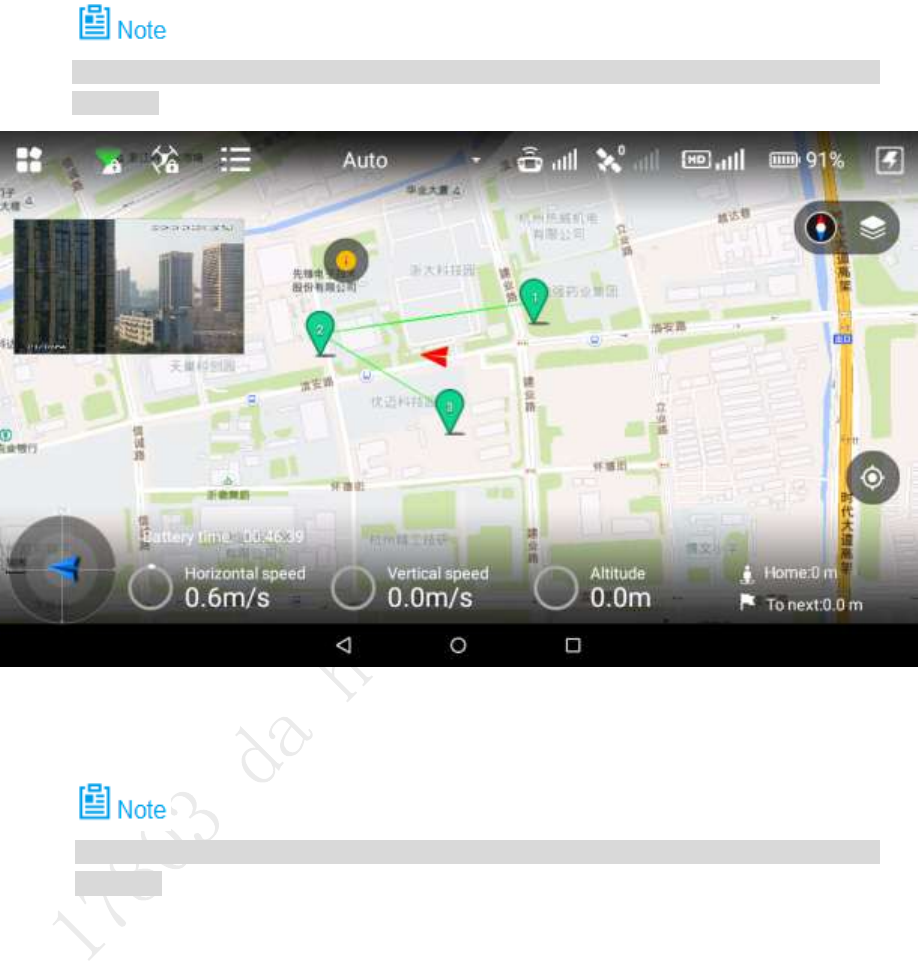
56
4.3.1.1 Waypoints
Select “Waypoints”. Step 1
The system displays “Waypoints” interface, as shown in Figure 4-12.
Check total route length, estimated flight time and set “Cycle Flight” at the bottom of the
interface.
Figure 4-12
Click the map and the position can be set as a waypoint; several waypoints can be Step 2
connected together and form a route.
Check total route length, estimated flight time and set “Cycle Flight” at the bottom of the
interface.
Click a waypoint and it will become red. Waypoint setting interface will display on the
Step 3
right of the interface, as shown in Figure 4-13.
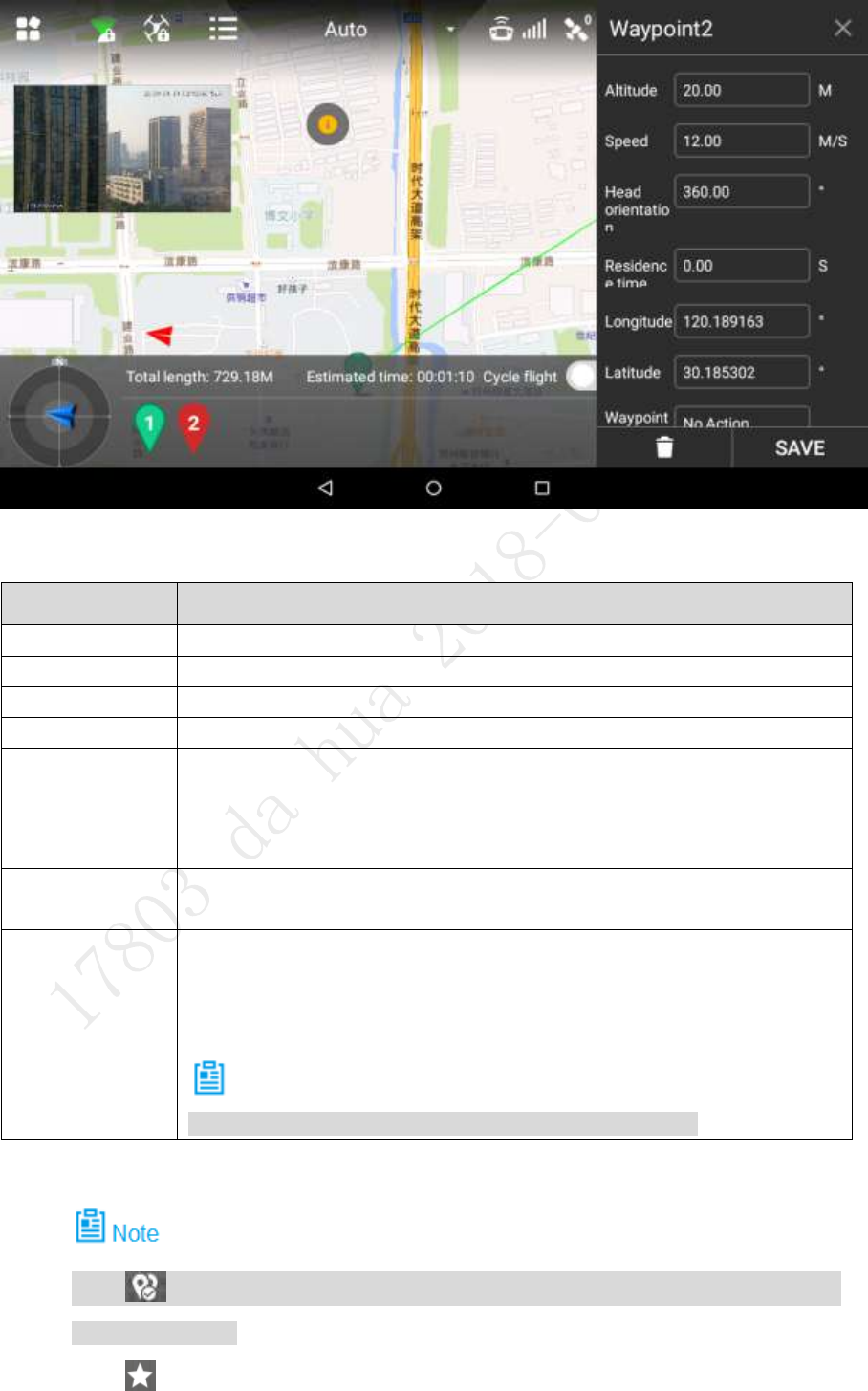
57
Figure 4-13
Set waypoint parameters. Please refer to Table 4-1 for more details. Step 4
Parameter
Note
Altitude
Set flight altitude of waypoint.
Speed
Set flight speed of waypoint
Head orientation
Set head orientation of waypoint according to requirement during flight.
Residence time
Set hovering time after the aircraft reaches a waypoint.
Latitude and
longitude
Automatically acquire latitude and longitude of the waypoint when
adding the waypoint.
Manually set waypoint latitude and longitude. Waypoint position will
skip to manual setting point after setting is done.
Waypoint action
No action: it is not to set waypoint action.
Shutter: it will take photos after the aircraft arrives at the waypoint.
Action cycle
Action cycle setting is invalid when the waypoint action selects “No
Action”.
When waypoint action selects “Shutter”, input time. The aircraft
arrives at the waypoint and it will take a photo after a period of time.
Note
Action cycle shall be less than or equal to residence time.
Table 4-1
Click “Save” to make configuration valid. Step 5
Click to set waypoint parameters in batches. Meanwhile, it can modify or delete
several waypoints.
Click to input mission name, click “Save” and you can check saved flight missions Step 6
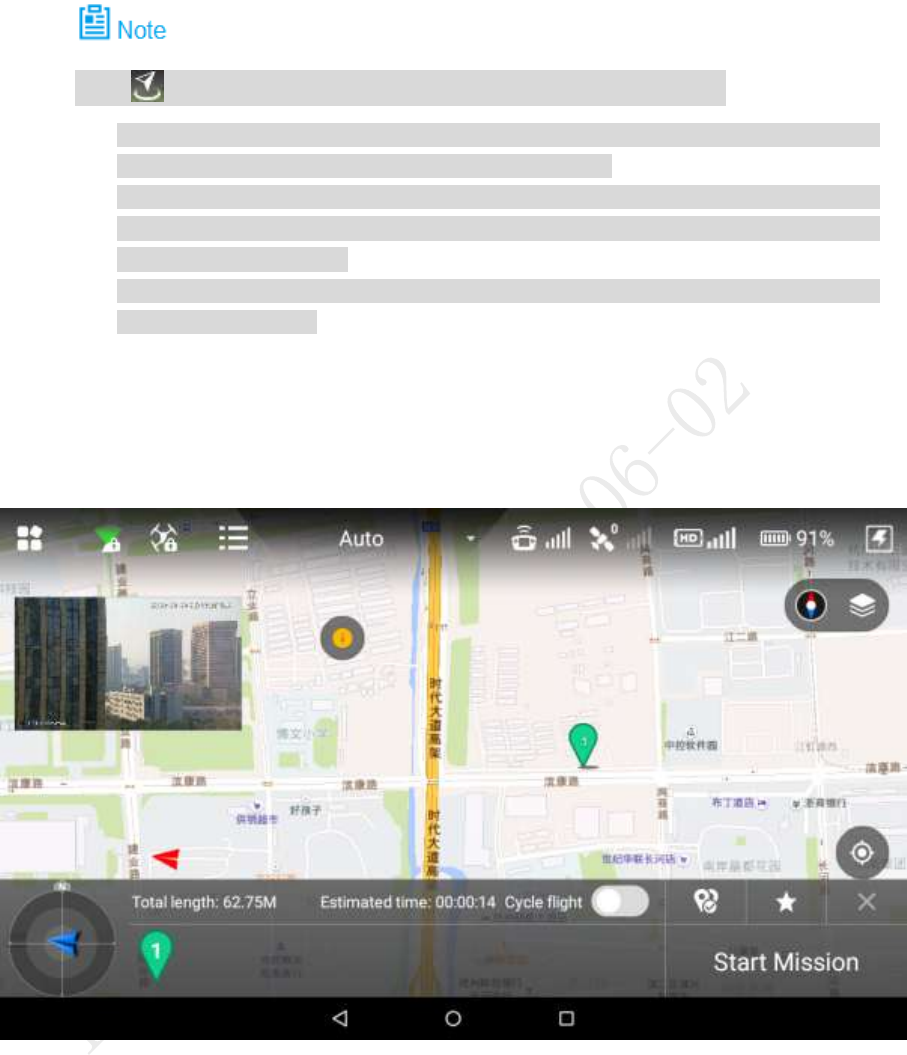
58
in the list.
Click to enter flight mission interface. There are three operations:
Add mission: Click the icon to enter waypoint setting interface, set waypoint flight
mission and save it according to actual requirements.
Download mission: Click the icon to automatically download the currently saved
flight route. You can modify the waypoint according to actual requirement and save
it into the remote control.
Select mission: Click the icon, select one or more missions on the interface, and
delete the mission(s).
4.3.1.2 Circle
Select “Circle”. Step 1
The system displays “Circle” interface, as shown in Figure 4-14.
Figure 4-14
Click the map and the position can be set as interest point. Step 2
Click the interest point, and the point icon will become red. Settings interface of interest Step 3
point will be displayed on the right of main interface, as shown in Figure 4-15.
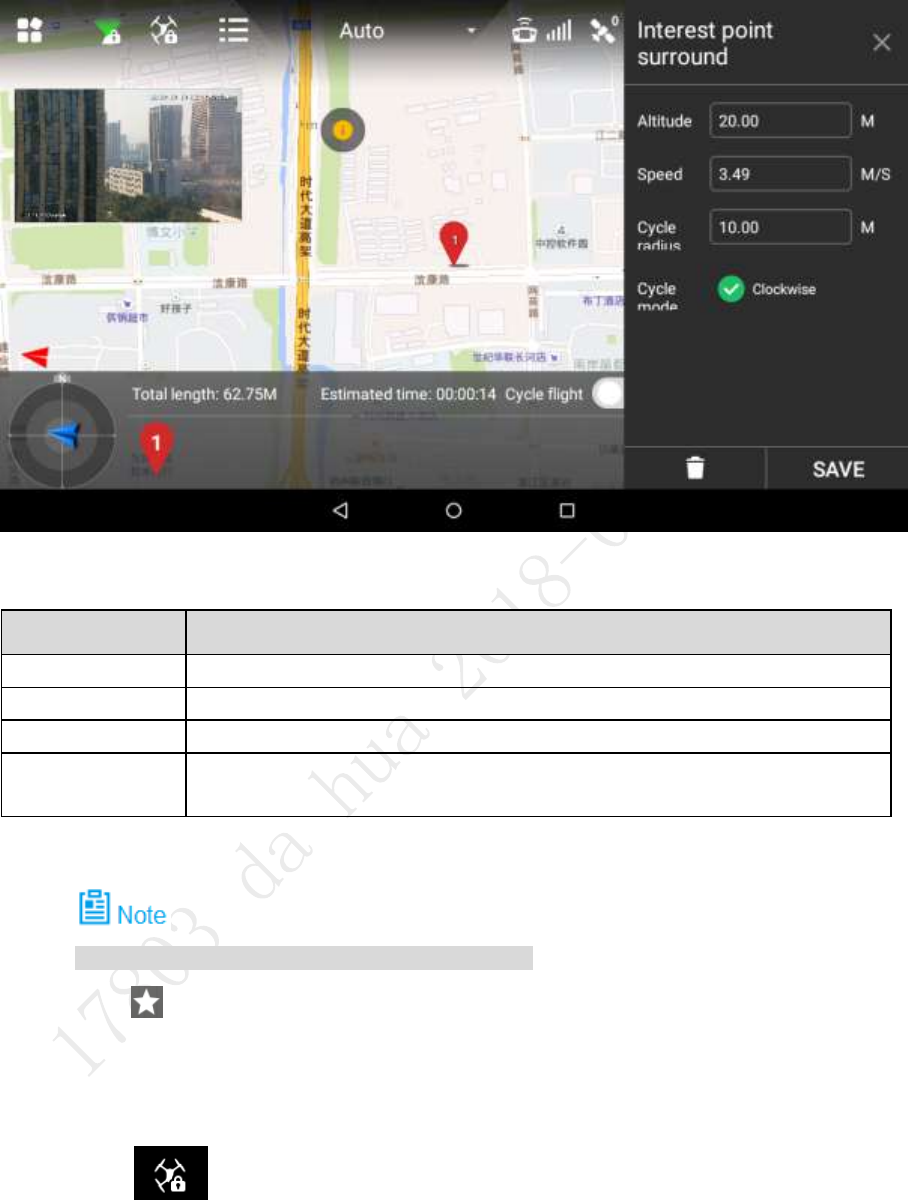
59
Figure 4-15
Set the parameters of interest point. Please refer to Table 4-2 for more details. Step 4
Parameter
Note
Altitude
Set flight altitude of interest point.
Speed
Set flight speed of interest point.
Cycle radius
Set flight radius of aircraft flying around interest point.
Cycle mode
Select the flight direction of aircraft flying around interest point, clockwise
optional.
Table 4-2
Click “Save” to make configuration valid. Step 5
Set one interest point only for each flight mission.
Click to input mission name, click “Save” to save flight mission. Step 6
4.3.2 Intelligent Locking Mode
Click and it will pop out a dialog box. Select locking mode of the aircraft. Step 1
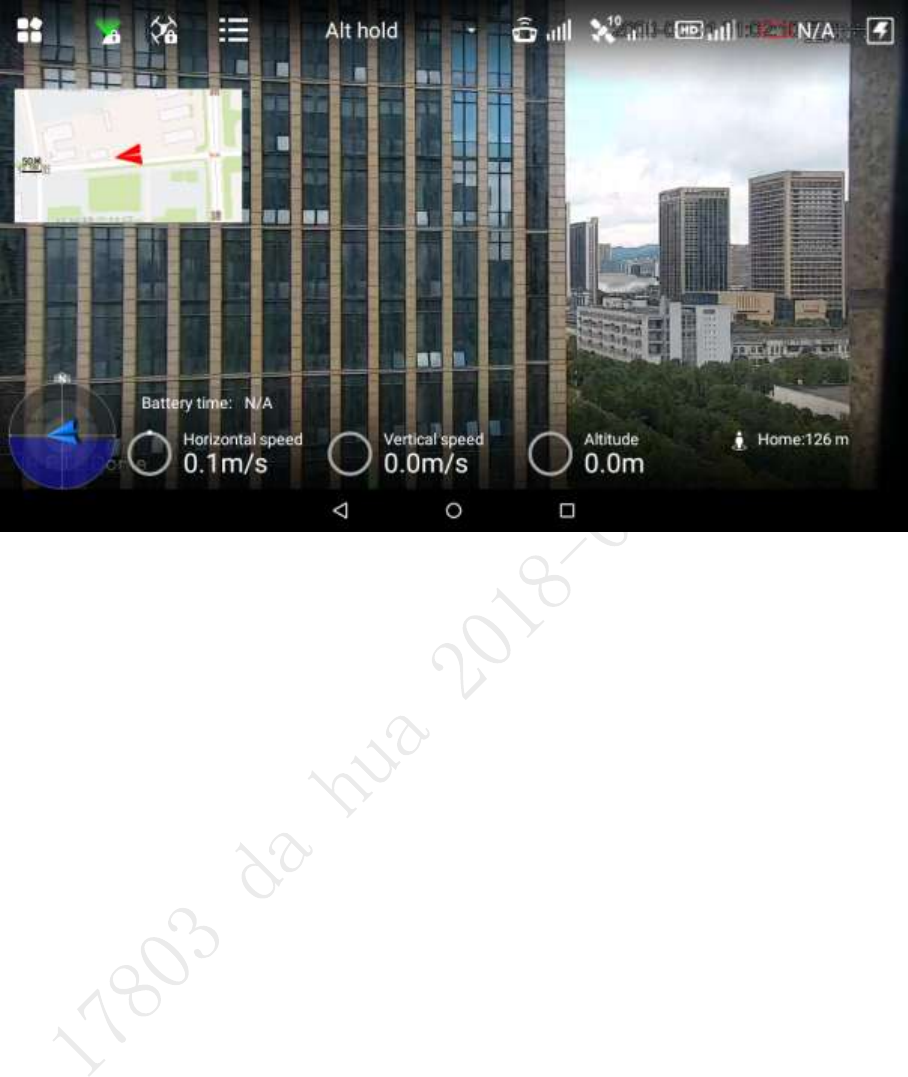
60
Figure 4-16
There are two types of intelligent locking modes, namely course lock and return lock.
Course lock: Click it to lock the present head direction as its forward direction.
During the following flight process, the aircraft course has nothing to do with the
head direction; the aircraft will always move forward according to the locked head
direction.
Return lock: Click it and the aircraft course has nothing to do with the head
direction. Always take the straight line direction far away from HOME point as
forward direction and the straight line direction close to HOME point as backward
direction.
If both modes are canceled: the aircraft head direction is forward direction.
Click “Return Lock” and the icon becomes yellow, and it will prompt “Return Lock Step 2
Enabled”.
Click “Course Lock” and the icon becomes yellow, and it will prompt “Course Lock
Enabled”.
4.3.3 Intelligent Operation
4.3.3.1 Auto Takeoff
In fixed point mode, first unlock flight control, and then short press the takeoff and landing
button on the front panel of the remote control. The aircraft will take off automatically and begin
flight according to the pre-set route.
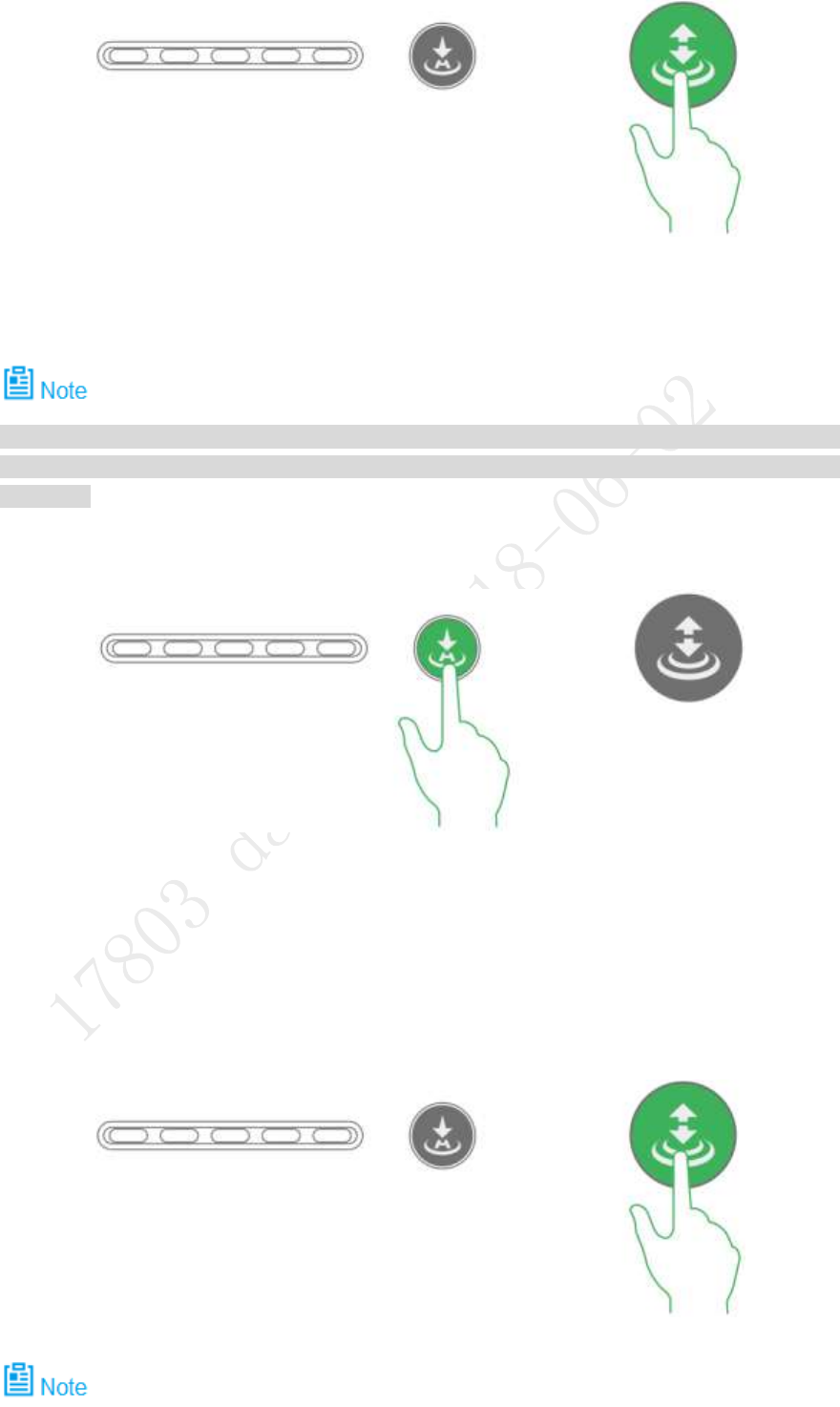
61
Figure 4-17
4.3.3.2 Auto RTH and Landing
The landing under the condition of low battery or in the uncontrollable situation has been
introduced in other chapters; this chapter will only introduce the landing modes in other
situations.
Short press RTH button on the front panel of the remote control, and the aircraft will return to
Home.
Figure 4-18
4.3.3.3 One-key Landing
Under the present condition, the aircraft needs to land vertically.
Short press the takeoff and landing button on the front panel of the remote control, and the
aircraft will land at the current position automatically.
Figure 4-19

62
One-key landing doesn’t return Home, but the aircraft will land at the current position
immediately.
4.4 Intelligent Protection Mechanism
4.4.1 Low Battery
There are totally three prompts of aircraft low battery for the remote control, and each prompt is
more serious than the previous one.
Level-one low battery, remote control prompts message: “Low Voltage Alarm”, along with
alarm sound.
Level-two low battery, remote control prompts message: “Serious low voltage home”, along
with alarm sound. First ascend to 120m, return to HOME point and then descend. At this
time, it is OK to suspend low voltage home (cancel button appears on App, or suspend it
by switching the mode of remote control continuously).
Level-three low battery, remote control prompts message: “Serious low voltage landing”,
along with alarm sound. Meanwhile, the aircraft triggers landing mode.
After suspending low voltage home, level-three low battery alarm will be triggered if it continues
to fly or fly in some harsh environment.
4.4.2 Out of Control
The aircraft may run into the following out of control situations:
The aircraft or remote control antenna is damaged, and it fails to receive and send
signals.
Intensive magnetic field arises in ambient environment, which interferes with the
aircraft and remote control.
Solutions:
Out of control auto return: ascend the aircraft to 120m first and then return to HOME point.
4.5 Remote Control Setting
4.5.1 Remote Button User-defined
Set the function of A1 button on the remote control, including “One button to return to center”
and “One button 90°”.
Select “Settings > Flight Control Settings > Remote Control Settings > Remote Button
User-defined”. The system displays “Remote Button User-defined” interface, as shown in
Figure 4-20.
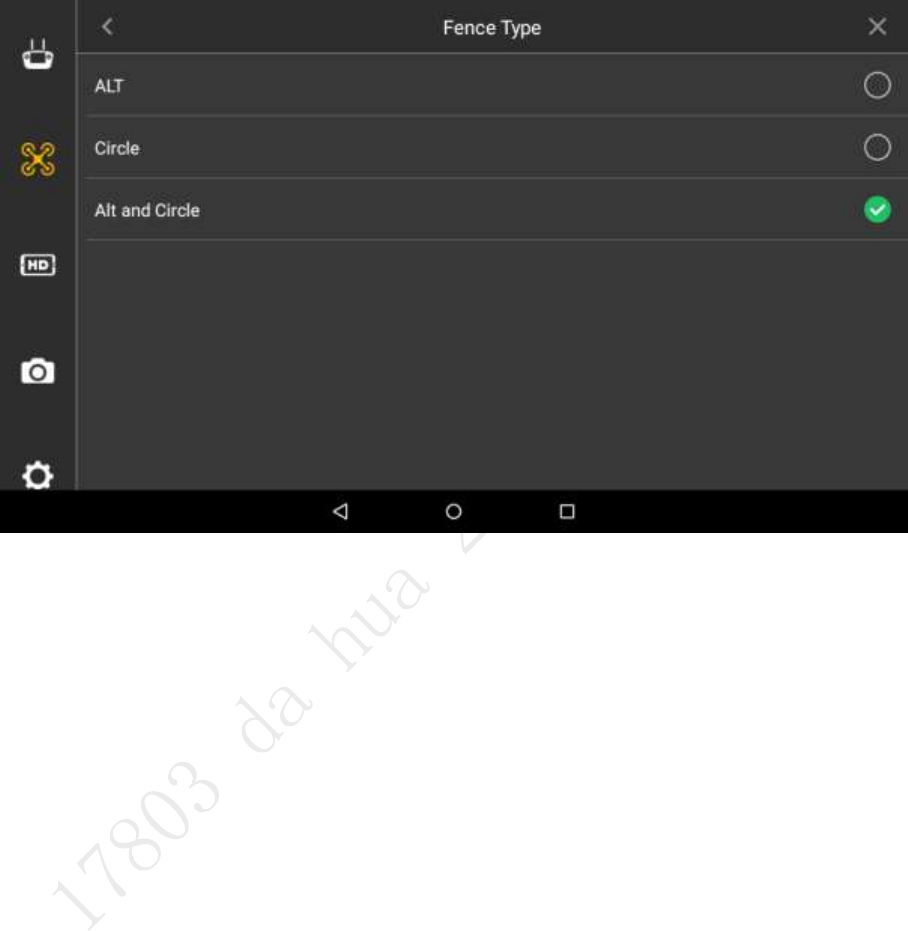
64
5.5.2.1.1 Fence Type
Draw electronic fence area.
Select “Settings > Flight Control Settings > Fence Settings > Fence Type”, as shown in Figure
4-22.
Figure 4-22
ALT (Limited altitude): limit the max. flight altitude of the aircraft, but there is no limit in
horizontal direction of the aircraft.
Circle: Take HOME point as circle center and the set value as radius. The aircraft is
restricted to fly within the circle, and there is no limit to the altitude.
ALT and Circle: Take HOME point as circle center and set value as radius. The set height
is considered as max. flight altitude; the aircraft is restricted to fly within the cylindrical
area.
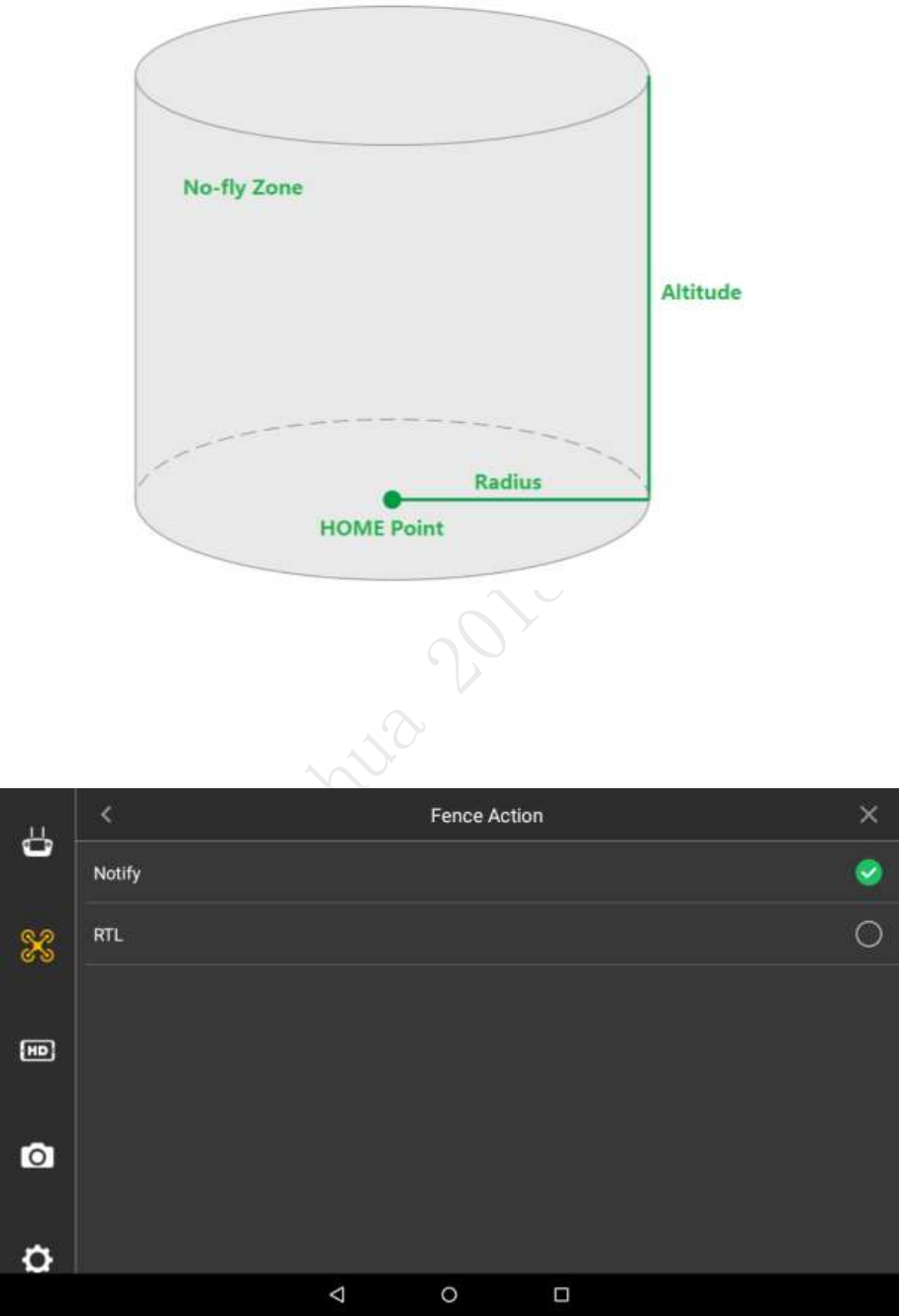
65
Figure 4-23
4.5.2.1.2 Fence Action
Select “Settings > Flight Control Settings > Fence Settings > Fence Action”, as shown in Figure
4-24.
Figure 4-24
Notify: The aircraft hovers in the air when electronic fence is triggered. Preview interface of
remote control gives a prompt, along with buzzing.
RTL: When electronic fence is triggered, preview interface of remote control gives a
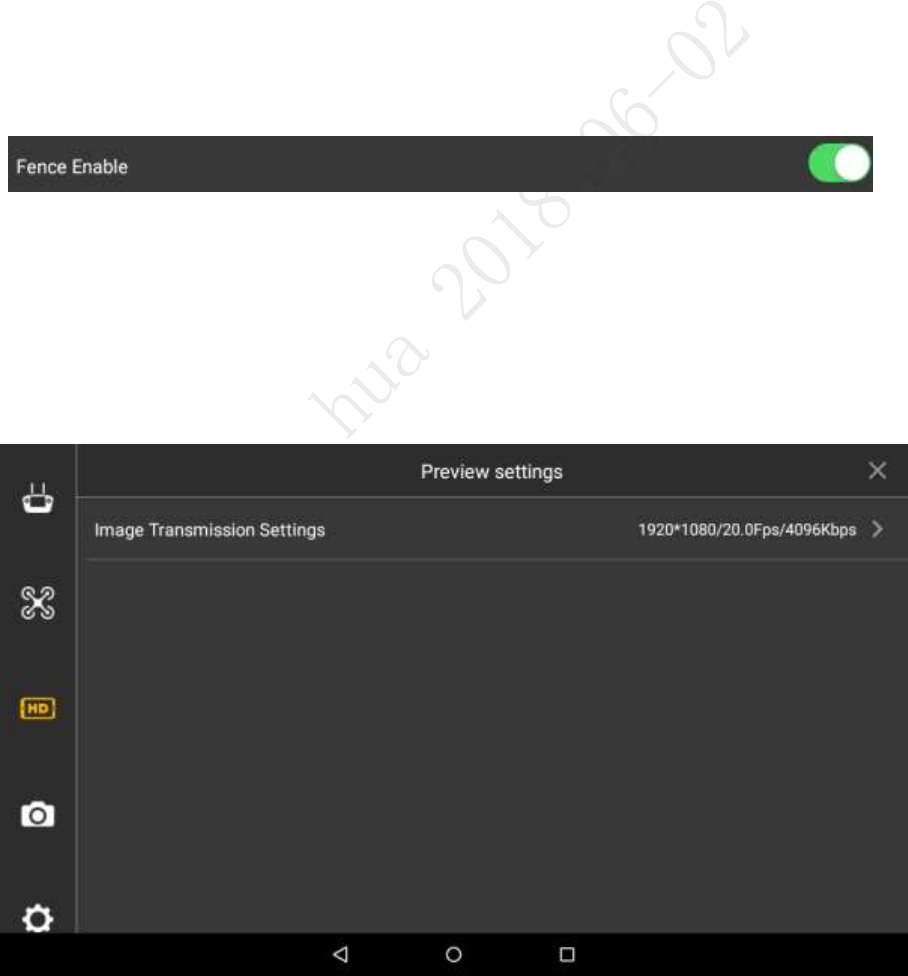
66
prompt, along with buzzing. Meanwhile, the aircraft returns automatically.
4.5.2.1.3 Other Settings
Select “Settings > Flight Control Settings > Fence Settings”.
Set radius and altitude.
Set trigger distance.
For example, when the fence type is set as radius + altitude, the radius is set as A meters and
altitude is set as B meters, and if the trigger distance is set as C meters, then it will trigger RTH
or landing when the aircraft is (A-C) meters away from the HOME point horizontally or flight
altitude exceeds (B-C) meters; the aircraft will implement the action of RTH or landing.
4.5.2.2 Enable Electronic Fence
Enable electronic fence after setting fence area.
Select “Settings > Flight Control Settings”, enable electronic fence on the right of the “Fence
Enable”.
Figure 4-25
4.5.3 Preview Settings
Set resolution, frame rate and max. bandwidth of preview image according to requirements.
Select “Settings > Flight Control Settings > Preview Settings” and enter the preview Step 1
setting interface, as shown in Figure 4-26.
Figure 4-26
Select “Settings > Flight Control Settings > Preview Settings > Image Transmission Step 2
Settings”.
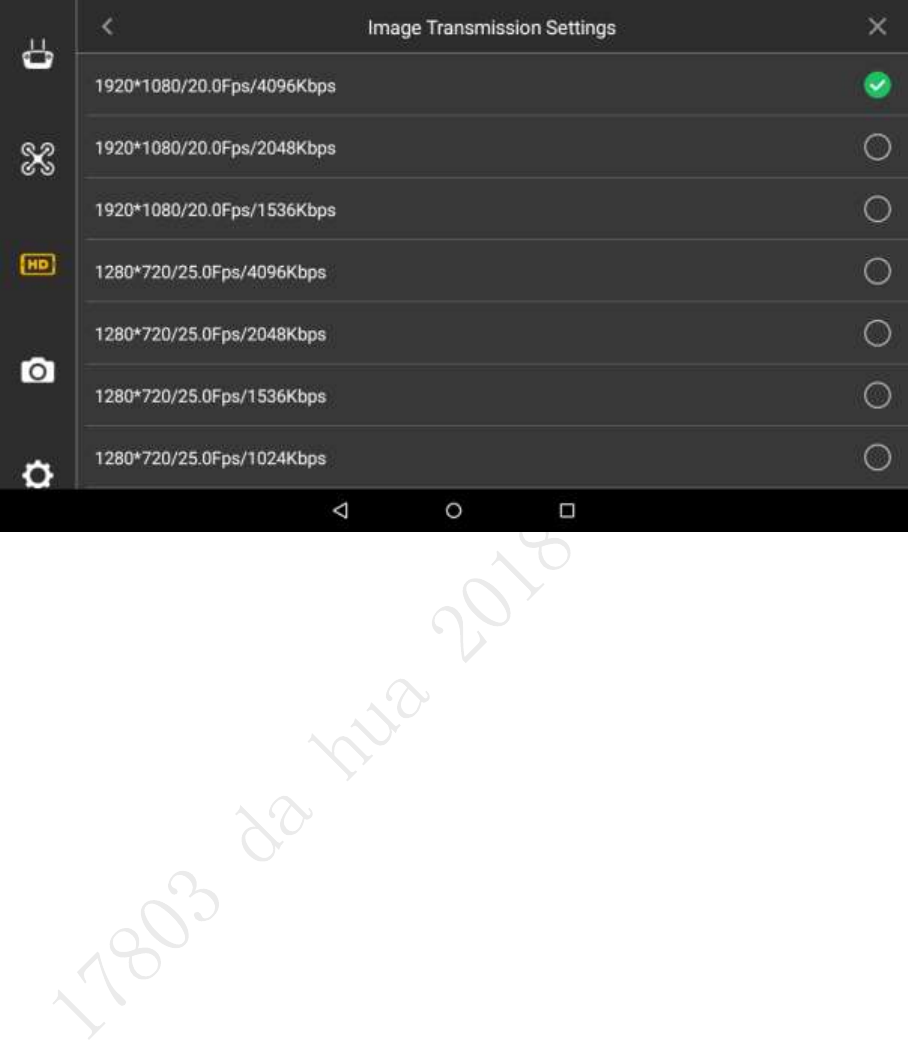
67
The system displays “Image Transmission Settings” interface, as shown in Figure 4-27.
Figure 4-27
Select one option. Step 3
Icon at the end of selected line becomes green and checked, which makes it valid
immediately.
4.5.4 Camera Settings
4.5.4.1 Photo Settings
Set resolution, frame rate and max. bandwidth of photos taken by PTZ camera according to
requirements.
Select “Settings > Camera Settings > Photo Settings”. Step 1
The system displays “Photo Settings” interface, as shown in Figure 4-28.
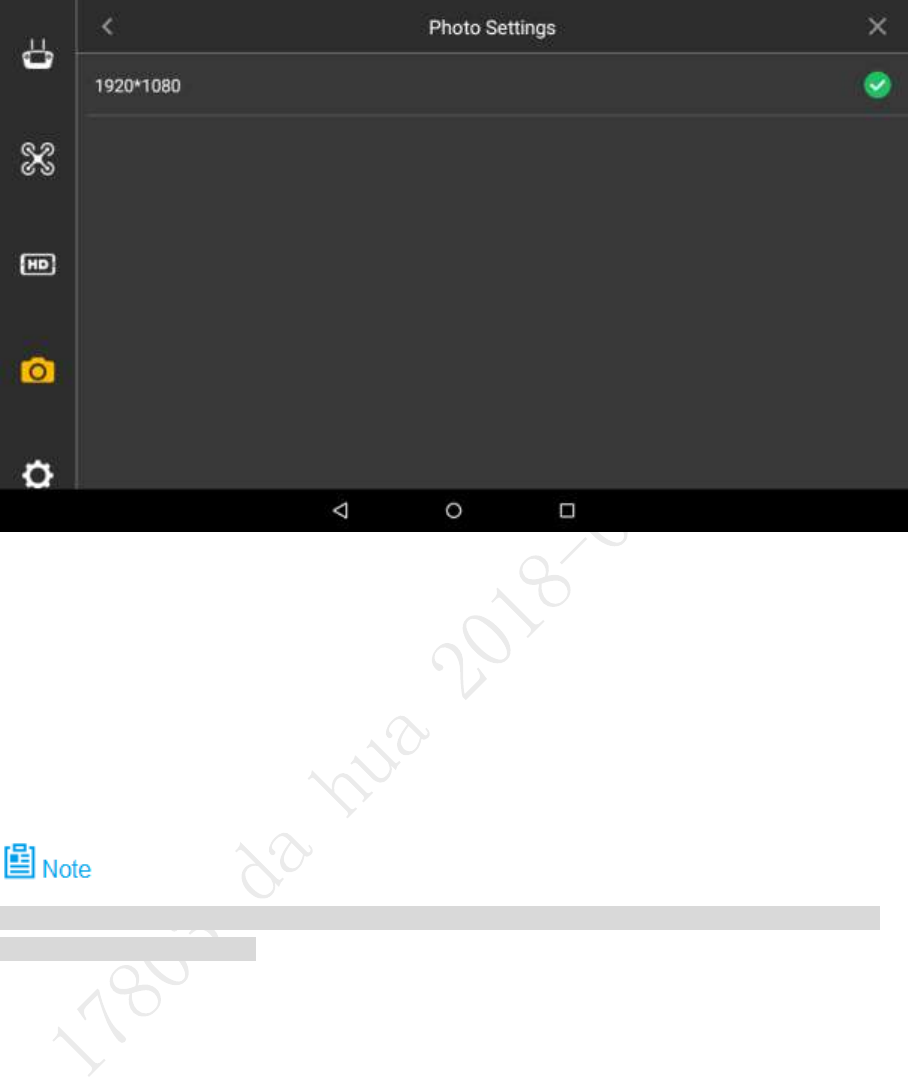
68
Figure 4-28
Select one line. Step 2
Icon at the end of selected line becomes green and checked, which makes it valid
immediately.
4.5.4.2 Video Settings
Select to enable “Camera Auto-take Video When Unlock” or not; select the resolution, frame
rate, stream and coding format of PTZ camera.
Please ensure that the aircraft is unlocked during video setting. Video setting can be realized
only under unlocked status.
Select “Settings > Camera Settings > Video Settings”. Step 1
The system displays “Video Settings” interface, as shown in Figure 4-29.
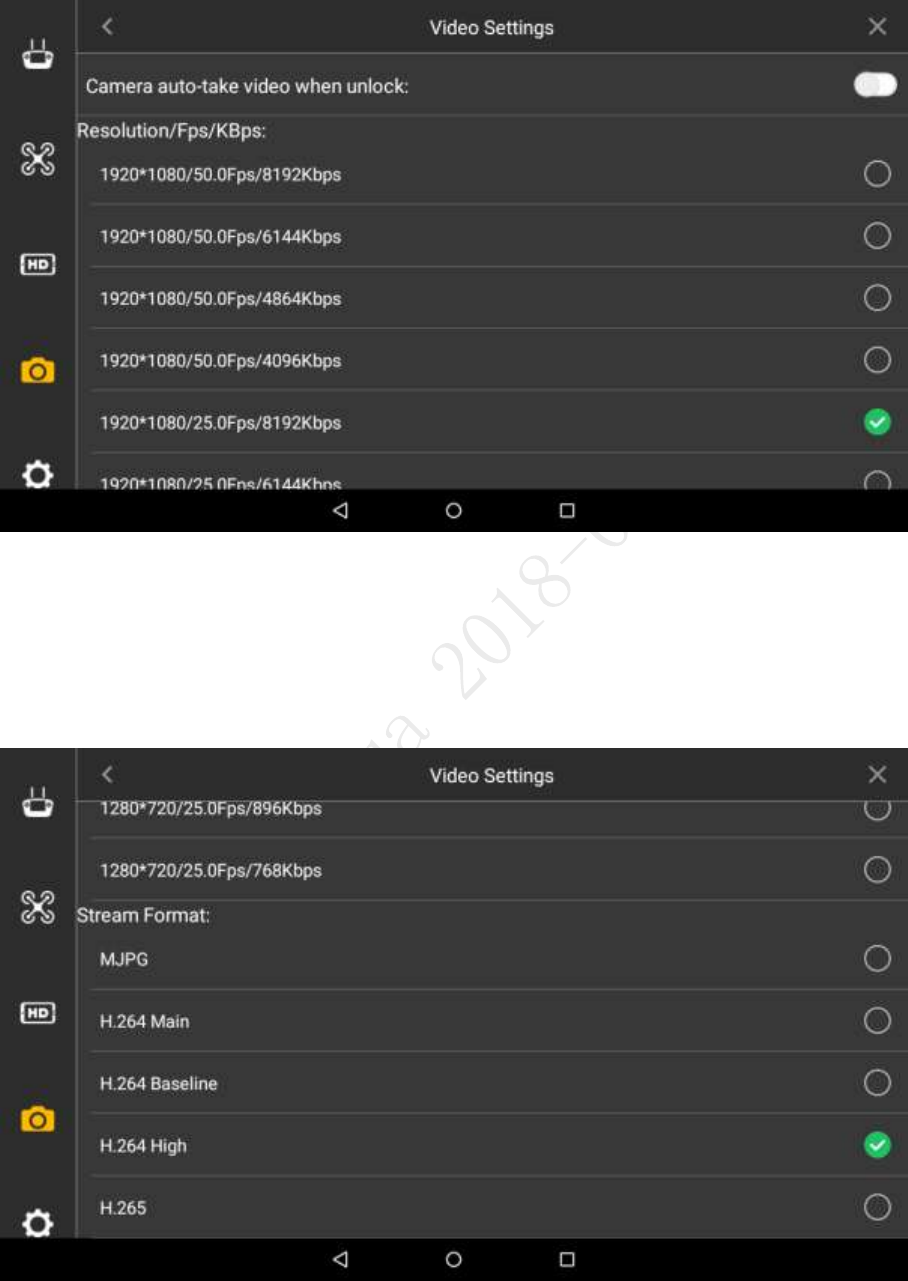
69
Figure 4-29
Select the switch behind “Camera Auto-take Video When Unlock”. When the switch Step 2
turns green and ticked, it means that the function is enabled.
Select “Resolution/FPS/KBps”, click a line, and icon at the end of selected parameter Step 3
line becomes green and checked, which makes it valid immediately.
Select “Stream Format”, as shown in Figure 4-30. Step 4
Figure 4-30
Click a line, and icon at the end of selected parameter line becomes green and Step 5
checked, which makes it valid immediately.
MJPG: In this mode, video image needs relatively high stream value to guarantee
definition. To obtain a good effect, it is suggested to use maximum stream value
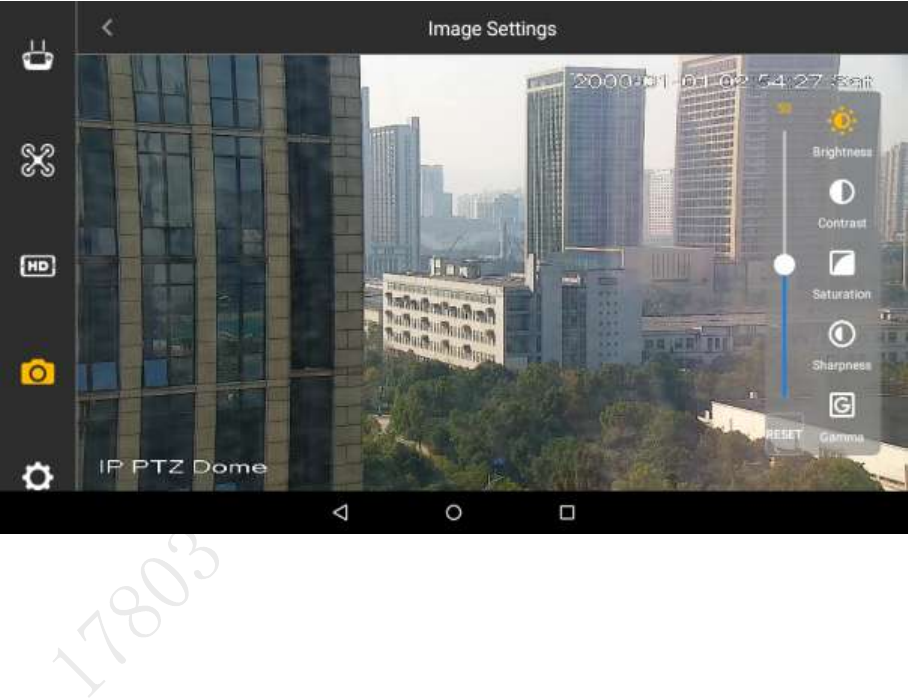
70
among reference stream value.
H.264 Main: Main Profile mode.
H.264 Baseline: Baseline Profile mode.
H.264 High: High Profile mode.
H.265: Main Profile mode.
4.5.4.3 Image Settings
Set the brightness, contrast, saturation, sharpness and gamma value of the preview image of
PTZ camera.
Select “Settings > Camera Settings > Advanced Settings > Image Settings”. Step 1
The system displays “Image Settings” interface, as shown in Figure 4-31.
Figure 4-31
Set the parameter items on the right of the interface. Step 2
Brightness: Adjust the overall brightness of the image; adjust the value when the
overall brightness of image is too bright or too dark.
Contrast: Adjust the image contrast. Adjust the value when overall brightness is
proper but the image contrast is not enough.
Saturation: Adjust the bright degree of the color, which will not affect the overall
brightness of the image.
Sharpness: Adjust the image resolution and sharpness degree of image edge.
Gamma: Optimize brightness and contrast, and adjust slight brightness and
darkness layer of the image.
Set parameter value by sliding, and it is valid immediately. Step 3
4.5.5 General Settings
Realize firmware update and other settings, including brightness, date and time, network
setting, language and Micro SD card setting.
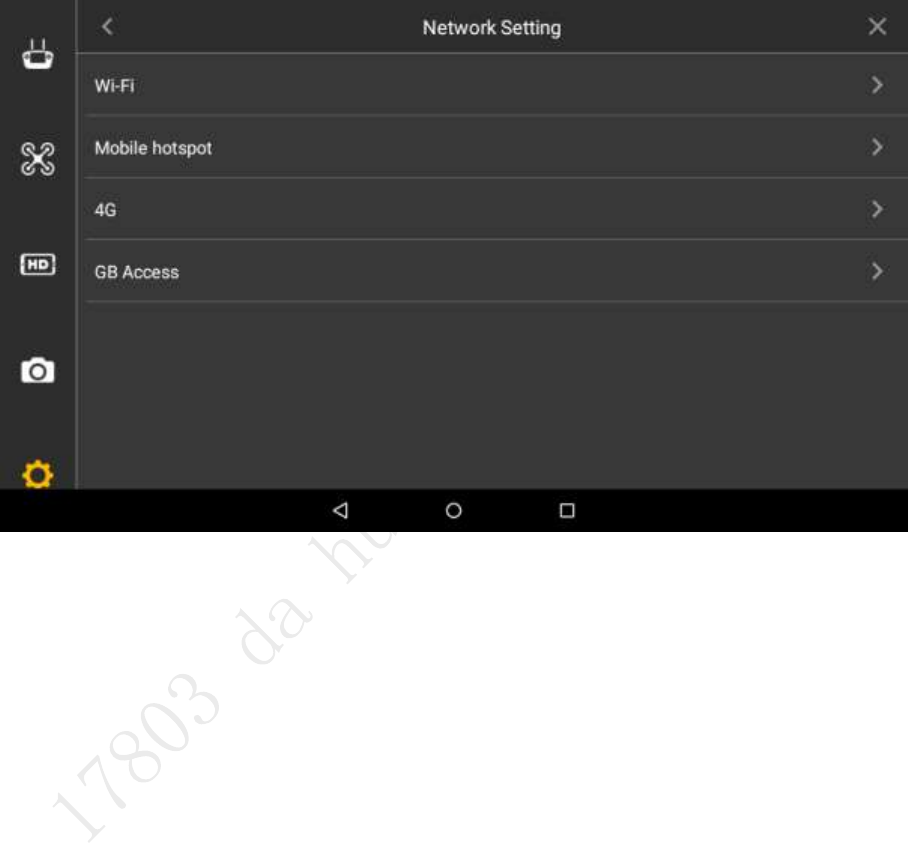
71
4.5.5.1 Other Settings
4.5.5.1.1 Network Settings
Network access of remote control includes Wi-Fi, mobile hotspot.
Select “Settings > General Settings > Other Settings > Network Settings”. Step 1
The system displays “Network Settings” interface, as shown in Figure 4-32.
Figure 4-32
Select “Network Setting”. Step 2
Wi-Fi: Enable “WLAN”, connect the remote control with wireless network, and thus
transmit data through wireless network.
Mobile hotspot: Enable “Mobile WLAN Hotspot”, so the user’s mobile phone or
other devices are connected with the network through mobile hotspot.
4.5.5.1.2 Micro SD Settings
View total space of Micro SD card and the space occupied by every part.
Select “Settings > General Settings > Other Settings > Micro SD Card Settings > Storage
Settings”. The system displays “Storage Settings” interface, as shown in Figure 4-33.
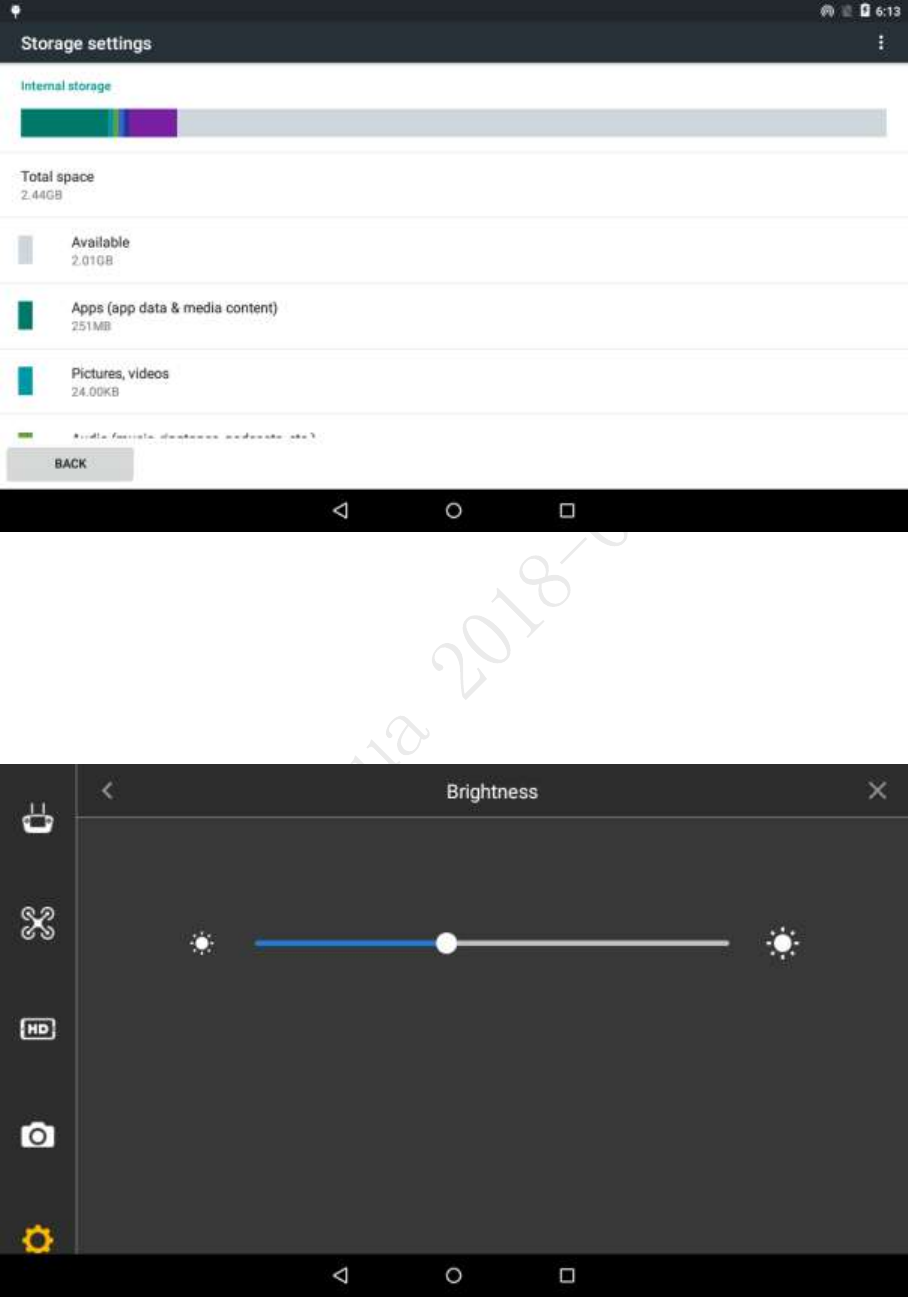
72
Figure 4-33
4.5.5.1.3 Brightness
Set the overall display brightness of the remote control touch screen.
Select “Settings > General Settings > Other Settings > Brightness”.
Step 1
The system displays “Brightness” interface, as shown in Figure 4-34.
Figure 4-34
Drag the adjustment bar to set overall brightness of remote control.
Step 2
It becomes darker when the adjustment bar moves left, and becomes brighter when it
moves right.
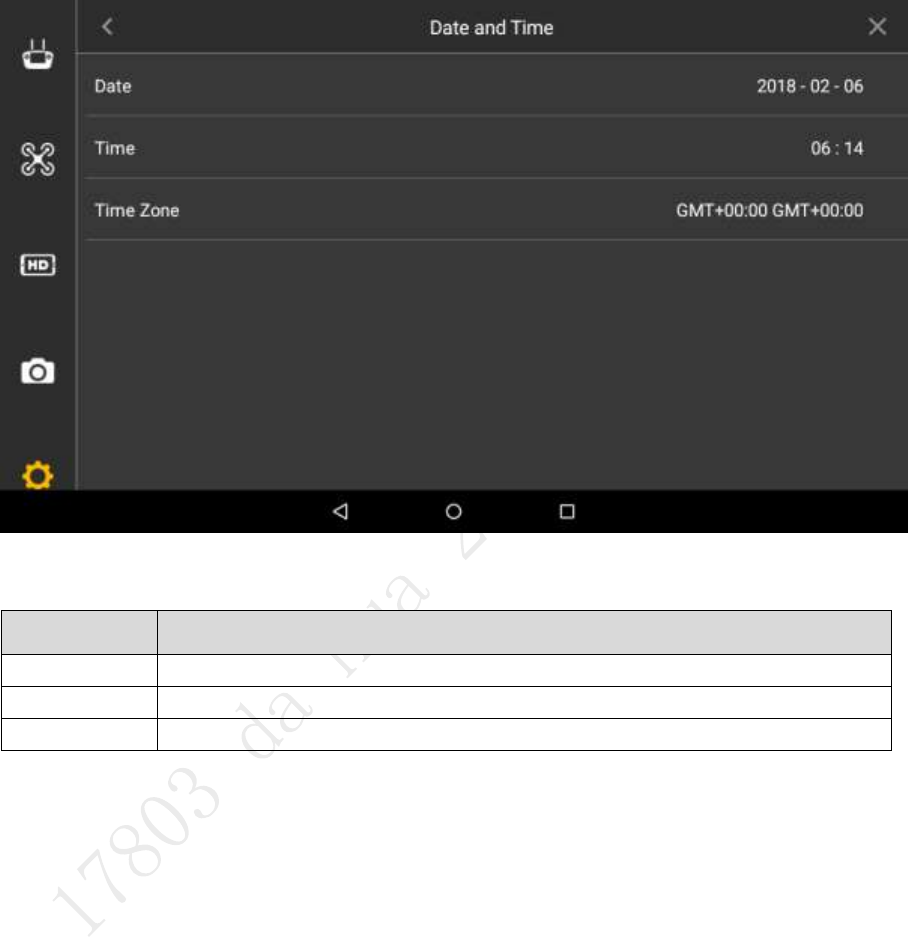
73
4.5.5.1.4 Date and time
Set the date, time and time zone displayed on the remote control.
Select “Settings > General Settings > Other Settings > Date and Time”. Step 1
The system displays “Date and Time” interface, as shown in Figure 4-35.
Figure 4-35
Set parameters according to actual needs. Please refer to Table 4-3 for more details. Step 2
Parameter
Note
Date
Click it to set date of remote control.
Time
Click it to set time of remote control.
Time Zone
Click it to set present time zone of remote control.
Table 4-3
4.5.5.1.5 Language
Set the language displayed on the remote control.
Select “Settings > General Settings > Other Settings > Language”. Step 1
The system displays “Language” interface, as shown in Figure 4-36.

75
5 End Flight
This chapter elaborates the operation steps after aircraft landing.
Please operate according to the following flows to make sure normal application for the next
time. Some of the operations are not indispensable. Please select according to the actual
situation.
End Flight
Turn off power
↓
Take out batter
↓
Dismantle airborne device
↓
Fold aircraft
↓
Dismantle image transmission
antenna
↓
Take out other components
Figure 5-1
5.1 Turn off Power
It has to turn off the aircraft power first, and then turn off the power of remote control.
Short press the power switch of aircraft battery. It means that the aircraft power has Step 1
been turned off when the built-in indicator light of the switch is off.
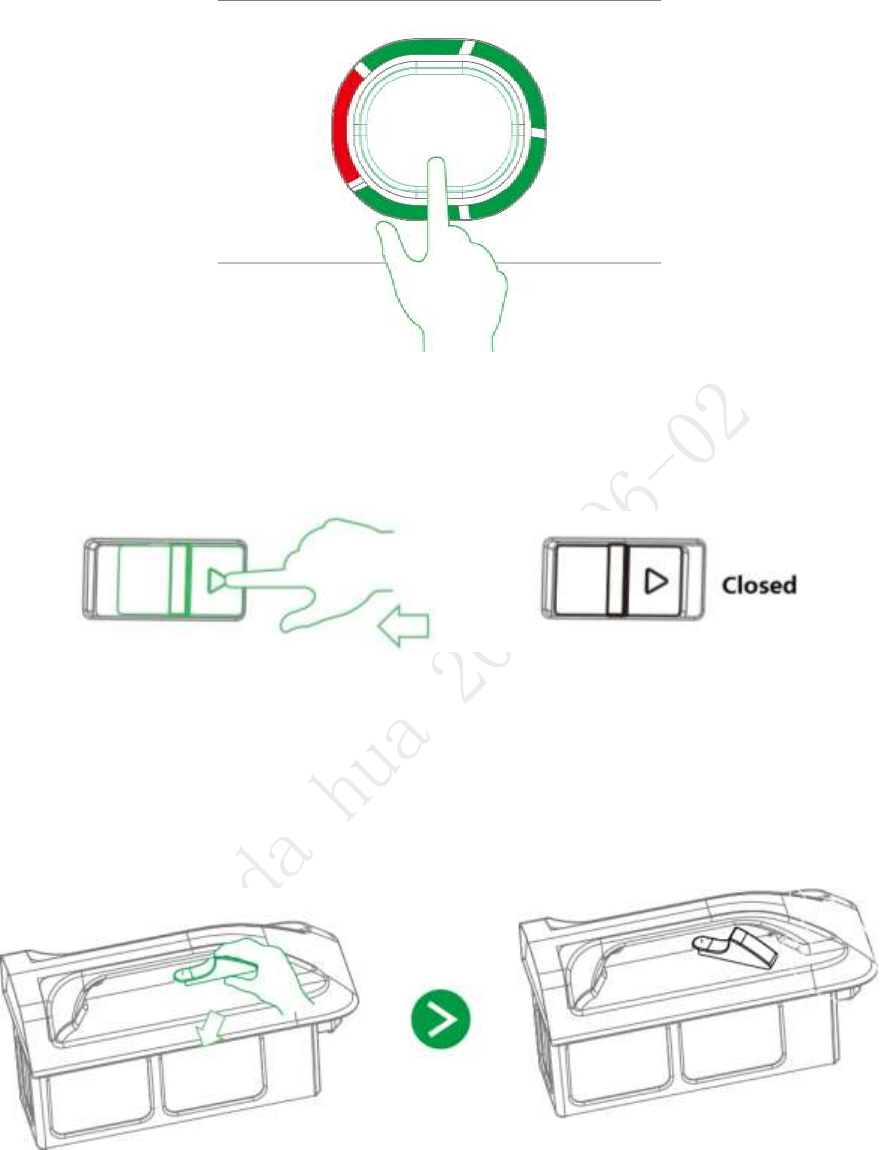
76
Figure 5-2
Move the power switch on the rear panel of the remote control to the other side. It Step 2
means that remote control power has been turned off when the indicator light of remote
control front panel is off.
Figure 5-3
5.2 Remove Aircraft Battery
Open the battery buckle of the aircraft, as shown in Figure 5-4. Step 1
Figure 5-4
Lift the battery from the compartment, as shown in Figure 5-5. Step 2
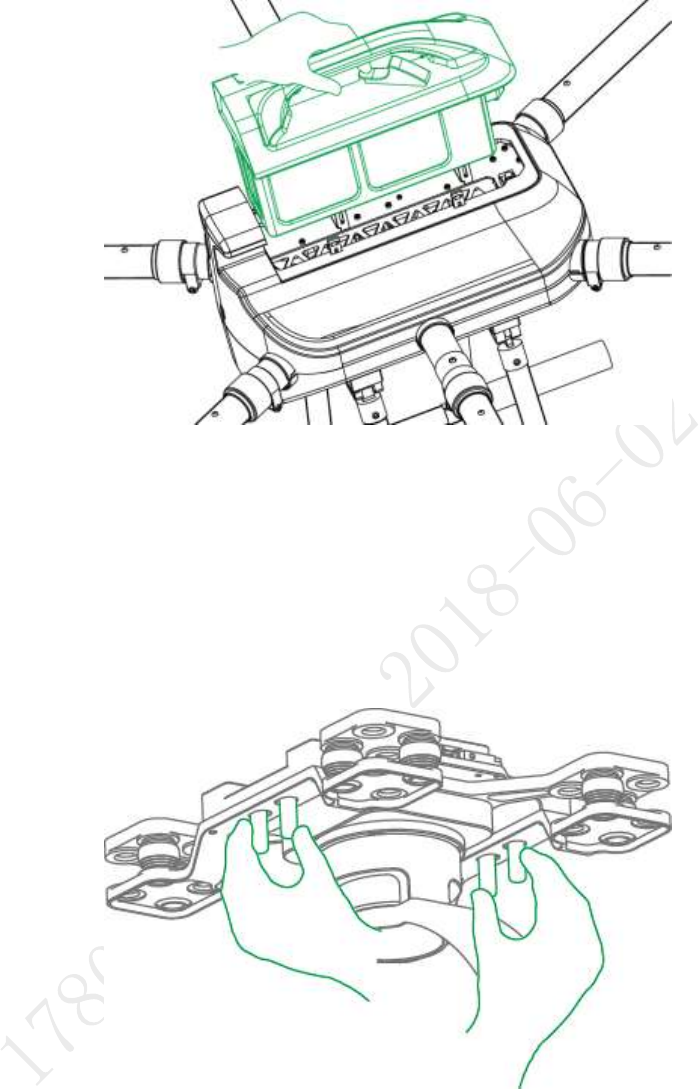
77
Figure 5-5
5.3 Dismantle Airborne Device
Hold 2 handles of the PTZ camera with both hands and pull them downwards, as Step 1
shown in Figure 5-6.
Figure 5-6
PTZ camera is separated from the aircraft, so it is dismantled quickly. Step 2
5.4 Fold Aircraft
Press the spring fastener on both sides of the propeller center, and remove the Step 1
propeller, as shown in Figure 5-7.
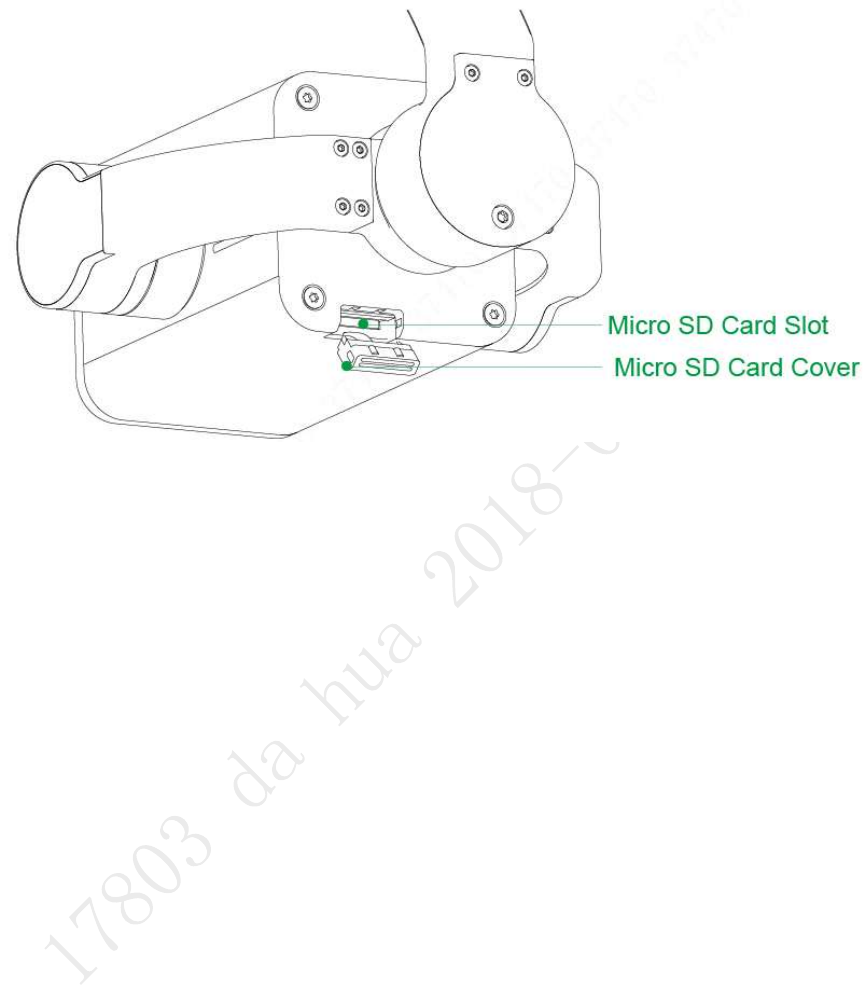
79
5.5 Copy Video of Camera Micro SD Card
Figure 5-10
Open micro SD card plug with hands. Step 1
Slightly press micro SD card and it will pop out. Pull out the micro SD card. Step 2
Insert the micro SD card into the card reader, and connect the card reader to computer. Step 3
Copy the micro SD card video into the computer via card reader and save it.
5.6 Remove Other Components
Remove SIM card: open silicone cover of side panel, pull out SIM card and close the
silicone cover.
Fold remote control antenna: Fold the antenna and make it close to the front panel of
remote control.
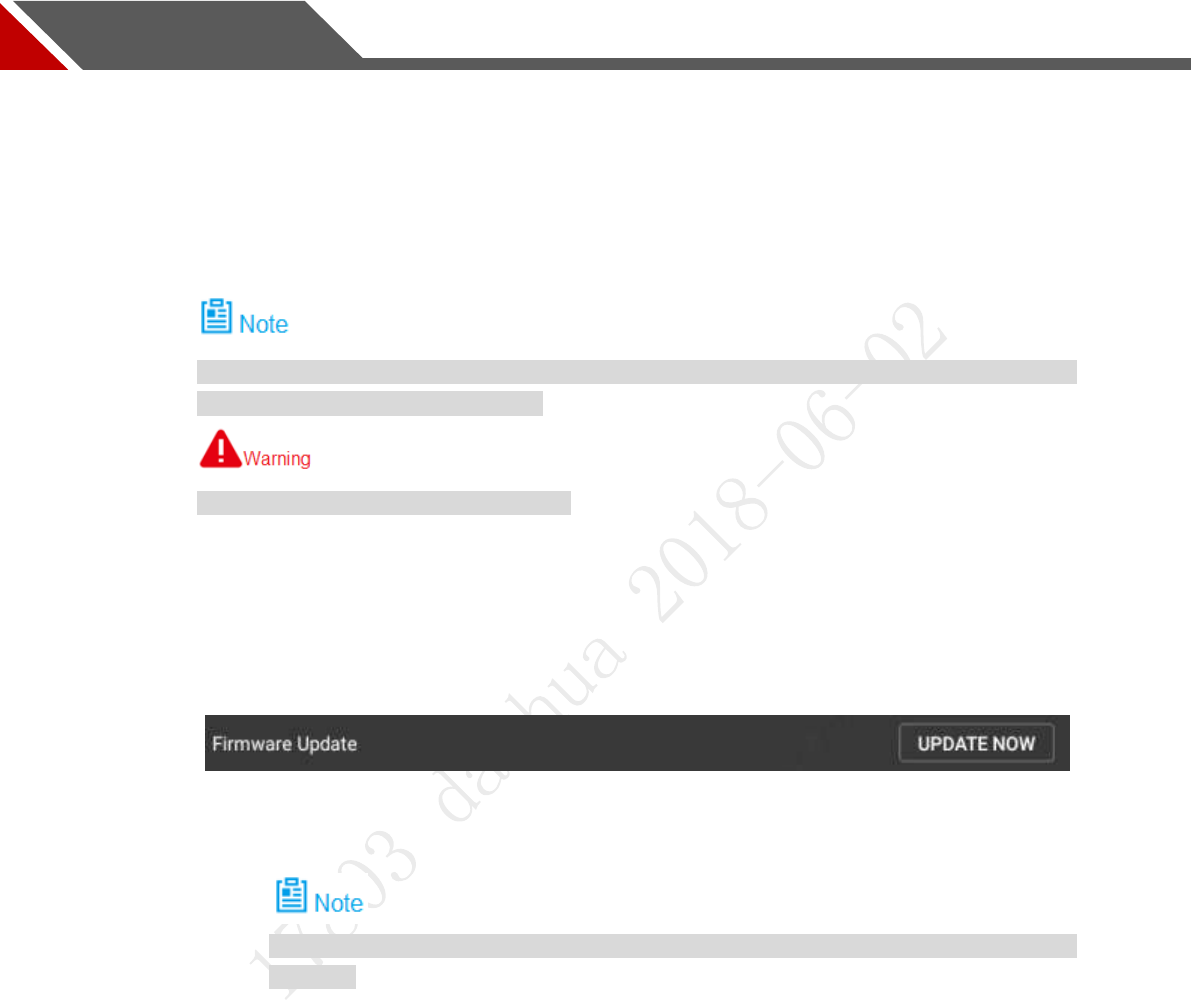
80
6 Upgrade and Update
This chapter elaborates upgrade methods of the device.
6.1 Firmware Update
The aircraft and remote control have to be enabled and connected during firmware update,
which is to make frequency matched.
Don’t upgrade the firmware during flight!
Update flight control, transmitting and receiving firmware of the aircraft, as well as transmitting
and receiving firmware of the remote control.
Insert the micro SD card with firmware update package into the micro SD card slot of Step 1
the remote control.
Select “Remote Control > Settings > General Settings”. Step 2
The system displays “Firmware Update” interface, as shown in Figure 6-1.
Figure 6-1
Select “Update Now”. Step 3
The system starts to update the firmware.
If micro SD card isn’t inserted, it will display the latest version on the right of each
firmware.
6.2 Remote Control Update
6.2.1 APP Update
Insert the micro SD card with APP update package into the micro SD card slot of the Step 1
remote control.
Select “Settings > General Settings”. Step 2
It will display the current APP version number or update software on the right of “APP
Update”, as shown in Figure 6-2.
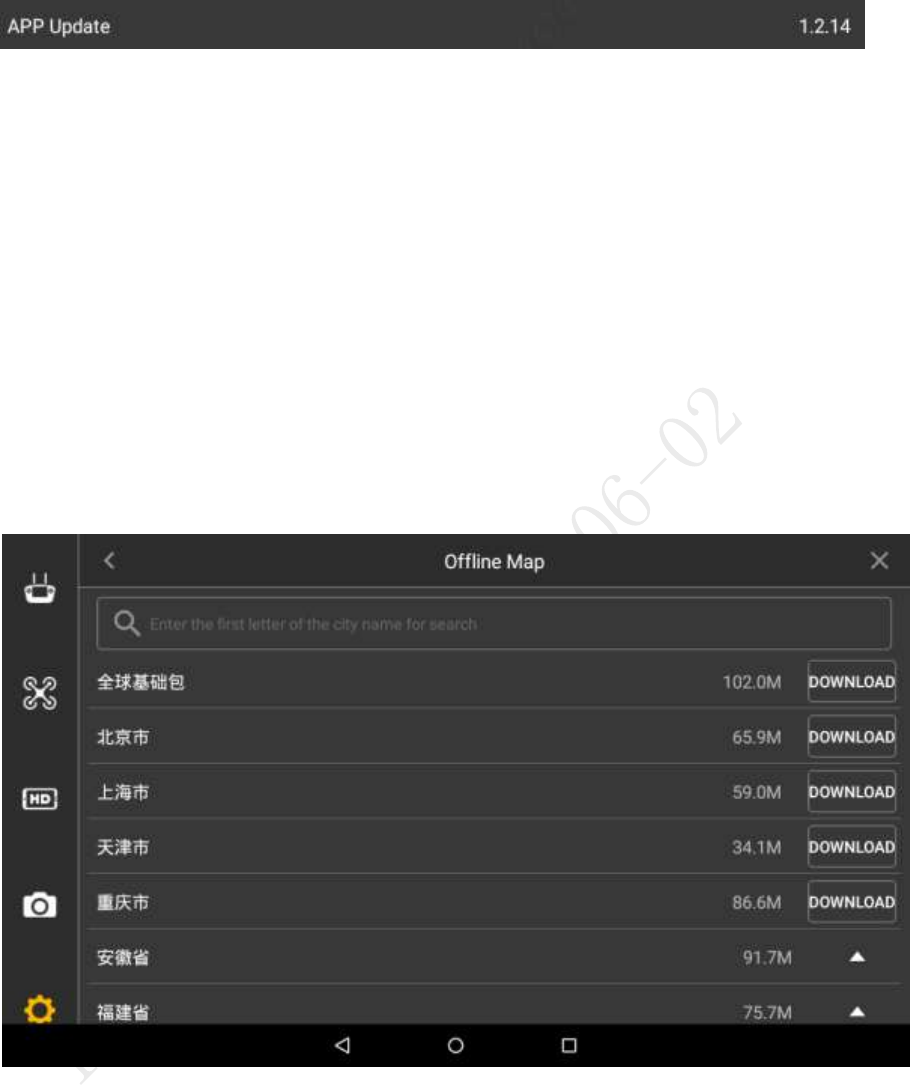
81
Figure 6-2
It doesn't need to update when it displays the version number, and it means that
the current APP is the latest version.
Update is available when it displays “Update Now”.
Select “Update Now”. Step 3
Update automatically and display update progress.
After successful update, version number in the above figure will be the same as update
software.
6.2.2 Download and Update Offline Map of Remote Control
Connect Wi-Fi, so the remote control accesses the network. Step 1
Select “Settings > General Settings > Other Settings > Offline Map”. Step 2
The system displays the interface of “Offline Map”, as shown in Figure 6-3.
Figure 6-3
Select the city which needs to be updated, and then click “Download” button in the Step 3
right.
The map takes effect immediately, without need for other operations. Step 4
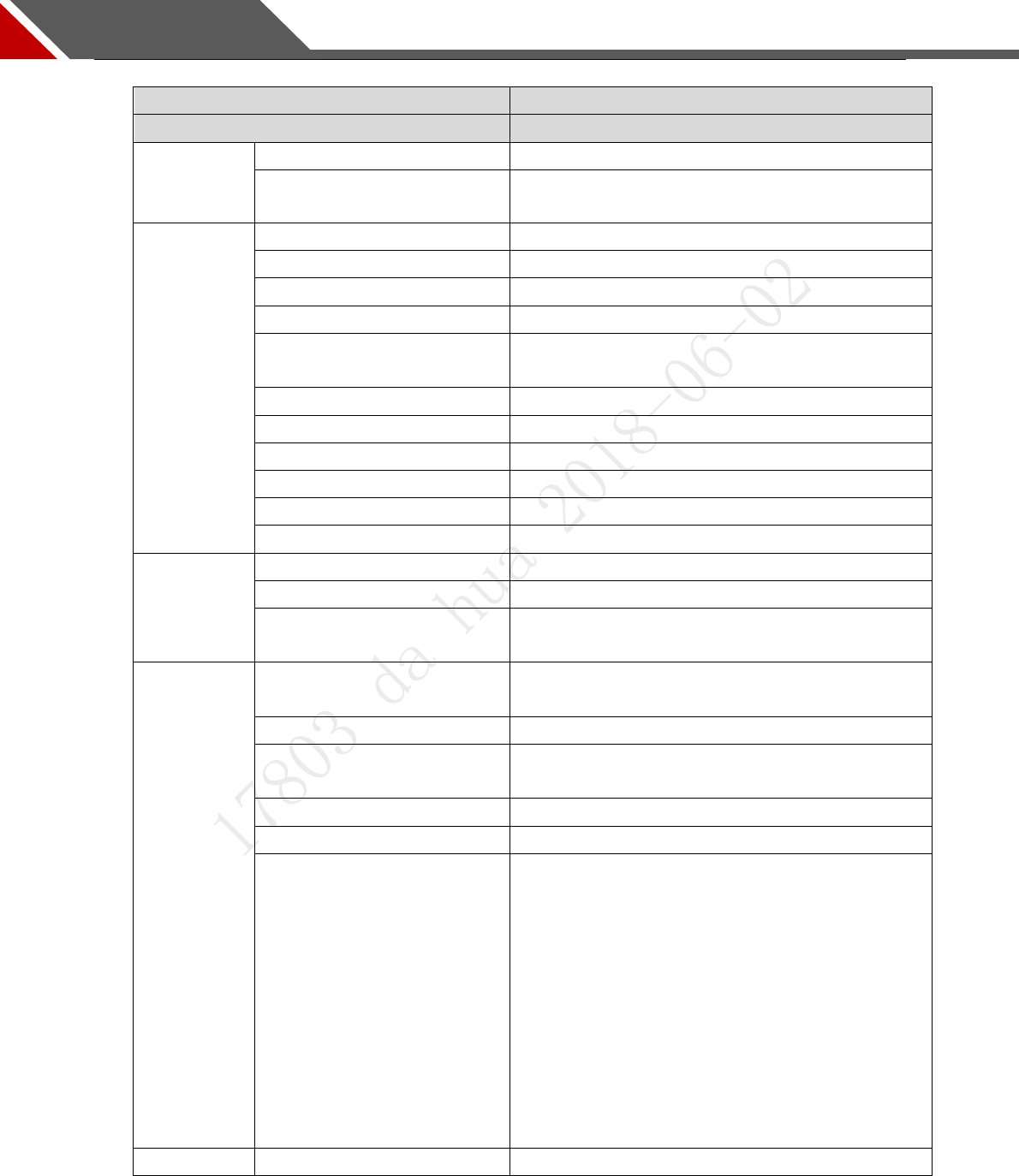
82
Main Technical Parameters Appendix 1
Parameter Item
Parameter Value
Model
Navigator X1100
System
Environment
Adaptability
Operating temperature
-20℃~60°C
Operating humidity
Operating humidity is 95%, non-condensation.
Aircraft
Wheel base
1100mm
Aircraft type
6 rotor wings
Mechanical features of arm
Foldable
Landing gear
Retractable with remote control
Rack weight (except battery
and load, only power system)
6000g
Takeoff weight
9600g~14500g
Satellite positioning module
GPS
Max. flight altitude
No less than 5000m
Battery
6S LiPo 27000mAh intelligent battery
Max hovering time
35min (mounted with 2-megapixel PTZ camera)
Intelligent obstacle avoidance
Support
Power
System
Propeller wing material
Carbon fiber
Propeller wing dimension
19.5 inches×7 inches
Mechanical features of
propeller wing
Quick demount
Flight
Control
Hovering accuracy (relative
accuracy)
Horizontal: ±0.2m
Vertical: ±0.5m (weaker than gentle breeze)
Wind resistance capacity
6 wind scale
Max. attitude angle velocity
Course: 150°/s
Pitch: 250°/s
Max. attitude angle
25°
Cruising speed
10m/s
Built-in function
Fixed elevation, fixed point, autonomous
cruise and several other flight modes
Auto takeoff and landing
Low voltage protection
Auto RTH
Preset no-fly zone
Electronic fence
Protection in case of broken propeller
Intelligent obstacle avoidance /optical flow
positioning
LED APP prompt
PTZ
Weight (including load)
880g
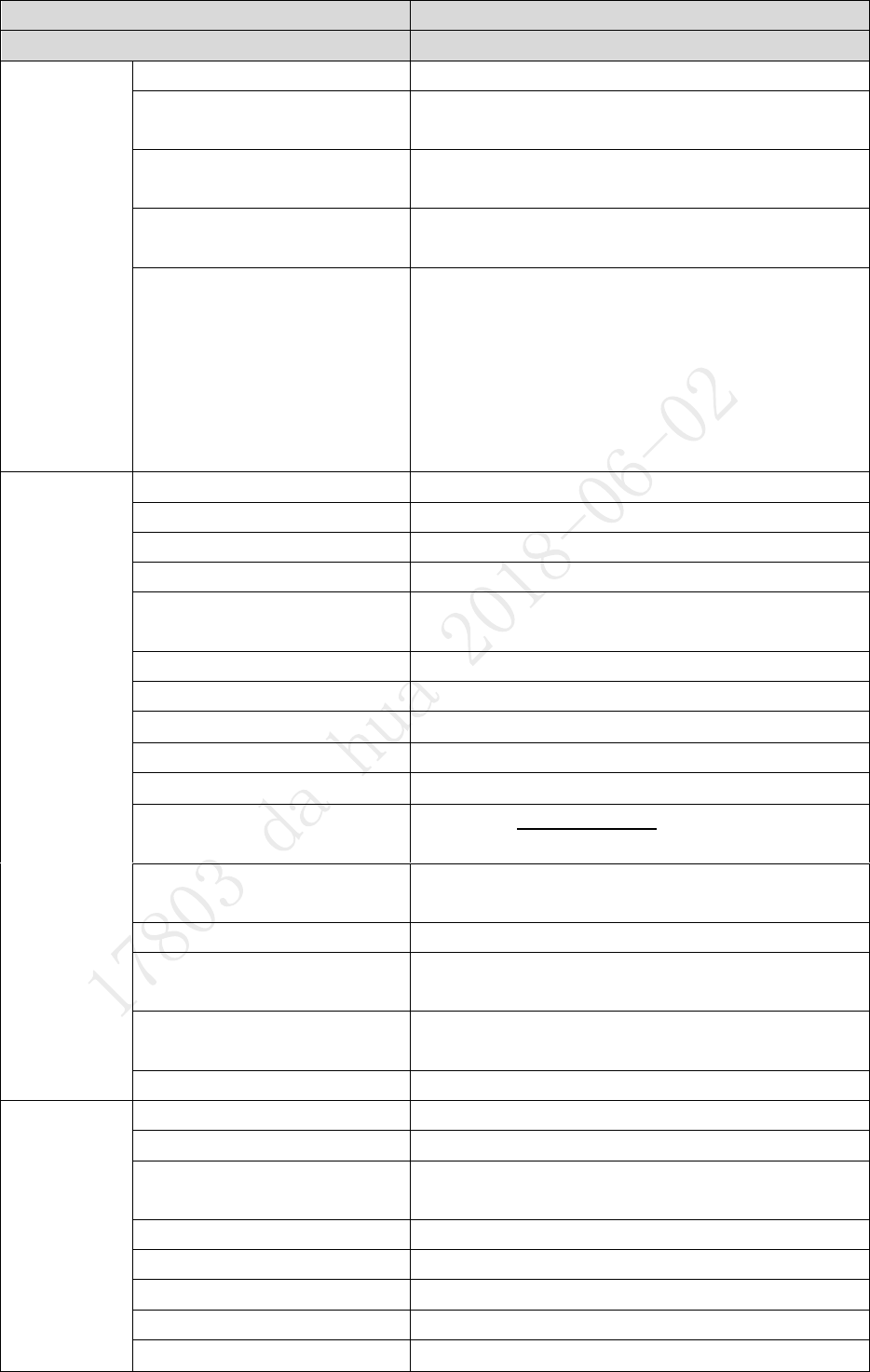
83
Parameter Item
Parameter Value
Model
Navigator X1100
Angle control accuracy
±0.01°
Max. controllable rotation
speed
Course: ±130°/s
Pitch: ±130°/s
Controllable rotation range
Course: ±168°
Pitch: -90° to +45°
Installation mechanical
feature
Quick mount and demount
Built-in function
Two working modes:
Course follow mode
Attitude lock mode
Built-in independent IMU module
X1100 exclusive servo drive module
Ethernet video transmission and camera PTZ
control
Visible Light
Camera (2
MP, 30X
optical
zoom)
Sensor
1/1.8” 3Mp CMOS
Max resolution
1920(H)×1080(V)
View angle
67.8°~2.77°
WDR
≥100dB
Video compression
standard
H.264/H.265/MJPEG
Frame rate
30fps@5M/3M,60fps@1080p
Iris
F1.6~F4.4
Focal length
4.5mm~135mm (30x optical zoom)
Digital NR
3D
SNR
≥55dB (AGC Off, Weight ON)
Min illuminance
Color: 0.005Lux@F1.6
Black and white: 0.0005Lux@F1.6
Backlight compensation
mode
BLC/HLC
Day/night switch
Auto/Manual
WB
Auto/Manual/Tracking/Outdoors/Indoors/Outdoors
Auto/Sodium Lamp Auto/Sodium Lamp
Electronic shutter
Support auto electronic shutter (1/3~1/30,000s),
manual electronic shutter (1/3~1/30,000s).
Storage
128GB Micro SD
Thermal
camera
(temperature
measuring
type)
Detector type
Uncooled vanadium oxide focal plane detector
Detector pixel
640×512
Video coding
H.264M/H.264H/M-JPEG, support 720P image
output
Pixel size
17μm
Spectral range
7.5μm~13.5μm
Thermal sensitivity
≤40mK
Lens focal length
19mm
Distance (human:
640m, 160m, 80m
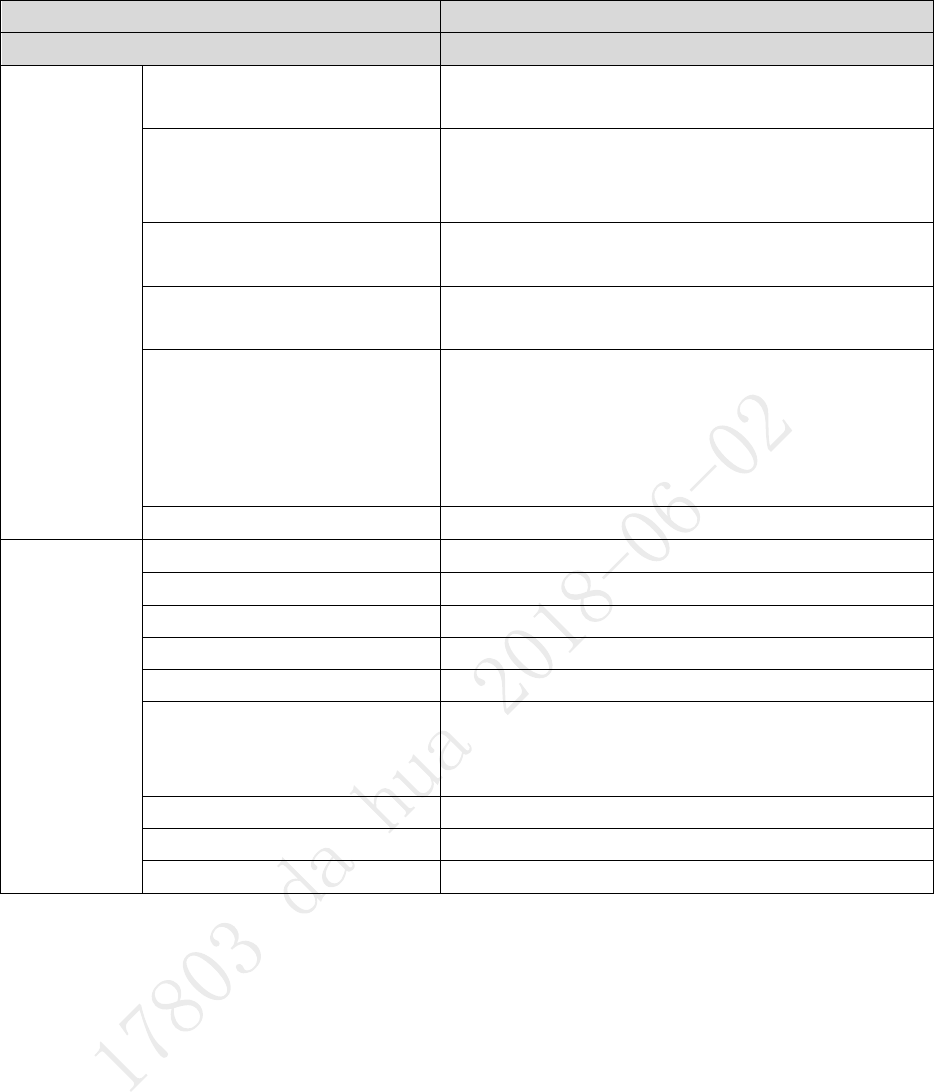
84
Parameter Item
Parameter Value
Model
Navigator X1100
1.8m*0.5m, detection,
recognition, identification)
Distance (vehicle:
2.3m*2.3m, detection,
recognition, identification)
2000m, 500m, 250m
Temperature measuring
range
Low temperature mode: -40°C to 160°C. High
temperature mode: -40°C to 550°C
Temperature measuring
error
Max(±2℃,±2%)
Temperature measuring
function
Support real-time multi-preset temperature
measuring, temperature alarm, temperature
correction, temperature measuring unit setting,
temperature real-time analysis, historical
temperature information query and so on.
Storage
128GB Micro SD
Integrated
remote
control
Features
Integrated design of remote control display
Remote control distance
≥5km
Remote control dimension
350mm×228mm×85mm
Battery
2S LiPo,7800 mAh
Output port
micro USB, headset port
Operating screen and
system
Screen size: 7” (Multi-point capacitance)
Resolution:1024*600
OS: Android 5.1
Network
WiFi IEEE802.11 b/g/n
Storage
16GB Micro SD
Protocol
GB/T 28181
Appendix Table 1-1
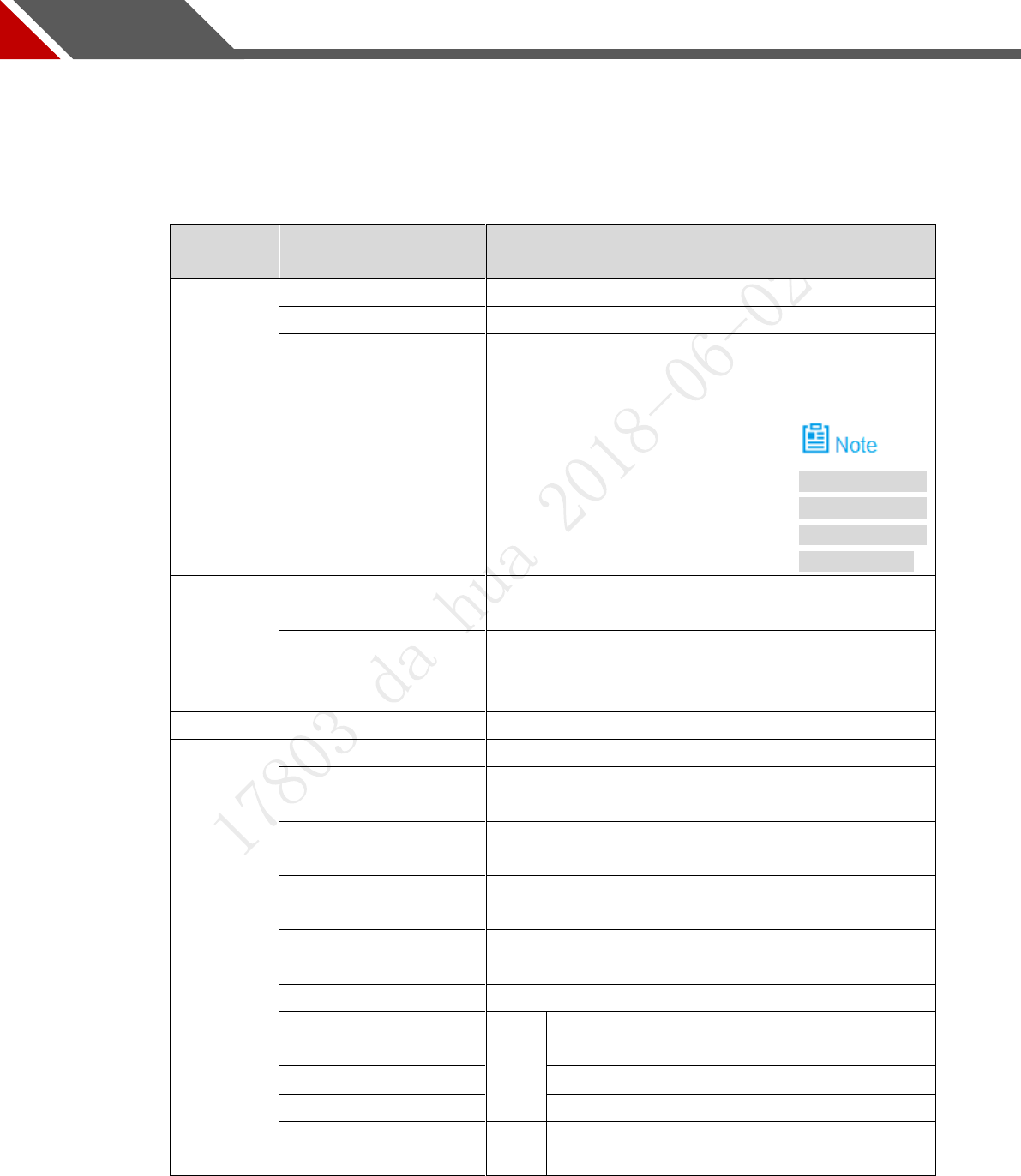
85
Aircraft State Indicator Appendix 2
The aircraft status indicator over the power switch is turned on after the aircraft is enabled.
Different colors and statuses mean differently. Please refer to the Appendix Table 2-1.
Please do understand the contents listed in the table below before flight, which is to help you
quickly understand the aircraft status or positioning problem during flight. The actual operation
methods will be specifically introduced in other chapters.
Phase
Indicator color and
status
Implication
Operation
Startup
●●● ●●● ●●●…
Self-check and preheating
Wait
●Normally on
System self-check report error
-
● ● ●…
Aircraft in no-fly zone
Move the
aircraft out of
no-fly zone.
Please refer to
“3.8 Check and
Debugging” for
the flight area.
Compass
calibration
●Normally on
Horizontal calibration of compass
Wait
●Normally on
Vertical calibration of compass
Wait
●● ●● ●●…
Calibration failure of compass
Manually
calibrate
compass
Pair
●Normally on
Pairing success
-
Flight
● ● ●…
Take off normally
-
●Flash once
fixed point mode and satellite
number≥6
-
●Flash twice
fixed point mode and satellite
number<6
-
●Flash once
Intelligent mode and satellite
number≥6
-
●Flash twice
Intelligent mode and satellite
number<6
-
●Flash once
Fixed altitude mode
-
●●● ●●● ●●●…
-
Disconnected from remote
control for more than 3s
-
●●● ●●● ●●●…
Level 1 low battery warning
-
●●●● ●●●● ●●●●…
Level 2 low battery warning
-
●●●● ●●●● ●●●●…
-
Disconnected from remote
control for more than 3s
-
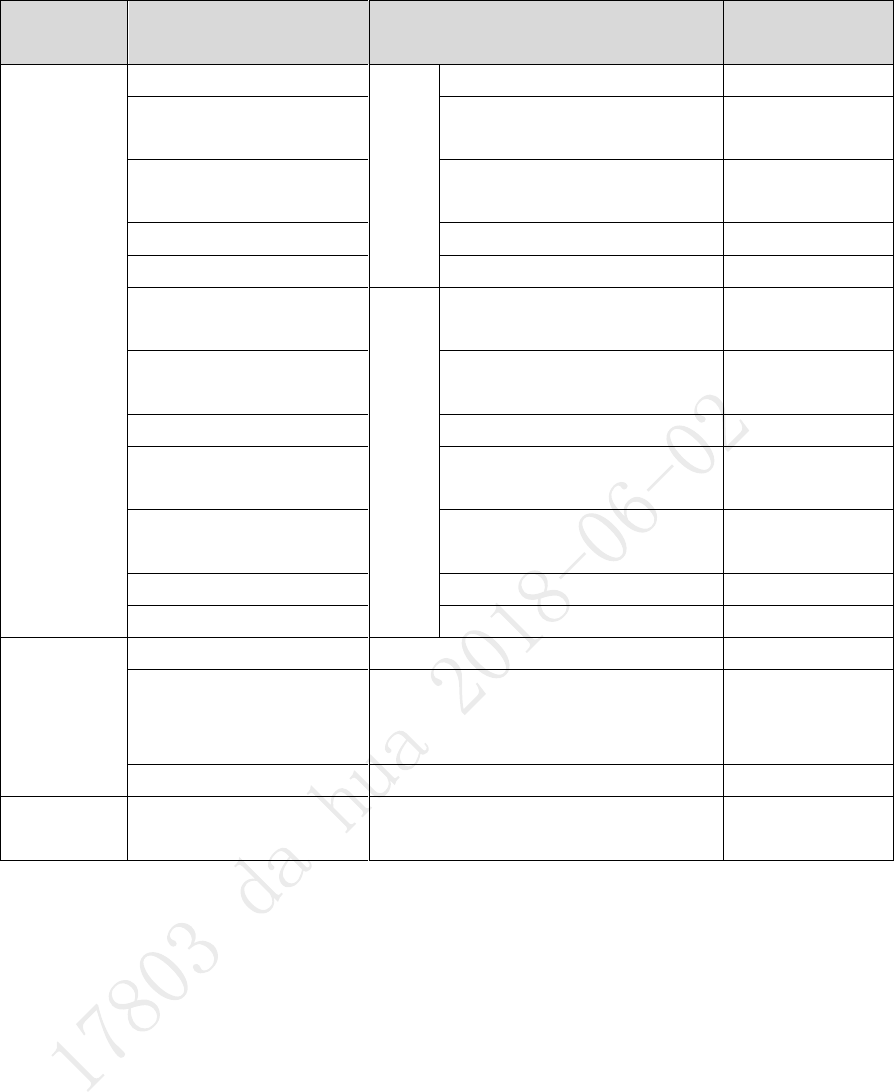
86
Phase
Indicator color and
status
Implication
Operation
●●●● ●●●● ●●●●…
Level 1 low battery warning
-
●●●●● ●●●●●
●●●●●…
Level 2 low battery warning
-
●●● ●●● ●●●…
Disconnected from remote
control for more than 3s
-
●●● ●●● ●●●…
Level 1 low battery warning
-
●●●● ●●●● ●●●●…
Level 2 low battery warning
-
●●● ●●● ●●●…
Retu
rn
Image transmission
disconnected
-
●●●● ●●●● ●●●●…
Disconnected from remote
control for more than 3s
-
●●●● ●●●● ●●●●…
Level 1 low battery warning
-
●●●●● ●●●●●
●●●●●…
Level 2 low battery warning
-
●●● ●●● ●●●…
Disconnected from remote
control for more than 3s
-
●●● ●●● ●●●…
Level 1 low battery warning
-
●●●● ●●●● ●●●●…
Level 2 low battery warning
-
Firmware
upgrade
●● ●● ●●…
Firmware upgrade in progress
Wait
●Normally on
Upgrade failed
Check upgrade
step. Upgrade
again
●Normally on
Upgrade succeeded
-
Lose
efficacy
●Flash for three times
Any sensor loses efficacy and any
abnormal forced landing events
-
Appendix Table 2-1
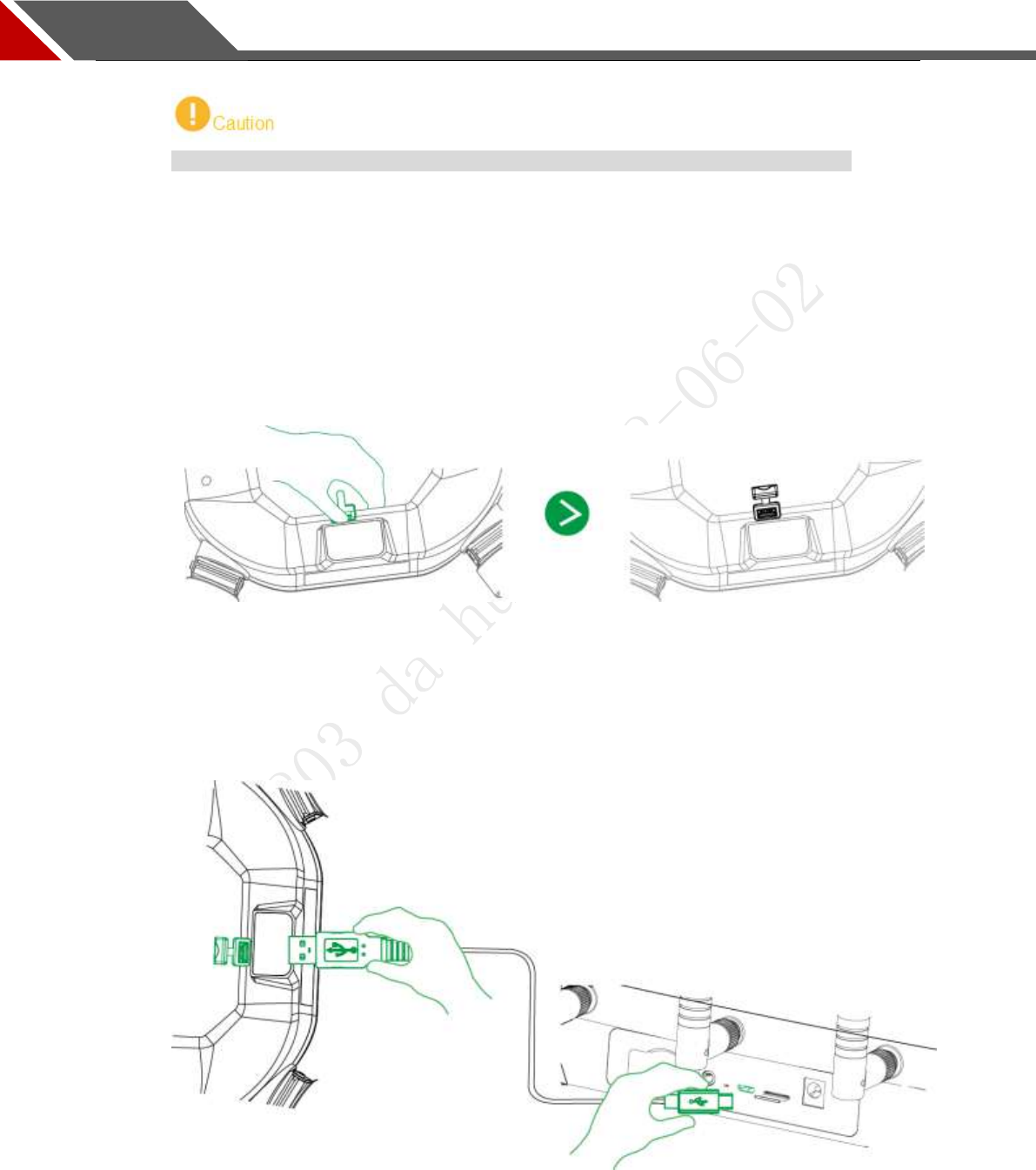
87
System Pairing Appendix 3
The frequency of aircraft and remote control has been paired before factory delivery.
Abnormity
It needs to pair again when the remote control relation between remote control and aircraft
loses effect.
Specific Operations
Open silicone cover of USB port of the aircraft. Step 1
Appendix Figure 3-1
USB2.0 port at the other end of data cable shall be inserted into USB port of the Step 2
aircraft.
MicroB port of data cable shall be inserted into Micro USB port of the remote control. Step 3
Complete connection of the aircraft and remote control, as shown in Appendix Figure
3-2.
Appendix Figure 3-2
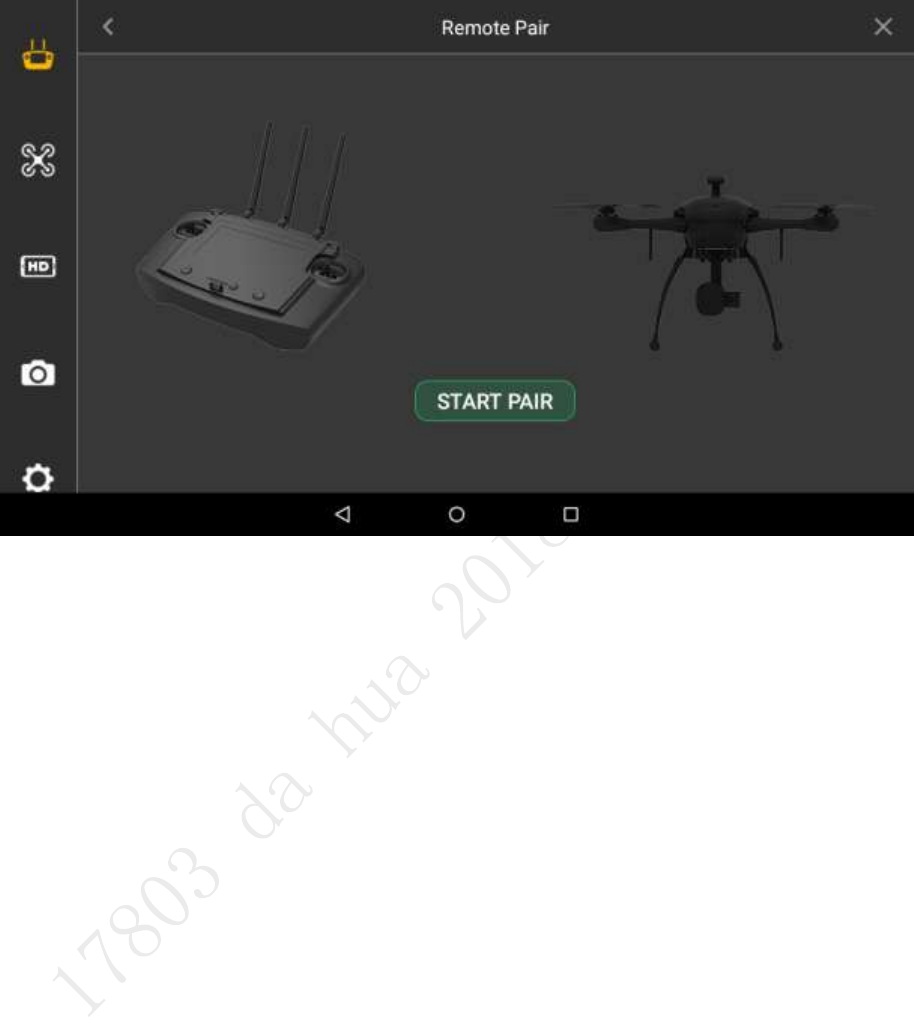
88
Select “Settings > Remote Control Settings > Remote Pair” on the remote control. Step 4
The system displays the interface of “Remote Pair”, as shown in Appendix Figure 3-3.
Appendix Figure 3-3
Click “Start Pair” on the remote control, and the system starts pairing automatically. Step 5
It means pairing is successful when the remote control prompts “Success”. Step 6
If the interface prompts pairing failure, click “Retry” and repeat above step 1-4. Step 7

FAQ Appendix 4
Appendix 4.1 FAQ and Solutions of Aircraft
Question: Images are subject to water ripple and jitter in case of gale.
Solution: Prevent PTZ from facing the gale directly.
Appendix 4.2 FAQ and Solutions of Remote Control
Question: Response speed of remote control touch screen becomes slow and has other
abnormities.
Solution: Restart the remote control with power switch at the back of remote control. Please
timely contact the supplier if it is not improved.
Appendix 4.3 FAQ and Solutions of Airborne Device
Question: Recorded video loss (including failure to copy data from micro SD card).
Solution: Check the aircraft version. Please contact the supplier if the version is too low.
Appendix 4.4 FAQ and Solutions of Charger
Question: Charger displays error prompts: ERR1 (Starting Connection Error), ERR2 (Current
Abnormity Protection), ERR3 (Balance Port Fault), ERR4 (AC Input Fault) and
ERR5 (Charging Connection Error).

Solution: Please inspect whether connection between AC power line and charger, or
connection between charger and battery is abnormal or not. Please contact the
manufacturer if it fails to be solved.
ZHEJIANG DAHUA VISION TECHNOLOGY CO.,LTD.
Address: No.1199, Bin’an Road, Binjiang District, Hangzhou, P.R. China
Postcode: 310053
Tel: +86-571-87688883
Fax: +86-571-87688815
Email:overseas@dahuatech.com
Website: www.dahuasecurity.com

